The COVID-19 Economic Impact: a Trade Show Promoter’s Perspective
by Mike Kent
"If you can keep your head when all about you are losing theirs...." is the opening line of the immortal poem "If" by Rudyard Kipling. Published in 1910 and still relevant today, it is often touted as an inspirational work that provides advice on how one should live their life and gives encouragement to rise above the many adversities we all face at some point in time. As members of the human race, and a much smaller subset consisting of Civil War enthusiasts, National and State Parks, museums, collectors, dealers, seminars, tour companies, sutlers, living history presenters, and reenactors, we might all benefit by taking a few minutes to read and digest "If."
With the outbreak of COVID-19, known as the Coronavirus, in the United States since late February, life has changed to some degree for all of us. Isolation or self-quarantine is prevalent and mandated in some locations. Necessities such as food, water, pharmaceuticals and yes, even toilet paper, are harder to find and in short supply.
Certain industries are facing massive layoffs, or work from home situations, and no one is sure when the virus may be contained or when life can return to normal.
Statistics, predictions, opinions, facts, and lies are inundating us 24 hours a day via TV and social media, often from talking heads, celebrities, and politicians with little or no factual information about the situation. Everyone seems to have an agenda to push during this crisis; few of them offer solutions for the average American. While each of us is obviously concerned with our own situation during this outbreak, it may be helpful if we step back and take a look at how other people and businesses are impacted as well. My recent experience is probably very similar to the many readers who collect, deal, and participate in Civil War events around the country.
On March 15, I was notified that my gun show scheduled for Columbia, S.C., on March 21st and 22nd had been cancelled by the state fair board. While financially concerning to me, I couldn't help but think of the hundred plus vendors who had stocked up on merchandise in preparation for the show only to have no place to sell it for the foreseeable future.

It was then that I began to realize the staggering impact an event’s cancellation could have in any industry, especially when you take into consideration the thousands of shows, festivals, sporting events, and gatherings occurring in this country every weekend.
To put things in perspective, consider the following list of businesses and individuals who did not receive any income due to the cancellation of my small, 400 table gun show:
• The venue I rent for my show.
• The event services company that provides tables and chairs.
• The off-duty police officers who provide security.
• The ATM company that provides banking services.
• The concession company

that feeds the vendors and attendees.
• The individuals employed to sell tickets and inspect firearms.
• The temp labor company that provides workers who assist vendors moving in and out.
• The temp laborers themselves.
• The parking lot attendants.
• The hotels and restaurants, where I and a large number of vendors, stay and eat for 3 days and nights.
• The hotel and restaurant staff. The National Restaurant Association recently predicted that restaurants across the country will lose $225 billion in business over the next three months, and that five to seven million service and kitchen jobs could be lost over the same period.
• The gas station where I fill up and get my coffee every morning along with all the vendors and participants who
attend the event.
• The media outlets that run my ads: radio, TV, billboard companies, digital advertising, and newspapers.
• The advertising agency that creates and places my ads.
• The city that charges me for a temporary business license.
• The state that charges me an admission tax.
• The pet sitter who feeds my dog and cats.
Now imagine that in each of the situations listed above, there is a business owner, manager, or employee who can diagram a similar chart of affected entities under their control. When analyzed from this perspective the economic toll being taken by the Coronavirus panic can seem overwhelming.
The other part of the Coronavirus equation is obviously its health-related impact, which is concerning, but not the magnitude of the bubonic plague that killed an estimated 50
million people, 60 per cent of the European population, in the 14th century. To put things in perspective, here are a few statistics on more recent epidemics, courtesy of the CDC (cdc.gov).
• The Spanish flu of 1918–1919 infected an estimated 50 million people worldwide with 675,000 deaths in the U.S.
• The SARS outbreak of 2003 infected 8,098 people worldwide with 774 deaths, but none in the U.S.
• The Ebola scare of 2014 registered 11,325 deaths worldwide, with only 1 reported death in the U.S.
• The H1N1 influenza epidemic of 2009 resulted in an estimated 60 million infections in the U.S., 274,000 hospitalizations, and 12,469 deaths.
• Throughout the most recent flu season from October 1,
CW N Vol. 46, No. 5 48 Pages, May 2020 $3.50 Civil War News America’s Monthly Newspaper For Civil War Enthusiasts Inside this issue: 47 – Advertiser Index 27 – American Battlefield Trust 22 – Ask the Appraiser 10 – Black Powder White Smoke 38 – Book Reviews 44 – Central Virginia BT 34 – Emerging Civil War 2 – Events Section 26 – The Graphic War 28 – Inspection, ARMS! 4 – Letters to the Editor 6 – Round Table News 20 – The Source 16 – The Unfinished Fight 32 – This And That 24 – Through The Lens 14 – Trivia H COVID-19 . . . . . . . . . . . . see page 7
Mike Kent’s Richmond Civil War Show. This type of event has been canceled throughout most of May. Fortunately, this show is Nov. 14 & 15, 2020.
Civil War News
Published by Historical Publications LLC
520 Folly Road, Suite 25 PMB 379, Charleston, SC 29412
800-777-1862 • Facebook.com/CivilWarNews mail@civilwarnews.com • www.civilwarnews.com
Advertising: 800-777-1862 • ads@civilwarnews.com
Jack W. Melton Jr. C. Peter & Kathryn Jorgensen
Publisher Founding Publishers
Editor: Lawrence E. Babits, Ph.D.

Advertising, Marketing & Assistant Editor: Peggy Melton
Columnists: Craig Barry, Joseph Bilby, Matthew Borowick, Salvatore Cilella, Stephanie Hagiwara, Gould Hagler, Tim Prince, John Sexton, and Michael K. Shaffer
Editorial & Photography Staff: Greg Biggs, Sandy Goss, Michael Kent, Bob Ruegsegger, Gregory L. Wade, Joan Wenner, J.D.
Civil War News (ISSN: 1053-1181) Copyright © 2020 by Historical Publications LLC is published 12 times per year by Historical Publications LLC, 520 Folly Road, Suite 25 PMB 379, Charleston, SC 29412. Monthly. Business and Editorial Offices: 520 Folly Road, Suite 25 PMB 379, Charleston, SC 29412, Accounting and Circulation
Offices: Historical Publications LLC, 520 Folly Road, Suite 25 PMB 379, Charleston, SC 29412. Call 800-777-1862 to subscribe.
Periodicals postage paid at U.S.P.S. 131 W. High St., Jefferson City, MO 65101.
POSTMASTER: Send address changes to: Historical Publications LLC 520 Folly Road Suite 25 PMB 379 Charleston, SC 29412
Display advertising rates and media kit on request.
The Civil War News is for your reading enjoyment. The views and opinions expressed herein are those of its authors, readers and advertisers and they do not necessarily reflect the official policy or position of Historical Publications, LLC, its owners and/or employees.
P UBLISHERS :
Please send your book(s) for review to: Civil War News
520 Folly Road, Suite 25 PMB 379 Charleston, SC 29412
Email cover image to bookreviews@civilwarnews.com. Civil War News cannot assure that unsolicited books will be assigned for review. Email bookreviews@civilwarnews.com for eligibility before mailing.
ADVERTISING INFO:
Email us at ads@civilwarnews.com Call 800-777-1862
MOVING?
Contact us to change your address so you don’t miss a single issue. mail@civilwarnews.com • 800-777-1862
SUBSCRIPTION RATES
U.S. Subscription rates are $38.50/year,
Coronavirus (COVID-19)
Historical Publications LLC (Civil War News and The Artilleryman Magazine) wants to keep you informed of our commitment to providing you with information about how we are handling the latest news surrounding the Coronavirus (COVID-19). While events may change daily, the health, safety, and welfare of our advertisers and contributors are of the utmost importance to us. We are doing all we can to make sure we are available to you during this time.
Whether you choose to visit our websites at www.civilwarnews. com, www.artillerymanmagazine.com or www.historicalpubs. com, or call us at 800-777-1862, we are doing everything possible to serve you. We are following the guidance and recommendations provided by the Centers for Disease Control (CDC) and the South Carolina Department of Health to ensure that we are prepared.
As an essential business, we will continue to operate during our normal business hours. While we have no control over how the USPS will continue timely service in response to COVID-19 and heavily affected areas, we are committed to publishing Civil War News and The Artilleryman Magazine on time, every time. With patience and perseverance, we will all weather this storm together.
Book Reviewers Needed
If you are publisher or author and want to submit your book for review, please email bookreviews@civilwarnews.com to make sure that your publication meets the eligibility requirements before mailing it to:
Civil War News
520 Folly Road Suite 25 PMB 379 Charleston, SC 29412
If you would like to be a member of our elite book review staff, please contact us at bookreviews@civilwarnews.com for details.
Kudos to Joe Bilby
Mr. Bilby,
For the last several years our family has vacationed in Spring Lake, New Jersey. On several of these occasions we have visited the New Jersey National Guard and Militia Museum. I especially,
enjoy walking through the many interesting exhibits both inside and outside. On one such visit as exiting the museum I noticed a copy of Civil War News on the window sill. It had your name on the address label. I want to thank you for leaving the paper there as I thoroughly enjoyed reading it from front to back I have always had an interest in the American Civil War and this publication is far and away better than anything else I have ever read. I look forward to each issue as I have become a subscriber these past few years. So thanks again for introducing a museum visitor to a wonderful publication.
I would also like to know if you could recommend a book or two on Joshua Chamberlain. I see that there are many out there and would appreciate if you could direct me to ones that you have found to be interesting works. Thank you for your time and consideration.
All the best to you and CWN.
Joseph Natoli
Publishers:
Civil War News
520 Folly Road, Suite 25 PMB 379 Charleston, SC 29412
bookreviews@civilwarnews.com
Due to the spread of Covid-19, Civil War News has made the tough decision to temporarily suspend the free Calendar Events section until gathering bans have been lifted and the authorities have confirmed that it is safe to resume public group activities. We apologize
for any inconvenience, but as always, Historical Publications LLC will continue to prioritize the health and safety of our subscribers, contributors, and advertisers. We are all feeling the effect of these unprecedented circumstances.
We are asking that event
coordinators please reach back out to us with your updated information when all gathering bans have been lifted in your area so that we may include your new event dates and info for publication.
Email us at: ads@civilwarnews.com.

2 Civil War News May 2020
$66/2 years, digital only $29.95, add digital to paper subscription for only $10/year more. Subscribe at www.CivilWarNews.com
Send your book(s) for review to:






Letters Editor to the
To the Editor:
While I appreciate the praise from Thomas Ryan in the April edition of the Civil War News, the expansion goes a bit farther than I intended in the article. I am aware of the capture of the signal station at Emmitsburg and it will form the basis of a future article. The two officers captured spent most of the war in Confederate prisons. The defense at Williamsport refers only to that of July 5-6, 1863. When General Lee arrived, he extended the line five miles to Falling Waters. Stuart’s cavalry and Imboden’s makeshift defense saved the Confederate wagon

train on the sixth. From then on, what was left of the entire army was involved.
Carl Sell
To the Editor: HEADLINE – “MYTH: .... African American Soldiers Fought for the Confederacy.”
It’s a MYTH, but there is a photograph of an African American man right beside the headline in full Confederate uniform brandishing a pistol, a bowie knife, and a double barrel shotgun.
Mr. Coski’s article also plainly states that the Confederate Army “formally enlisted hundreds of (African American) cooks and musicians who were paid.” And, the article goes on to state that they even received pensions for their war time service.
So, let’s see, we’ve got men that were “formally enlisted,” men who were “paid” as soldiers, and men who received a “pension” for their war time service. And, heck, on top of that, we have
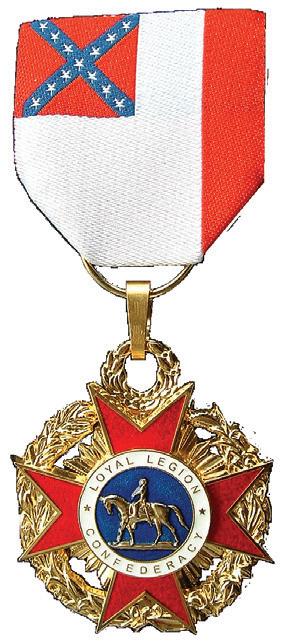
photographic proof of African Americans in Confederate uniforms with weapons of war. This article is just further evidence of the kind of historical elitism that is so prevalent today. The author of this article is saying in essence, “Don’t believe what you plainly see, don’t believe what has been historically documented, or what you know to be the truth. Instead, “Believe What I Tell You!”
Mr. Coski’s attempt to prove that African Americans did not serve willingly as soldiers, only proved that they did. Just because they served as “cooks and musicians” or in some other supportive role, did not make them any less than soldiers. In any army, those who have supportive roles far outnumber. those who pull the trigger and their service is just as important and essential. I dare Mr. Coski to tell any veteran today who served in these capacities that they were not soldiers.
I suggest that Mr. Coski read the history of the 7th Tennessee
Cavalry Regiment. In this regiment alone, dozens of black men served under General Forrest in his escort company as soldiers who fought like tigers. You can read about them in Michael R. Bradley’s book, Nathan Bedford Forrest’s Escort and Staff. You will also find in J.P. Young’s book, The Seventh Tennessee Cavalry, A History, African American men included on the roster list of several companies. Some of these roster lists have a separate listing for the black soldiers who served, and some are listed without any reference to their skin color.
I don’t usually respond in this manner to written articles of this type, but this one is so blatantly and outrageously wrong that I felt compelled to come to the defense of these brave African Americans who fought and died to defend their homeland and their families from an invading army that seemed bent on their total destruction. In West Tennessee and across the South, homes were
Legion
pillaged and burned, women raped, and family members murdered—both white and black. That is the historical record. It seems only logical that thousands of African American men would willingly respond by standing with the Confederacy.
Rex Brotherton Hickory Valley, Tenn.
To the Editor:
Response to Myth of the Black Confederate Soldier.
I am responding to Jack Melton’s request in the March issue. I am an amateur historian who feels qualified to claim to be an expert on the Civil War at Sea.
A few years ago I searched the available records for black officers in the Confederate Navy and found the following three:

Moses Dallas: KIA while cutting out the USS Water Witch, there are two identical historical markers about him, one in Savanna and one in Columbus, This link, https://www.hmdb. org/m.asp?m=101347, is to the one in Columbus and includes everything we know about him. I don’t know this for a fact, but I think the text was written by Greg White.

William Bugg: He disappeared and was listed as a deserter; I was unable to find any trace of him in the Federal Navy and think the deserter assumption is suspect.
William Jones: Discharged for medical reasons.
All three were pilots; pilots both white and black were considered to be officers, however, they did not have commissions or warrants and were not eligible for command. I always like to point out that there wasn’t a black officer, of any sort, in the Federal Navy until 1944.
My research on these officers was donated to the Atlanta History Center Archive and is included in their collection as “Personality Files.”
I am a retired architect and continue to pursue my interest in history which started after my first visit to Gettysburg in 1952, I was nine.
Bill Dyer
4 Civil War News May 2020
CSA National Defense Medals & other banned internet items Civil War Recreations WWW.CWMEDALS.COM cwmedals@yahoo.com 1 Smithbridge Rd., Unit 61, Chester Heights, PA 19017 Letters to the Editor: Please email: mail@civilwarnews.com Civil War News 520 Folly Road, Suite 25 PMB 379 Charleston, SC 29412
Loyal
of the Confederacy
Civil War Trails, Inc. has teamed up with the Hardy County Convention & Visitors Bureau (HCCVB) and the South Fork General Store to bring the popular program to Peru. The HCCVB will sustain the signage through maintenance and marketing efforts. Located at the eastern end of the bridge in the small community of Peru, the sign is being
Civil War Trails Expands in Hardy County, W.Va.
hosted by the South Fork General Store located at 111 Peru Hollow Road, Milam.


The Civil War Trails program connects visitors to more than 1,200 sites across six states. The program’s signature signs bring the modern landscape to life as visitors stand in the footsteps of soldiers, citizens, and those fighting to gain their freedom. Every Civil War Trails site is marketed internationally by state tourism offices, destination marketing organizations, and municipal partners.
The program continues to experience record visitation providing a strong return on investment and revenue for local jurisdictions.
“Our program is experiencing our youngest audience to date,” said Drew Gruber, Executive Director of Civil War Trails. “Places off the beaten path and personal stories are exactly what our visitors are after and you can’t get this particular story anywhere else in the world but Peru, W.Va.”
“Various Hardy County locations changed hands numerous times during the War adding to the



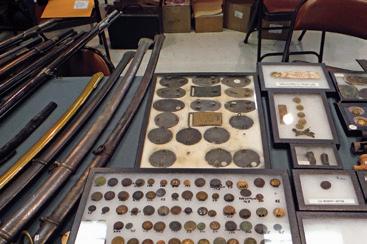

complex history for our region. Currently home to nine Civil War Trails Markers documenting skirmishes, troop movements, historic buildings, and sites, Hardy County’s history is linked to other sites across participating states,” said Michele MoureReeves, HCCVB Director. “We welcome visitors and residents alike to explore our county’s role in the Civil War by using the educational trail markers to gather historical information and better understand the impact the Civil War had on our county, state, and country.”
“West Virginia’s statehood is a direct result of the Civil War, which makes our many trails, battlefields, and reenactments an important part of our tourism industry,” Tourism Commissioner Chelsea Ruby said. “We continue to see interest from visitors looking to experience our rich history, and thanks to the support of the Civil War Trails organization, we’re able to mark and promote these stops to new travelers every day.”
A new West Virginia Civil War Trails map is currently under development and Civil War Trails
has launched a GPS enabled page on their website to aid visitors in their quest to find these sites (civilwartrails.org). For more information go to the ‘History Buff’ page of the Hardy County Convention & Visitors Bureau website (visithardywv.com), or call the HCCVB at 304-897-8700 or the Civil War Trails, Inc. at 757-378-5462. Connect with us on social media @civilwartrails

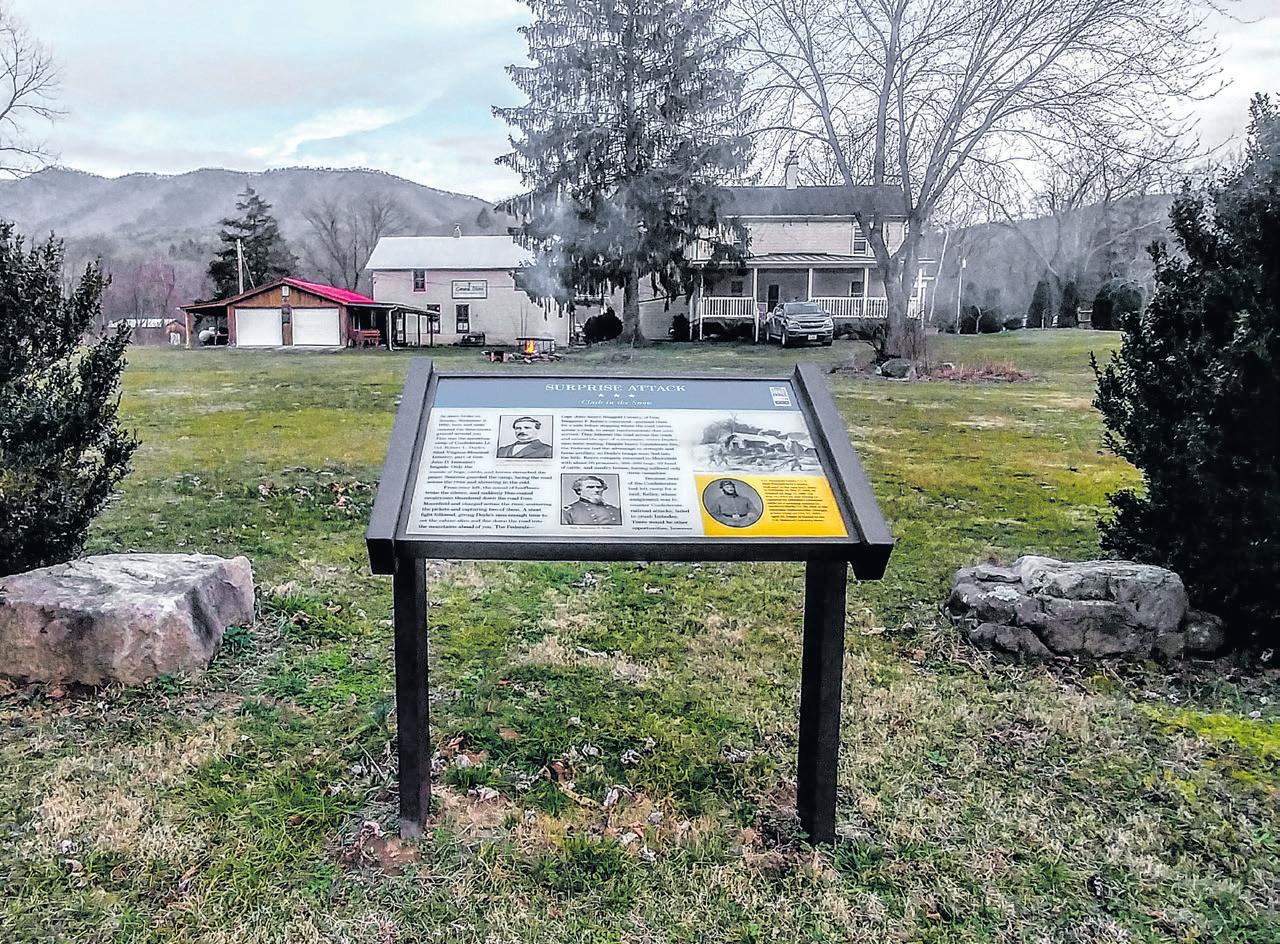
#openairmuseum @visithardy
#almostheaven #visithardy
Visitors to the site today will find a landscape largely unchanged since the battle as well as the South Fork General Store, a popular shop for locals, cyclists, and road trippers.
5 May 2020 Civil War News Subscribe online at CivilWarNews.com
W.Va., Civil War Trails marker. American Digger Magazine’s 3rdAnnual Chattanooga Civil War & Artifact Show & Sale July 25-26, 2020 Camp Jordan Arena 323 Camp Jordan Parkway East Ridge, TN 37412 Dealer Setup: Friday 12-7 PM Sat. 7-9 AM Sales and display tables featuring: americandiggerevents.com Swords & Knives Antique Firearms Dug & Non-dug Civilian Items Jewelry & Bottles Stone Artifacts Art, Photographs, & Books Militaria & Americana All Eras to WWII Metal Detectors & Equipment Door Prizes Awards Open to Public: Saturday: 9-5 Sunday: 9-3 200+ Tables Buy/Sell/Trade/ Browse/Display For information: (770) 362-8671 or (716) 574-0465 anita@ americandigger. com Buy!Sell! Display!Trade!
Peru,
Roundtable news
Brunswick Civil War Round Table
A standing ovation at Hatch Auditorium


Union Generals William Tecumseh Sherman and Ulysses
S. Grant received a standing ovation from a near capacity audience of 597 following their performance at the Tuesday, March 3, meeting of the Brunswick Civil War Round Table at Hatch Auditorium on Caswell Beach. The generals were played by associate professors Derek Maxfield and Tracy Ford of Genesee College in Batavia, N.Y. They staged a three-act play, entitled “Now We Stand Together Always.” Accompanying the generals was Jess Scheuerman, a librarian at Genesee who set the stage for the program, and before each act. Their performance was part of the Round Table’s series of monthly meetings featuring renowned Civil War historians, authors, and college professors from around the country, with a goal of educating and entertaining everyone, not just Civil War enthusiasts.
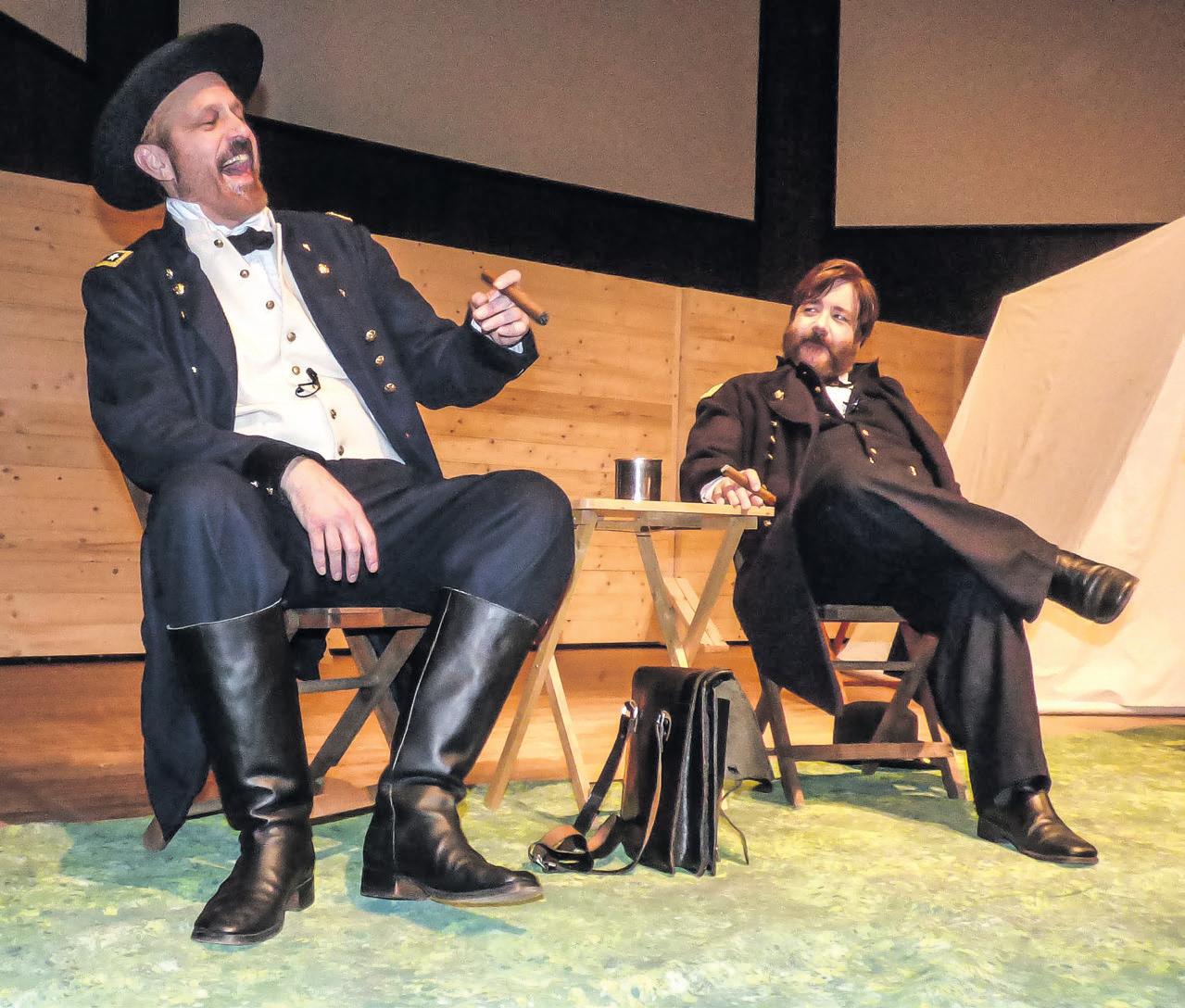
Backstage, both Maxfield and Ford were overwhelmed by the size of what promised to be a large and receptive audience. It was the Round Table’s second largest audience ever! A shocked Tracy Ford explained, “Most of the Civil War round tables we perform at have about 40 or 50 in the audience. At one Civil War function we had close to 200. This three-act play will be performed tonight to our largest audience, ever!”

The evening’s performance was complete with stage props, military uniforms, and an adequate supply of bourbon (i.e., a liter of unsweetened tea) primarily
consumed by Sherman as he conversed with Grant in each act.
Act I took place in Vicksburg, Miss., mid-June, 1863, where they discussed ways to overcome Confederate control of the Mississippi River. Act II took place in a Cincinnati, Ohio, hotel room during March 1864, where, despite Sherman’s frequent sips of bourbon, serious discussions ensued on how to end the war. The final act took place at City Point, Va., in March 1865. This meeting focused on a plan to finally close out the war. During every act, the audience was treated to a unique theatrical performance based on historical facts, recollections of past battles, Sherman’s opinions of generals under Grant’s command, Sherman’s periodic outbursts, and clever interjections of sobriety as well as wit and humor.
Their goal at every performance is to bring these three critical phases of the Civil War to life. As Derek Maxfield explained, “we felt as actors we could better communicate important strategic events during the Civil War that would help create a sense of reality for our college students, in addition to reading about these events in a two-dimensional way in a Civil War history book.” To their surprise, several years ago when they began performing for their students, word spread about their program format. They began to receive invitations from Civil War-related organizations and round tables. Once word of their unique program format reached Brunswick Round Table president Mike Powell, it was clear in his mind that, “this would bring another educational, yet entertaining, dimension to our monthly guest speaker programs, and certainly create a totally unique experience for our members and guests.”
Everyone is invited to attend these monthly meetings. The visitor fee is $10, and can be applied toward the $25 annual membership dues. For more information about the Brunswick Civil War Round Table or the upcoming meeting, contact President Mike Powell at 910-278-3545, or email to mpowell260@gmail. com. The organization’s website is Brunswickcivilwarroundtable. com. You can also visit their Facebook page for interesting facts, comments and updates.
Note: We are approaching our 10th anniversary of the Round Table this coming June. Our growth over the years has been simply amazing, and we attribute our success primarily to meetings such as this one where our members and guests look forward to each month’s meeting knowing they will be informed and entertained. If you are as enthusiastic as I am about our organization’s success and believe it will make for interesting reading for your subscribers, please let us know. With 1,387 members, and still growing every month, we must be doing something right!
Many thanks again for your support of our Round Table. We are just so pleased with how we have grown over the years since our first meeting in May, 2010. So while it will be our 10th anniversary this June, we will delay that celebration until we are back on track, hopefully in September, without the need for hasmat suits, surgical masks, gowns, and gloves!
Deadlines for Advertising or Editorial Submissions is the 20th of each month.
Email to: ads@civilwarnews.com
6 Civil War News May 2020
Guest performers from left: Tracy Ford (Gen. Sherman), Derek Maxfield (Gen. Grant), and Jess Scheuerman, program announcer.
Gen. Grant in Act I pondering his upcoming meeting with Gen. Sherman in Vicksburg, Mississippi.
A tipsy General Sherman pontificating about the status of the war with General Grant.
An audience of almost 600 members and guests attended this special monthly program at Hatch Auditorium on Caswell Beach, N.C.
H COVID-19 From page

2019, until March 14, 2020, the CDC estimated between 38 million and 54 million Americans were infected with the flu virus that resulted in between 23,000 and 54,000 deaths.
During these past epidemics, including the most recent one just ended, do you remember a national shutdown? Do you remember a stock market crash?
Do you remember a president, governor, or mayor telling us we have to self-quarantine and social distance? Of course not; none of those things happened. We simply put on our big boy pants, washed our hands more frequently, didn't cough on others, stayed away from those who were sick, and used common sense. Guess what? We all survived and will survive Coronavirus as well. Now for the $64,000 question; what can we do in the face of this national catastrophe? The answer is simple:

• Stop, don’t panic, and take a deep breath.
• Improvise, adapt, and overcome (the unofficial slogan of the United States Marine Corps).
In our lives all of us have faced and overcome adversity whether it be a business failure, the loss of a loved one, or enemy fire in a hot zone overseas. Most of us are now older, wiser, and stronger for having met these challenges and persevered.

In times of trouble we tend to just do what we have to do to survive. Americans as a whole, and I think readers of this publication in particular, are emblematic of the can do attitude that has sustained this country since its founding. Rather than wringing our hands and seeking a safe space, we like to address problems head on, taking no prisoners until our goal is accomplished. By this time next year Coronavirus will be a distant memory. In the meantime, continue to fight the good fight, stay safe, and read "If" by Kipling.
See you at the next show!
Mike Kent is President of MK Shows which produces the Franklin, Dalton, and Richmond Civil War shows as well as numerous gun and knife shows in North and South Carolina. He has promoted over 400 shows during his 30-year career. Mike is a Georgia Tech graduate, holds an MBA from Georgia State University, is a member of the SCV and a NRA Life Member.
We hope that you will accept our invitation to advertise in the 26th annual July Gettysburg section of the Civil War News. This year we are printing 12,000 copies of the Gettysburg Edition, in full color, which will be mailed to Civil War News subscribers but also delivered to shops, lodging, restaurants, historic homes, Civil War dealers, auction houses, libraries, battlefield parks, and museums for free distribution in downtown Gettysburg. It will also be handed out at the Gettysburg Battlefield Preservation Association’s 47th Annual Civil War Show June 2728 and at the 157th Anniversary of the Battle of Gettysburg with battle reenactments, artillery
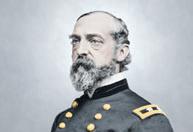

and cavalry demonstrations, living history programs, tours of the restored house and barn, and more! We are working on getting it distributed to other big venues in Gettysburg as well. The reenactment will be staged on the hallowed ground of the GBPA’s 146 – acre Daniel Lady Farm located on Hanover Road with a large reenactment field bordering the Gettysburg National Military Park at Benner Hill.
In addition to the Gettysburg Edition being free to the public in shops, restaurants, and other businesses in downtown Gettysburg. It will be available for free viewing online at CivilWarNews.com which has over 300,000 visitors per year. The online version will have clickable hyperlinks which will automatically redirect the reader to the advertiser’s website. The July issue will also be posted on the Civil War News Facebook page which has almost 75,000 likes.
Please contact us at 800-7771862 or email ads@civilwarnews. com for questions, a copy of our rate sheet which includes the pricing and ad size specs for this special issue, or to reserve your ad space. Deadline is May 20th for ad reservation and May 31st for materials deadline.
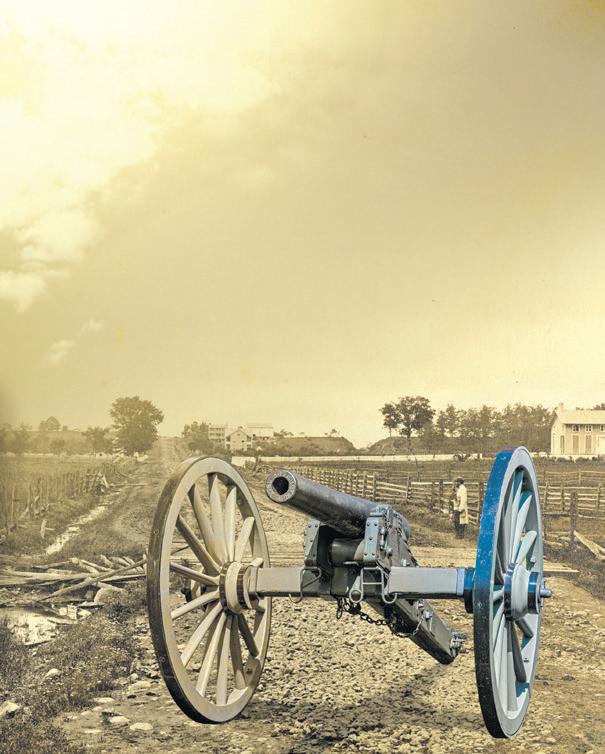
If you choose not to participate,
but are located in Gettysburg, and would like copies of the Gettysburg section to distribute, please contact me and I will make certain that you receive a box. We look forward to hearing from you!



7 May 2020 Civil War News LOST WITHOUT DISHONOR GETTYSBURG CONNECTIONS CAPTURED IN GETTYSBURG PARDONED FOR MURDER BOOK REVIEWS Courtesy of Civil War News FREE www.CivilWarNews.com INSIDE THIS ISSUE: 2019 July 2019 Civil War News 25th Annual Gettysburg Section Reynolds Battery L, First New York Light Artillery, assigned to the First Corps Artillery Brigade, Wainwright. Contract of July 24, 1861. It was delivered to the government Washington Arsenal Reynolds Battery Camp Barry. was in reserve, though under fire, at Cedar Mountain. The battery’s first engagement was at Rappahannock Station, where prominent part; had number battery, with another volunteer battery on their immediate right. Owing to the severe firing of the Rebels, the other battery their position until directed to retire by general officer. The battery was assigned to the First Corps, under General 1863, Capt. Gilbert H. Reynolds, Battery L, First New York Light Artillery, with six 3-inch rifled guns was directed by Col. there. Rebel cannon swept their an eye. Lt. George Breck took over the battery. Now Rebel infantry came storming in on the battery’s left, while Union under terrible shellfire and hail of bullets, leaving the guns exposed to the full weight of the attack. The guns were quickly limbered to pull out but the Close behind it came the Rebel yells; bullets whistled past. At last the pike was cleared; the infantry had swung off take and the bodies of the horses driver cut him out of the traces. collapsed, threshing about in welter of blood and tangled engagement, said, “There were occasions when gun could be lost with Honor, and Battery L’s loss after its gallant stand number. Later, Col. Wainwright wrote in his Journal of this gun’s loss, wished that it could have been must have shaken the rebel lines badly or they would have been upon us. The gun lost was No. 1, the first three-inch gun accepted Commission for the Battlefields of Gettysburg and Chattanooga. Final Report on the Battlefield of Gettysburg, 3 vol. Albany, Personal Journal of Colonel Charles Wainwright, Edited by Allen December 1968. Wartime photograph of Chambersburg Turnpike, Gettysburg, Penn. Mathew Brady is standing on the right side of the road. July 2019 Civil War News 25th Annual Gettysburg Section By Sue Boardman Some of the most rewarding moments in my guiding career ago. She lives in Alexandria, Va., and works for federal agency in Washington, DC. She came to program. As they watched the Gettysburg in preparation for her visit, Talbert mentioned that his grandmother’s cousin movie, James Longstreet. fact, Mr. Hughes mentioned that he met Helen Dortch Longstreet when he was boy aged or 10. in 1863. She was 34 when she married for the first and only time, to the much-older James Longstreet who was 76. As a Longstreet and Helen, described as charming and pretty, with blue eyes, blonde hair, and fair skin, exchanged vows in the parlor her husband, and history concurs. In 1902, she published Lee and Longstreet at High Tide: Gettysburg in the Light of the against critics who argued he failed to do his duty at Gettysburg. to the Gettysburg battlefield is Longstreet’s command launched the Longstreet Memorial Association during the 1938 reunion at Gettysburg. Their memorials raised to his memory. General Julius F. Howell, at Gettysburg were elected honorary Vice-Presidents of the Association. Helen Longstreet laid out for the placement of an equestrian monument to General Longstreet on the Gettysburg battlefield. model of the statue, eastern United States and wrote thousands of letters encouraging support for the monument. On July 1941, the general’s Gettysburg Connections dedicatingthesitefortheproposed from the Carlisle Army Barracks, troops from the 2nd Army Corps, fraternal and civic organizations Knights of Columbus, the Lions, the Elks, the Moose, the Eagles, and the Rotary. of anti-aircraft equipment along with military band and several colors. Flowers were dropped from an airplane over the site. Mary Kearny, granddaughter of General Phil Kearny. After addresses by National Park Service Superintendent Gettysburg National Military Park. Longstreet Supt. Coleman in center. (Gettysburg National Military Park) Longstreet Statue Model by Paul Manship. (Sue Boardman) spades of dirt were turned over to break ground for the monument. Playing of the Star-Spangled Sadly, the onset of World War derailed plans for the Longstreet monument at Gettysburg. Nevertheless, standing with connection “created bonding opportunity with me and my dad. Once his generation gone, the first-person connection is going Indeed she was! Helen was 78 years old when she came to Gettysburg 1941 and she was by no means finished the war effort as best she could, telling reporter, “This is the Subscribe online at CivilWarNews.com
1
NEW DIGITAL MAGAZINES:
Digital subscriptions for back issues of Civil War News (Archive 2012 to current issue are available now) and The Artilleryman magazine from Vol. 1, No. 1 to the current issue, will be available soon. The first ten years of the publication and every issue from Summer 2015 to present, are now available as an online, yearly digital subscription. Over 6,500 pages of artillery information available on your phone, tablet, or computer. By the end of Summer 2020, this project will be entirely up to date, with over 160 issues.

If you are a student of the Civil War, artillery, a historian, researcher, author, or just interested in the hobby, you’ll find plenty of information within this massive archive.









To Subscribe Visit: CivilWarNews.com or ArtillerymanMagazine.com



8 Civil War News May 2020





 by Joe Bilby
by Joe Bilby
Judson Kilpatrick, Pioneer Tactician

Hugh Judson Kilpatrick has been accounted an irresponsible scoundrel, or worse, not only by historians but by his fellow soldiers, who dubbed him “KillCavalry” due to his recklessness. Despite this reputation, Major General William Tecumseh Sherman, who allegedly referred to Kilpatrick as “a hell of a damned fool,” selected the young brigadier general to command one of his three cavalry divisions during the 1864 Atlanta Campaign.
The opportunistic Kilpatrick’s checkered career would take a number of other twists and turns, including an embarrassing midnight flight in his underwear [“Kilpatrick’s Shirttail Skedaddle”], along with his lady friend of the moment, during a Rebel raid on his Monroe’s Crossroads, N.C., headquarters in March 1865. In a failed attempt to kick start a stalled postwar political career; Kilpatrick staged what appears to have been one of the first postwar reenactments on his Sussex County, N.J., farm in 1878. The mock battle, between Civil War veterans and New Jersey National Guardsmen,

was witnessed by thousands of spectators and fueled by 10,000 barrels of beer. For all his faults, however, and they were many, Kilpatrick would be one of the first officers to successfully recognize, use, and recommend “fire and maneuver” tactics with repeating rifles in the Civil War.

Following the Sept. 2, 1864, fall of Atlanta, Sherman found himself deep in enemy territory, with long and vulnerable lines of communication stretching back to Tennessee, and Lieutenant General John Bell Hood’s Confederate Army of Tennessee, although seriously battered, still a functioning force.

After sparring with Hood for two months, Sherman decided to abandon Atlanta and strike out for the coast. He chose Kilpatrick to command the cavalry division that would lead the way as the Yankee army cut a 60-mile-wide swath of destruction to Savannah and the sea. Rather than contest Sherman’s march, Hood headed north, off on a quixotic expedition into Tennessee. Major General Joseph “Fighting Joe” Wheeler’s cavalry and a force of Georgia Militia, around 13,000 men under Lieutenant General William J. Hardee, were left to contest Sherman’s march, which began on November 15.
Kilpatrick had two Spencer rifle armed regiments, the 8th Indiana Cavalry, formerly the 39th Indiana Mounted Infantry, and the 92nd Illinois Mounted Infantry, in his two brigades. The vast majority of Sherman’s infantrymen carried Springfield or Enfield muzzleloading rifle muskets, but repeaters were scattered through the army’s ranks, including Spencer rifles in the 46th Ohio Infantry and Henry rifles in the 66th Illinois Infantry.
On occasion, repeating rifles proved very useful, even critical, to Union tactical success during


the Atlanta campaign; they were soon in action during the March to the Sea. On November 22, Kilpatrick’s troopers reached the outskirts of Griswoldville, site of a factory manufacturing bronzeframed revolver knockoffs of the Colt 1851 Navy. Joe Wheeler’s horsemen initially repulsed a Federal cavalry probe, but then the Yankees were reinforced by Brigadier General Charles C. Walcutt’s infantry brigade, including the Spencer-wielding 46th Ohio. The Buckeyes threw up log breastworks and delivered a blizzard of bullets into the ranks of a Georgia militia assault intending to dislodge them; the attack collapsed with heavy casualties. The revolver factory was soon ablaze.

After a series of skirmishes in which Wheeler’s cavalry more than held its own, Kilpatrick was presented with an opportunity to implement his new idea. This new tactic may have occurred to him after Federal cavalry combined dismounted firepower with mounted charges to secure victory at Yellow Tavern in the spring. Union horsemen encountered Wheeler’s cavalry dismounted in a defensive position near Waynesboro, and following a failed frontal assault, Kilpatrick launched a coordinated fire and maneuver attack. The 92nd Illinois advanced on foot in a loose formation delivering rapid Spencer fire that pinned the Confederates down. When mounted units hit them simultaneously on both flanks, the Rebels broke and ran. Wheeler rallied his men and established a second line, which collapsed

10 Civil War News May 2020
Spencer rifle. (Joe Bilby)
Judson Kilpatrick. (Joe Bilby)
Kilpatrick addresses the troops at his 1868 reenactment. (Joe Bilby)
in its turn as Kilpatrick launched yet another fire and maneuver assault.
His Waynesboro success was no doubt fresh in Kilpatrick’s mind when Sherman bumped up against the outer defenses of Savannah in mid-December and began maneuvering around the city in hopes of connecting with an offshore resupply fleet. As both generals surveyed the Confederate’s Fort McAllister, located on the Great Ogeechee River, Kilpatrick advised Sherman that he had “old infantry regiments, armed with Spencer rifles, who could work their way up to within easy range and force every man to keep his head beneath the parapet, and finally force my way into the fort.”
Sherman ignored his subordinate’s suggestion and had a rifle musket armed infantry brigade charge McAllister in a direct assault. The fort fell, at a cost of twenty-four men dead and 110
wounded. Whether Kilpatrick’s suggestion would have produced fewer casualties is impossible to determine, but the fact that he brought it up is evidence that he was thinking about using repeating rifles in the offensive, and perceived their rapidity of fire as a major tactical advantage.
Joseph G. Bilby received his BA and MA degrees in history from Seton Hall University and served as a lieutenant in the 1st Infantry Division in 1966–1967. He is Assistant Curator of the New Jersey National Guard and Militia Museum, a freelance writer and historical consultant and author or editor of 21 books and over 400 articles on N.J. and military history and firearms. He is also publications editor for the N.J. Civil War 150 Committee and edited the award winning New Jersey Goes to War. His latest book, New Jersey: A Military History, was published by Westholme Publishing in 2017.
Civil War Catalog

Featuring a large assortment of Civil War and Indian War autographs, accoutrements, memorabilia, medals, insignia, buttons, GAR, documents, photos, & books.



Please visit our fully illustrated online catalog at www.mikebrackin.com



Free copy mail catalog

Mike Brackin
PO Box 652, Winterville, NC 28590 • 252-565-8810
He has received an award for contributions to Monmouth County (N.J.) history and an Award of Merit from the N.J. Historical Commission for contributions to the state’s military history. He can be contacted by email at jgbilby44@aol.com.



11 May 2020 Civil War News Buying and Selling The Finest in Americana 11311 S. Indian River Dr. • Fort Pierce, Florida 34982 770-329-4985 • gwjuno@aol.com George Weller Juno
Subscribe at CivilWarNews.com
Long Island Divers Find Wreck of Raider CSS Tallahassee’s Biggest Prize
by Bill Bleyer
It was late in the Civil War, but Captain John Taylor Wood had a plan that might not change the course of the conflict for the South but could at least improve Confederate morale. The Confederate naval officer had been watching blockade runners coming and going at Wilmington, N.C., one of only two Southern ports still open, looking for the perfect vessel to create another commerce raider like CSS Alabama.
His eventual choice became CSS Tallahassee, which made one of the last cruises of a Confederate raider into northern waters, capturing 33 Union vessels in a daring 19-day voyage during August 1864.

Now, one of those captured vessels, the packet ship Adriatic, the largest and most valuable of all of the Tallahassee’s prizes, has been located 30 miles offshore by a group of Long Island divers.
The 181-foot Adriatic was south of Montauk Point near the end of its regularly scheduled voyages from London to New York when it had a run-in with the Tallahassee almost 156 years ago.

“Finding the wreck of Adriatic is an amazing discovery,” commented Harrison Hunt, a former Long Island museum supervisor who is co-author of the 2015
book Long Island and the Civil War. “It’s especially significant for Long Islanders as it highlights how close the Civil War came to home in the form of Confederate raiders. While several local ships were captured during the war, I don’t know of any taken as close to Long Island as Adriatic.”

With its limited industrial resources, the Confederate States were hard-pressed to assemble a navy. To compensate, the southern government refitted commercial vessels powered by steam and sails with cannon and dispatched them in search of Union ships. The raiders usually burned or scuttled ships for which they had no use.
The CSS Tallahassee encountered Adriatic, which had been launched in Boston on Aug. 12, 1864. After the Tallahassee’s crew removed the some 190 passengers and crew from the Adriatic, they set it ablaze and the ship sank in 220 feet of water. Over the subsequent years, commercial fishing boat captains discovered the site in an inopportune way when their nets hung up on the wreckage, and they recorded the location.
John Noonan of Hampton Bays learned about the location from a commercial captain almost two decades ago but didn’t pursue it initially. Then 2016, after learning to scuba dive and years of gaining the necessary experience,
he gathered his instructor and four other friends and began a series of five dives over two years on his private dive boat Storm Petrel to explore what was sitting on the bottom.
The divers, all Coast-Guard licensed captains who have worked as mates on commercial dive boats, also include Ben Roberts, an investment consultant from Amagansett; John Bricker, a machinist from Bay Shore; Jim DiSciullo, a firefighter from of the Crestwood neighborhood in Yonkers; Andrew Favata: an elevator constructor from Brooklyn; and Patrick Rooney, a tile setter from Copiague. Between them they have 183 years of dive experience.
“Murky water from the silty ocean floor, total darkness due to the depth, entanglement hazards from derelict nets, lengthy decompressions, and curious sharks made for challenging diving conditions,” said Noonan. “But it was worth the effort once we saw the mid-19th century cargo and realized the site had historical value.” They found artifacts including stoneware ink bottles, rolls of zinc, iron rails, and lead ingots. About a dozen artifacts, mostly ink bottles of different sizes but also a lead ingot and a piece of a broken Oriental bowl, were brought up as keepsakes and to help identify the ship.
“There is a remarkable amount of material still present, considering this was a wooden ship that
was burned and exposed to salt water, hurricanes, and trawlers’ nets for 155 years,” said Roberts, who conducted a side scan sonar scan of the wreck to aid the exploration. “Many coastal wrecks from that era are scattered, buried, disintegrated; literally lost to history.”
The group suspected they had found the Adriatic based on its
size and features, proximity to the recorded sinking location, age of the artifacts, and evidence of fire damage. But they had no proof. They had not found an “eureka” artifact such as the ship’s bell with the name of the vessel engraved on it.
Before they felt comfortable going public with the discovery, Roberts made two visits to
12 Civil War News May 2020
Map showing the location of the wreck 30 miles south of Montauk Point.
(Courtesy Ben Roberts)
All Hands on Deck! Support Our Mission to Bring You the Naval History “This is the magazine for all things Civil War Navy. From ‘Uncle Sam’s web-feet’ to the ‘grey jacket navy’ raised by Jeff Davis! It is all here thoroughly researched and illustrated by beautiful contemporary navy images.” Ron Field, military historian and author of over 45 books, including Bluejackets: Uniforms of the United States Navy in the Civil War Period, 1852-1865. 1 Year—4 Issues: $37.95 Subscribe Now at civilwarnavy.com Or send a check to: CSA Media, 808 Drayton St., Savannah, GA 31401 International subscriptions subject to postage surcharge. Sailors and Marines on the deck of the U.S. gunboat Mendota, 1864. National Archives (Identifier 524548).
Captain John Taylor Wood of the CSS Tallahassee.
the National Archives facility in College Park, Md., trying to identify the wreck through historical records. Finally, in February he found insurance and damage claim records filed in 1864 detailing Adriatic’s cargo. The items matched what the divers had seen on the wreck.
The Largest Prize
The Tallahassee’s captain was Commander John Taylor Wood, grandson of President Zachary Taylor and nephew and adviser of Confederate President Jefferson Davis. The steamer selected by Wood was 220 feet long with a top speed of about 14 knots or 16

miles an hour, very fast for the era, and a crew of 120.
After slipping through the Union Navy blockade off Wilmington on Aug. 6, 1864, Tallahassee sailed up the East Coast looking for targets as far as Maine before heading to Halifax, Nova Scotia, for repairs and then

returning to Wilmington. Its exploits created widespread consternation for the Union government and shipping industry while buoying sinking morale in the South.
The first prize was captured August 11 off New Jersey, six more were taken the same day, including a New York pilot boat that Wood turned into a scout vessel. The next day the Tallahassee seized six vessels off Long Island including the Adriatic
Thirty-four years later, Wood wrote an account of his raiding voyage in the Century magazine.
“In all cases the prisoners were allowed to retain a bag of their clothes; nor were they asked for their money, watches, etc.,” he said.
The Tallahassee made a point of capturing two pilot boats, small vessels that carried pilots who helped captains navigate into different ports, because he envisioned an audacious raid through New York City waters.
“My object in capturing these vessels was, if possible, to secure a pilot who could either be paid or coerced to take the ship through Hell Gate into Long Island Sound.… It was my intention to run up the harbor just after dark… then go on up the East River, setting fire to the shipping on both sides, and once abreast of the [Brooklyn] navy-yard to open fire, hoping some of our shells might set fire to the buildings and any vessels that might be at the docks, and finally to steam through Hell Gate into the Sound.… But no pilot could be found who knew the road, or who was willing to undertake it,
and I was forced to abandon the scheme.”
In three days of cruising between the entrance to New York Harbor and Montauk Point, the Tallahassee captured 20 ships. “The most important was the packet-ship Adriatic, one thousand tons, from London, with a large and valuable cargo and one hundred and seventy passengers,” Wood wrote. “The passengers were nearly all Germans, and when told that their ship was to be burned were terribly alarmed; and it was sometime before they could comprehend that we did not intend to burn them also. Three hours were occupied in transferring them and their effects with our boats. After all was safely on board the [previously captured] Suliote, the Adriatic was fired; and as night came on the burning ship illumined the waters for miles, taking a picture of rare beauty.… We steamed slowly to the eastward towards Nantucket. The neighborhood of New York had been sufficiently worked, and the game was alarmed and scarce.”
The Tallahassee made one more voyage, a short cruise under a different name with a different captain before returning to England. Later she was sold to the Japanese government to be used as a warship.
Records Solve the Puzzle
In trying to identify the wreck, Noonan said, “we had a lot of circumstantial evidence, and we were pretty confident of what we had, but we didn’t feel we had enough. One of my friends



13 May 2020 Civil War News
Ink bottles and a lead ingot recovered from the wreck. (Bill Bleyer)
Side scan sonar image of the wreck site. (Image courtesy Ben Roberts)
Small ink bottles showing them while being cleaned of concretions. (Bill Bleyer)
A photograph of CSS Tallahassee at anchor in Halifax, Nova Scotia. This was sourced from the Naval History and Heritage Command (NH 92697)
An engraving of Adriatic burning at night. This was sourced from The Century Magazine, volume 56: May 1898 to October 1898.
Inscription on an ink bottle recovered from the wreck. (Bill Bleyer) Andrew Favata and Jim DiSciullo with the lead ingot they recovered. (Bill



checked the archives of Lloyd’s of London when he was over there for cargo manifests, freight lists, and insurance paperwork. We came up blank on that. Then Ben did two trips to the archives” in Maryland. There he found what Bricker described as “the silver bullet.” “Because it was a wartime loss, everyone who had financial loss due to Confederate action, everyone who had suffered nautical financial damages during the war was invited to submit a claim to the U.S. government.” Roberts said.

The government assembled all the claims and presented them to the British government in what became known as the Alabama Claims.
The claims were paid because some commerce raiding ships had been built in Britain. The case generated a fantastic legal paper trail we were able to follow. We found the original records from 1864 submitted by a lot of these merchants as proof for their losses. We found a couple of smoking guns: an invoice
for all the ink bottles that had the name of the merchant as well as invoices for other materials aboard the Adriatic that we saw on the wreck site.”
The Search Begins
The group’s path to the Adriatic began almost two decades ago when Noonan bought a boat from an old commercial fisherman. The boat came with a notebook showing the coordinates of obstructions on the bottom that had snagged fishing nets over the years. “There was one particular set of numbers that seemed interesting, so I went out to the wreck in 2004. We caught a lot of fish and we figured not too many people had been fishing on it. At the time I wasn’t a certified diver so the next year I got certified and worked up to the point where I could do a dive that deep.” It took until September 2016 to get the group together and actually make a dive on the site.
Noonah had met the other divers through Favata, his dive
instructor. Since the ship burned to the waterline, much of the cargo is melted or fused together. There is still some wood framing, copper hull sheathing, an anchor, and pile of chain at the bow. The wreckage sits in a mound of cargo that rises about eight feet off the bottom.
The visibility on the dives ranged from zero to up to 20 feet. The water temperature at the bottom is in the 40s so all the divers wore dry suits. Rather than scuba tanks, they used rebreathers, which recirculate breathing gases to extend the dive time, with specially mixed gases including helium to prevent decompression sickness.
Roberts later surveyed the site with high-resolution side scan sonar to create a map with precise measurements to help orient the divers in the low visibility.
As for the artifacts recovered to date and others that might be brought up in the future, “They’re not for sale,” Bricker said. “We’ll display them and give presentations where we can,” Rooney
added. “We recover artifacts and preserve them, save history, and give it back to the public.”
A controversy has been raging for years between sport divers and the museum-archaeological community about the wisdom of recovering artifacts from shipwrecks. The divers say they are making history available for the public and saving artifacts that will be destroyed in a harsh ocean environment. The scientific and museum community argues that artifacts should only be recovered as part of an archaeological excavation following strict protocols or be left onsite.
The Adriatic divers, who so far have only brought up about a dozen artifacts, expect to recover
more. “While we do not currently plan to actively seek the participation of archaeologists in the Adriatic project, we are happy to discuss the site, our work to date, and the possibility of partnering with any interested and qualified parties who contact us,” Roberts said.
Whether they continue their exploration alone or with a scientific or academic partner, the Adriatic discovery group plans more dives on the wreck. “It still has a story to tell,” Bricker said.
Bill Bleyer was a Pulitzer Prizewinning staff writer for Newsday, the Long Island daily newspaper, for 33 years before retiring in 2014 to write books and freelance for magazines and Newsday. He is the author of Long Island and the Sea: A Maritime History (The History Press 2019), The Fire Island Lighthouse: Long Island’s Welcoming Beacon (The History Press 2017), Sagamore Hill: Theodore Roosevelt’s Summer White House (The History Press 2016) and co-author of Long Island and the Civil War (The History Press 2015). He has taught maritime history at Webb Institute, the Long Island naval architecture college.
By Lawrence E. Babits
Civil War
Alphabet Quiz - C
1. Confederates fortified this Mississippi town, then evacuated it, then attacked to get it back in 1862
2. Maine officer hero on Little Round Top
3. Irish born general who advocated enlisting slaves into Confederate Army
4. Union victory May 16, 1863, that helped push Pemberton toward Vicksburg defenses by blocking a junction with J. E. Johnston’s forces
5. Pennsylvania town burned by Confederates in 1864
6. Pre-war cannon type that saw extensive service in forts
7. Union class of low draft, turretless Monitors
8. Artilleryman brother of Union navy hero who fell at “the Angle” July 3, 1863
9. Colorado officer who helped defeat Confederates in New Mexico
10. Disassembled monitor taken to San Francisco in pieces and reassembled
Answers found on page 47.
14 Civil War News May 2020
Bleyer)
The divers, left to right: John Noonan, Patrick Rooney, Andrew Favata, Ben Roberts, John Bricker, and Jim DiSciullo, with some artifacts. (Bill Bleyer)
Subscribe online at CivilWarNews.com
The Last Soldier of Atlantic County, N.J.
 by Frank Tomasello
by Frank Tomasello
On November 2, 2019, the Col. Louis R. Francine Camp #7, Department of N.J., Sons of Union Veterans of the Civil War, placed and dedicated a “Last Soldier” marker for Atlantic County’s last Civil War veteran, Samuel Morey. The Francine Camp was assisted in the grave side ceremony by Beck’s Philadelphia Brigade Band a/k/a James S. Stratton Camp #82, Department of N.J., SUVCW, which provided a fine program of period martial music. Commander of the Francine Camp, Frank Tomasello, and Tom Burke, representing N.J. Department Commander Robert Meyer, welcomed the approximately 60 attendees.

Samuel Morey was born December 27, 1839, at Bass River, Ocean County, N.J., to John C. and Rachel Camp Morey. He was the second youngest of 11 children and lost his father when he was 7 years old. He started to work after his father died, doing mostly farm labor, to help support the large Morey clan. On Aug. 14, 1862, he enlisted as a private in Company I, 13th Pennsylvania Cavalry. The regiment was raised to be a part of the famed Irish Brigade. For that reason, the 13th was nicknamed the “Irish Dragoons.” The 13th saw extensive action during the war and fought in 14 engagements, the more notable being: Second Winchester, The Wilderness, Spotsylvania Courthouse, Trevilian Station, Malvern Hill, and Boydon Plank Road. The 13th completed their service in North Carolina at the surrender of the Confederate Army of the Tennessee.
At the end of the war, Pvt. Morey and the 13th were treated to a train ride home to Philadelphia and mustered out on July 14, 1865. Morey returned home and made his living as a lumberjack and collier in the pine barrens of
southern New Jersey. In 1868 he married Mary Newman and together they had seven children. Morey died on Feb. 20, 1943, at the age of 103, after suffering a fall. He had been a widower for 28 years, blind for approximately seven, and bed ridden at the home of his daughter for three. When he passed away, he was survived by four daughters.
Even at such an advanced age, he was keenly aware of world events and kept up with news by radio. He expressed the hope that he would live long enough to know the outcome of World War II. Sadly, that was not to be. When he died, his obituary was carried by several major newspapers as it was mistakenly thought that he was the last N.J. Civil War veteran. It is clear however that Samuel was the last Civil War veteran from Atlantic County, and the last member of the General William J. Sewell Post #47, of the Grand Army of the Republic. Pvt. Morey was buried in Union cemetery, Mays Landing, N.J., with full military honors.
Special guests included 3rd generation Morey descendants Andrew Megill and Patricia Morey, as well as 4th generation descendant Elizabeth Megill (who ironically shares her birthday with Morey). Andrew Megill spoke and also read remarks from Harold “Sonny” Hand the 3rd great grandson and author of Morey’s regimental history, “One Good Regiment.” The Francine Camp dedicated Morey’s marker in accordance with the prescribed SUVCW ritual. The Morey descendants were then afforded the honor of unveiling the last soldier marker which had been shrouded in a Civil War era national flag. A musket salute was fired by Company A, 7th N.J. Sons of Veterans Reserve. Those in attendance were treated to a luncheon provided by the Francine Camp after the ceremony.
Jackson Commands Union Artillerymen at Port Republic
by Carl L. Sell Jr.
Port Republic is a small hamlet located in the Shenandoah Valley’s Rockingham County. It is nestled between the North River and the South River, where the two meet to form the South Fork of the Shenandoah River. Massanutten Mountain separates the two Shenandoah River branches and creates the Luray Valley to its east. The South Fork flows north through the Luray Valley to Front Royal where it meets the North Fork, then continues as the Shenandoah to the Potomac River at Harpers Ferry, W.Va. Geography is unimportant in Port Republic, for direction is not what it normally seems. The major rivers all flow north because the Blue Ridge and Allegany Mountains bracketing the Shenandoah Valley increase in height as they go south.
Maybe that’s why Stonewall Jackson had his headquarters in Port Republic on June 8, 1862. The Confederate major general’s army was battling Union forces as part of the 1862 Valley Campaign. The two forces were separated by the North River.
Suddenly, Union cavalry rushed toward the North River Bridge, deployed as cover while artillerymen unlimbered their cannon and prepared to shell the Confederates. Exactly what happened next depends on who is telling the story, but it is certain that the Union gunners retired and Jackson rode across the bridge to safety, unscathed, amidst a hail of gunfire.
Private Henry Clay Clement of the Sixth Virginia Cavalry was there; he remembered the incident in “War Recollections of the Confederate Veterans of Pittsylvania County, Virginia,” compiled by his daughter-in-law, Maud Carter Clement. The recollections were written between 1910 and 1915. Henry Clay Clement died November 19, 1919.
“When the general mounted his horse to return to the army and rode up to the bridge, he discovered it held not by his own men but the enemy,” Clement wrote.
“Without a moment’s hesitation in a commanding voice he ordered the artillerymen to remove that gun. When Jackson gave a command one’s impulse was to obey at once; his order this time was immediately executed by his enemy, then putting spurs to his horse he dashed across the bridge. The Yankee cavalry fired after him but he escaped unhurt.
“On reaching the top of the
hill leading down to the bridge, Jackson met the Sixth Virginia Cavalry and halted them to give his order to Colonel [Thomas] Flournoy.”
Clement said he had frequently been in Jackson’s presence, carrying and bringing orders, and “while a very approachable man, yet he was always grave and serious. But in this conversation with Colonel Flournoy he smiled and sensed [sic - seemed] much amused as I supposed he recounted his adventure at the bridge. We received his orders to take and hold the bridge ……..which we did with the assistance of a brigade of infantry.”
That same day, three Confederate brigades under the command of Major General Richard (Baldy) Ewell defeated a larger Union force led by Major General John C. Fremont at nearby Cross Keys. Jackson had split his command to thwart a Union pincer movement that moved down the Luray Valley and threatened the Confederates’ rear. Two days earlier, Union cavalry had attacked the Sixth Virginia Cavalry serving as Jackson’s rear guard at Harrisonburg. The action claimed the life of Brigadier General Turner Ashby, a Confederate cavalry leader. Ashby’s body was carried to Port Republic and then Charlottesville, where he was buried. His body was later moved to Winchester and interred next to his younger brother, Captain Richard Ashby, who had been killed July 3, 1861.
The day after Ewell’s victory at Cross Keys, Jackson attacked across the South River. The Union forces were dug in atop a fortification called “The Coaling” and were extremely difficult to dislodge. It wasn’t until a Louisiana brigade under Ewell’s command arrived and settled the issue that the Union forces withdrew down the Valley toward safety. Fremont’s army could only watch from across the river because Ewell had destroyed the bridge after his troops crossed
to help Jackson.
Jackson and his 15,000 men neutralized 60,000 Union soldiers in the Valley. The Union leadership, fearing for the safety of Washington, D.C., turned down their transfer to Major General George McClellan, whose Peninsula Campaign was approaching Richmond. After a short rest, Jackson moved his forces to Richmond at the request of Robert E. Lee, the new Confederate commander. With Jackson’s support, Lee drove McClellan down the Peninsula, ended the threat to Richmond, and both sides settled in for a long war
Clement was captured at Five Forks on April 1, 1865, and sent to Elmira, N.Y., prison camp. He was released June 23, returned to Danville, and married Harriet Morrison on October 24, 1866. He was 26 and she was two years younger. They operated a farm near Callands in Pittsylvania County and had seven children before she died in 1885. Clement married Harriet’s older sister, Caroline (Callie) Morrison, the following year. Callie died in 1928 at age 90. Clement served two years in the Virginia Legislature (1899–1900).
Jackson’s narrow escape on June 8, 1862, is part of the exhibits at the Port Republic Museum, 8691 Water Street, 24471, Port Republic, Va.. For this story, the author and Ben Trittipoe visited Port Republic in an effort to make sure we had our directions straight. Genealogist Karen Connair helped make sure Private Clements’ marital status was presented accurately.
Carl Sell has written books about his great grandfather and great uncle, both of whom were wounded and survived Pickett’s Charge at Gettysburg. He also has written about Major General James Ewell Brown Stuart and is a frequent contributor to the Civil War News. He can be reached at 703-971-4716 or sellcarl@aol.com.
15 May 2020 Civil War News
Group photo of the participants of the dedication.
Left to right are Gary Michael (JMU), Trittipoe, Curt Dudley (JMU), Sell and Joe Browning (UNCW).
General Orders No. 78

The Adjutant and Inspector General’s Office in Richmond, Va., issued General Orders No. 78, dated Oct. 28, 1862. It read as follows:
“The following is published as the schedule of average cost of arms, or parts of arms and accoutrements, required by paragraph 78 of Ordnance Regulations. Soldiers will be charged for loss on the Muster Rolls, according to this table:
25 cart & 15 caps $61.50.”
According to the 33rd Mississippi’s regimental history, the unit participated in General Joseph E. Johnston’s movement to the Big Black River for the relief of Vicksburg, retreated to Jackson when Vicksburg was surrendered, and were on duty with Featherston’s Brigade, when confronted by Sherman’s troops, July 9-16, 1863. It is not broken down or itemized further, but since it does not seem to exactly follow the charges outlined in General Orders No. 78, there must have
“You are hereby notified to deduct from the wages of W (illegible) Arnold of your company assessed by a Board of Survey upon one Rifle $20.00.” Hence, it appears there was again no attempt in to follow the list of charges stipulated General Orders No. 78, and it is unknown if he lost the bayonet as well.
In terms of charges for parts, bayonets seem the most commonly misplaced or lost item. There is another instance from the muster rolls of March/April 1864: “Due Government for one bayonet lost carelessly, $2.33.”

While not exactly on point, and from the Union Army, there is an interesting story in the diary of Eugene Ware of the 1st Iowa

Were these orders just guidelines? The order does not provide any context around how it was to be applied, but the presumption would be that the charges were for equipment lost due to carelessness while in camp or on the march. However, it might also include charges assessed for equipment lost while on retreat. There is a company muster roll entry for a Pvt. J.P. Evans of the 33rd Mississippi who enlisted April 1, 1862, for a period of 3 years. The entry is dated Oct. 31, 1863, for the period of November and December 1863; but his salary is being docked with the comment “Lost on retreat from Jackson H.F. (Harpers Ferry) Rifle cart box cap box shoulder strap belt
been some latitude in the matter of fees charged. Retreating in the face of the enemy while discarding your weapon and ammunition does suggest some degree of poltroonery. So perhaps there was a punitive aspect since the equipment was dropped while on retreat. The record does not elaborate on the matter. Interestingly, he was also charged for the lost ammunition (25 cartridges) and percussion caps (15).
While not extremely common, other records exist of wages docked for lost weapons in the Confederate Army. There is an example from the Ordnance Officer for Wofford’s Brigade (18th GA) dated May 3, 1864 which reads as follows:
16 Civil War News May 2020
Available online at http://booklocker.com/books/9403.html Amazon.com and Barnes & Noble. Hardcover, 534 pages.
$39.95
ARMS Enfield Rifles $50.00 Rifle Muskets, cal .58 $35.00 Rifle Muskets, cal .69 $25.00 All other Rifles with Bayonet $30.00 All other Rifles without Bayonet $25.00 Smooth Bore Musket and Bayonet $18.00 Smooth Bore Musketoons $16.00 Hall’s Carbines $15.00 Sharp’s Carbines $16.00 All other Carbines at valuation or not to exceed $35.00 Sabres of all sorts $18.00 PARTS OF ARMS Bayonets $5.00 Sabre Bayonets $8.00 Ramrods $2.00 Wiper, Screw Driver or Ball Screw $1.00 Spring Vice $1.50 Cock Screw $1.00
Stacked U.S. .58 caliber rifle muskets outside Petersburg ca 1864-65, showing M1861s, as well as some M1861 Special Models and M1863 Rifle Muskets. (Library of Congress)
Closeup of the rifle muskets.
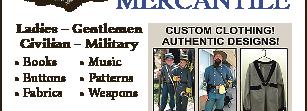
Infantry that lends some insight into how muskets could be lost, or in this case, exchanged. Pvt. Ware had previously entered in his diary how he had hoped to take his musket (which he named “Silver Sue”) home with him after the war. Earlier in the narrative he describes polishing the “brown finish” from the barrel of his musket. It sounds like a U.S. Model 1816/22 smoothbore made in the 1830s, which had browned barrels. He notes he polished his “bright as a mirror.” His account on how he lost “Silver Sue” follows:
“While marching along we passed off to the left, in a valley, a large spring-house; several soldiers ran in to fill their canteens. Ahead of me rushed a regular army soldier with his polished new Springfield rifled musket, and standing it up against the side of the log wall he went in to get a drink. The position which he chose for his gun was not altogether satisfactory to me, and so I moved it off about four feet and placed my polished gun in its place and went in to fill my canteen. What do you suppose that regular army soldier did? Why, he rushed out of that springhouse and without saying a word he just picked up [my musket] “Silver Sue” and ran off with her. It was one of the coolest pieces of robbery that I ever saw, and being at the spring-house made it cooler. He ran on and disappeared in the dust. There was no alternative for me—I had to take the only gun that was left. I smothered my
indignation and also disappeared in the cloud of dust. That evening I traded my silver watch that had been on a strike for some time to a regular for two packages of ammunition—80 rounds, that would fit my new gun, which I called “Orphan.” “Orphan” was a Springfield rifle musket stamped 1861, probably made about March or April of that year. I called it “Orphan” because it had been so cruelly deserted.”
Reading between the lines, Pvt. Ware certainly got the better of that exchange as the U.S. Model 1861, whether made at Springfield Armory or elsewhere, was a highly coveted infantry arm by soldiers on both sides.



Craig L. Barry was born in Charlottesville, Va. He holds his BA and Masters degrees from the University of North Carolina (Charlotte). Craig served The Watchdog Civil War Quarterly as Associate Editor and Editor from 2003–2017. The Watchdog published books and columns on 19th-century material and donated all funds from publications to battlefield preservation. He is the author of several books including The Civil War Musket: A Handbook for Historical Accuracy (2006, 2011), The Unfinished Fight: Essays on Confederate Material Culture Vol. I and II (2012, 2013) and three books (soon to be four) in the Suppliers to the Confederacy series on English Arms & Accoutrements, Quartermaster stores and other European imports.

17 May 2020 Civil War News Deadlines for Advertising or Editorial Submissions is the 20th of each month. Email to ads@civilwarnews.com Publishers: Please send your book(s) for review to: Civil War News 520 Folly Rd, Suite 25 PMB 379, Charleston, SC 29412 bookreviews@civilwarnews.com
The 44th Battle of Olustee Reenactment at Olustee State Park, Florida

 by Professor Earnest Veritas Special Correspondent to the Civil War News -Western Theater-
by Professor Earnest Veritas Special Correspondent to the Civil War News -Western Theater-
One of the bloodiest but least known battles of the Civil War, the Battle of Olustee (also known as the Battle of Ocean Pond), Florida, was fought on Feb. 20, 1864, in north central Florida, pretty much between Jacksonville and Tallahassee. It has been reenacted faithfully for the last 44 years on the same ground upon which it was fought. Now a Florida state park; it is the first Florida state park, organized in 1949. The event has become one of the largest reenactments in the country and arguably the most successful event of its kind in the southeastern United States, routinely drawing between 1,000 and 2,000 reenactors and several thousand spectators.
The battle of Olustee has several features that make it unique in Civil War history. It was a savage bloodbath between approximately 5,500 Federal and 5,000 Confederate troops lasting about four hours. It should never have been fought; indeed, Federal commander General Truman Seymour marched and fought against orders from his superior General Gillmore. The Federals suffered 1861 casualties amounting to 34% losses, making it the second bloodiest of the War for the Federals, while the Confederates suffered 1,000 casualties amounting to a 19% casualty rate. Three USCT regiments were involved, including the veteran 54th Massachusetts, the 35th USCT, and the newly formed and inexperienced 8th USCT. It was the last gasp of the Federal effort
to secure Florida for the Union before the 1864 presidential election. When Georgia infantry formed square to defend against cavalry attacks; the formation was broken with artillery fire.
Department of the South Commander Major General Quincy Adams Gillmore had met with Brigadier General Truman Seymour (portrayed by James Permane), in Jacksonville, Fla., and decided there was no need for troops to go into the interior of Florida; securing the coastline would gain the supplies of food and materials, denying them to Confederate forces, and aid the naval blockading patrols. He then returned to his headquarters in Hilton Head, S.C.
Seymour decided to try to march some fifty miles to the Suwanee River and burn a vital bridge there. He sent a telegram to General Gillmore telling him that he was moving. General Gillmore frantically tried to stop him but to no avail.
Seymour advanced west out of Jacksonville with three brigades of infantry, a brigade of cavalry, and 16 guns, heading for the Suwanee river. On the morning of February 20, he left Barber’s Plantation, moving toward Lake City. Brigadier General Joseph Finnegan (portrayed by Thomas Jessee), commander of the area’s CSA troops, gathered his men to meet Seymour about 13 miles east of Lake City, Fla. It was a perfect place for an ambush; Federal forces had to march over a narrow neck of dry ground through long leaf pine forests with so much shade there was little undergrowth between Ocean Pond to the north and swamp lands to the south. Finnegan positioned his
approximately 5,000 troops and engaged the Federals at Olustee, the afternoon of Feb. 20. The Federals drove the Confederate troops back several miles toward Lake City.
The battle had significant artillery and cavalry involvement. Finnegan’s Georgians formed a square to fend off Federal cavalry but it was broken up by effective artillery fire. The Federal forces were poorly led, and some men were so inexperienced that they could not muster effective fire power. Moreover, they were committed piecemeal and garnered no significant momentum to carry the battle.
Fighting was so heavy that the Confederates ran low on ammunition with some units standing in line of battle with empty weapons. With the slowed Confederate firing, the Federals thought they were falling back and advanced. Confederate runners had to go back about a half mile to get more ammunition and ran back with it while a Confederate officer, waving a flag, rode furiously up and down the line shouting encouragement to the troops as they got the new ammunition and began to advance once again.
Confused orders caused the 7th New Hampshire to pivot its battle line; the resulting chaos and domino-like falling back doomed the Federals. The Union reserve force consisting of the 54th Massachusetts and the 35th USCT were ordered forward and held stead as the Federals fell back toward Jacksonville. They were highly praised for the stubborn resistance that gave their comrades the time and opportunity to extricate themselves from a devastating situation. They were assisted by Federal cavalry and the 7th Connecticut. General Finnegan pressed on until nightfall and in the falling darkness ceased the pursuit.
The reenactment was held on the actual battlefield of Olustee.
It is one of only a handful of reenactments still held on original battlefields. Florida has two other state parks that have reenactments fought on the original battle grounds. They are Natural Bridge (a Civil War battle) and the Seminole War’s Dade Battle. Spectators had a great demonstration for the hour-long reenactment on Sunday afternoon as more than 1,000 reenactors
swayed back and forth across the battlefield. Bleachers are built so all the spectators had a good view of the fight. The pyrotechnical aspect of the battle was stunning as simulated artillery shells went off, blowing dirt, shrubs, and trees far into the air. A particularly impressive display came as “shells” exploded in the center of the infantry square the Georgian troops had formed.
The running out of ammunition and runners going for more was well done by the Confederate troops. The officer riding his horse up and down the Confederate line was a stirring sight.
The battle was well executed. It is well worth the effort of reenactors to come and participate and an excellent event for spectators.
Sutlers were in abundance for soldier and civilian alike.
Chaplain Alan Farley held services and had the Christian Commission coffee wagon serving gallons of coffee for the troops and civilians who were participating.
A significant event for the park and the reenactment was held after the battle on Sunday afternoon. Ground was broken for the park’s new visitor center and museum. The Olustee Battlefield

Citizen Support Organization has been pushing for the new structure for a number of years and contributed $200,000 to the project. The benevolent HTR foundation (Hill Truck Rental) donated one million dollars to the effort. Representatives from both organizations were present as well as dignitaries from the Florida state park system, the Federal government, and elected officials. The effort to preserve Civil War History is alive and well in Florida.
To help with the completing the new visitor center and museum, you may make a contribution at: battleofolustee.org/ donate-to-the-museum.
For more information, please go to battleofolustee.org.
Olustee Battlefield
Historic State Park
5815 Battlefield Trail Road Sanderson, FL 32087
Professor Veritas would like to thank: Gary Dickinson of the Olustee Battlefield Citizen Support Organization (CSO), Paul Duran of the Olustee Battlefield (CSO) Board of Directors, Thomas Jessee, and James Permane, for their
18 Civil War News May 2020
Federal cavalry engaging the Confederate lines. (Olustee Festival photo)
Olustee Battlefield groundbreaking ceremony for a new visitor center. (Paul Duran)
Federal artillery fire. (Olustee Festival photo)








19 May 2020 Civil War News
Finnegan leads Confederate infantry. (Jud Johnson)
Federal infantry marching into battle. (Jud Johnson)
The 11th North Carolina band. They are shown playing for the Sunday morning muster (the big one). They provided the music for the event and played for the period church service. (Tom Davison)
Bud Thayer recreating an actual moment in the battle when a Confederate officer rode his horse furiously up and down the line and rallied the C.S. troops as they were waiting for ammunition. (Olustee Festival photo)
Confederate troops marching into battle. (Paul Duran)
Federal lines during the battle. (Paul Duran)
Confederates charge toward the advancing Federal troops. (Tom Davison)
Federal troops charge the advancing Confederates. (Tom Davison)
Smithsonian Open Access Search Page
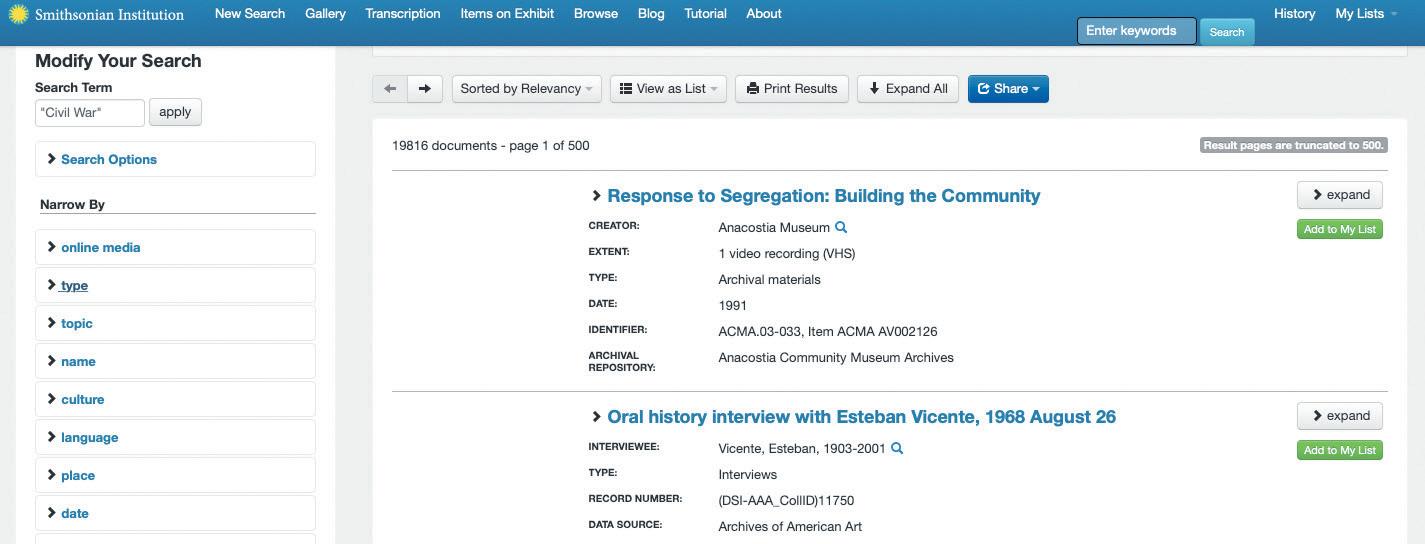
Public Domain: “The realm embracing property rights that belong to the community at large, are unprotected by copyright or patent, and are subject to appropriation by anyone.” Thanks Merriam-Webster! With the passing of each year, previous works may enter the public domain. For example, as of 2020, works published in 1924 expired unless renewed. In February 2020, the Smithsonian Institute, through its Open Access platform, announced the release of 2.8 million images into the public domain; their collection totals over 155 million objects, and digitization on some of these holdings will continue over the coming years. The Smithsonian plans to release an additional 200,000 images throughout 2020. To learn more about the entire project, visit https://collections.si.edu.
Researchers of the American Civil War will benefit from these vibrant images. To begin a search, visit https://collections. si.edu/search/. This page will serve as the foundation, and also highlights specific collections from various repositories within the Smithsonian family of museums and archives. Searching for “Civil War,” using the quotation marks in the search, will produce targeted results. As of mid-March 2020, this search yielded 19,816 results. Users will see several ways to narrow the search results, including by media type, topic, name, culture, language, place, date, etc. The Smithsonian offers the following search tip example,

which this writer customized for the subject under study. See additional search instructions at https://collections.si.edu/search/ tutorial.htm#search-tips.
Looking for photographs of the Civil War from the 1860s.


1. Use: “Civil War” as your search term,
2. Apply Online Media narrow by “images” in the left
column,

3. Apply Type narrow by “Photographs” in the left column,
4. Apply Date narrow by in the left column, look for the 1860s.
Applying these parameters reduces the number of results to 1,549. One can determine the next steps based on the scope of
Search result subcategories.

20 Civil War News May 2020
Smithsonian Institute: Open Access Images
Atlanta, Georgia, As It Appeared on the Entrance of the Union Army under General Sherman, Sept. 2, 1864.
Fort McAllister map.
Colonel John S. Mosby, taken in 1864.
the research. For example, select ‘type’ in the left column of the results page and several subcategories open; see the image shown. Select ‘See All’ to open a listing of many categories, which one can sort alphabetically.

Many narrowing techniques will result in various findings. This writer, using the search as mentioned above with keywords “Civil War,” and setting the date





to the 1860s, then selected ‘online media’ as the image type, ‘Georgia’ as the place and ‘lithograph’ as the subcategory. The result, the image of Atlanta which this writer had not previously seen




Many exciting results await your search at the Smithsonian’s Open Access platform. From lithographs, documents, photographs (like this albumen silver
Publishers/Authors





Digital Issues of CWN are available by subscription alone or with print plus archives from 2012 to present at www.CivilWarNews.com

print of Colonel John S. Mosby), maps, like the one shown of Fort McAllister, and much more. Take time to explore the collection of the Smithsonian! Next month, we will investigate additional primary sources. Until then, good luck in researching the Civil War!
Michael K. Shaffer is a Civil War historian, author, lecturer, instructor, and a member of the





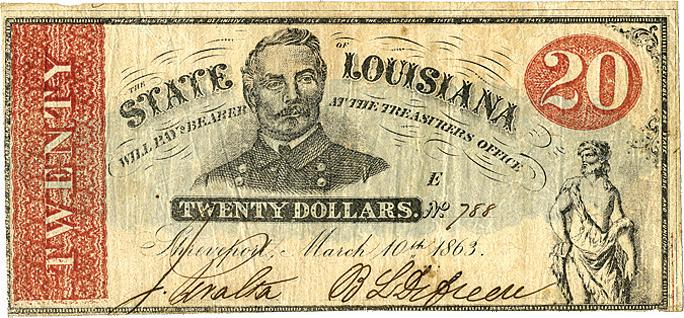


Society of Civil War Historians, the Historians of the Civil War Western Theater, and the Georgia Association of Historians. Readers may contact him at mkscdr11@gmail.com, or to request speaking engagements, via his website www.civilwarhistorian.net. Follow Michael on Facebook www.facebook.com/ michael.k.shaffer and Twitter @ michaelkshaffer.
Deadlines for Advertising or Editorial
Submissions is the 20th of each month. Email to: ads@civilwarnews.com

21 May 2020
War News
Civil
Greg Ton • P.O. Box 9 • Franklin, TN 37065 901-487-5944 • GTon1@aol.com Greg Ton Buying and Selling the Finest Confederate, Obsolete and Southern States Currency Since 1978 GregTonCurrency.com
Updated Information Send your book(s) for review to: Civil War News
Folly Road, Suite 25 PMB 379 Charleston, SC 29412
520
bookreviews@civilwarnews.com
Scarce George Custer
Related ID Pin
Question:
I have a badge for the Battle of Cedar Creek. What was the intended audience for this badge? The general public or soldiers in the cavalry unit? I don’t know what I shared with you before. Here is a little about the badge. Dan Underhill is a distant relative of my wife (her family has many old ties with Long Island families). Underhill was from Oyster Bay, Long Island, and was typical of the youth who joined the war. He joined with his friend, who was the son of the town mayor, against the mayor’s wishes. Underhill wrote many letters home about his everyday war experience and also detailed the death of his friend, the mayor’s son, in battle. Underhill participated in some of the major battles of Virginia and the Shenandoah Valley. He survived the war but was tragically killed in a carriage accident in Central Park three years later, unmarried. A fellow soldier wrote a particularly poignant obituary, which accompanies the badge.
Answer:
This indeed a very scarce and desirable George Armstrong Custer related ID pin. This custom ID badge was offered in several Civil War era newspapers that soldiers read advertising “the officially adopted Custer Cavalry badge.” Though the badge was never actually, officially, adopted, it was advertised as such. The 35 mm medallion was manufactured by B. J. Hayward of New York City whose ads appear in Army & Navy Journal and was pictured in Frank Leslie’s Illustrated Newspaper. This badge is considered wartime and likely made in 1865; Underhill was in service until June 1865.
Daniel J Underhill (1833–1868) entered service September 1862, in the 2nd New York Cavalry. He served the entire war in same unit. The 2nd was one of the more famous New York cavalry regiments and ranks 8th in Fox’s Regimental Losses in the American Civil War 1861–1865 (1889), for cavalry regiments that lost the most men killed and
Confederates had larger losses including 1,860 killed & wounded, and over 1,500 men captured. “It was an expensive victory but worth the terrible price. The surviving Confederates were devastated, not just from the loss of men and equipment, but their morale was shattered beyond repair.” Custer’s comments about “Cedar Creek” are memorialized on the reverse side of your distant relative’s white metal ID medallion.
John is an certified appraiser with International Society of Appraisers specializing in Civil War memorabilia. He authenticates and evaluates other rare and valuable historic items as well. His website is www.civilwardealer.com.

He is coauthor of the book
fatally wounded in action during the war.
From the New York Times Oct. 20, 1864: “The battle of Cedar Run, on Wednesday, Oct. 19, 1864, will be recorded in history as one of the most remarkable that has thus far taken place in this rebellion.”
The Union victory of Cedar Creek, or Third Battle of Winchester, produced a feather in General Sheridan’s cap. Sheridan was Custer’s mentor; Custer admired him greatly for his early trust in giving him command.
At Cedar Creek Sheridan had almost 6,000 casualties including 644 killed, 3,430 wounded, and 1,591 missing. The defeated
There are no complete badges of this type found in any auction or institutional collections I am aware of. This is the only complete badge I have seen, although I am told there is at least one other by a knowledgeable Custer collector. A similar scarce Custer silver ID badge of different design from the Libbie Custer descent line is inscribed to Benjamin Tuttle of the 1st Conn. Cavalry. It sold in 2012 at SpinksSmythe for $10,315. It later sold in the 2015 James Julia Auctions for $7,110. The Tuttle badge has similar rarity in being a complete badge with ribbon and inscribed top. The silver drop has been sold before as has the 35 mm “Cedar Creek” medallion drop. The last three sold for about $1,000 each. Custer is an iconic American figure and although Custer is not as popular in modern culture today, he is still “The General” and has a following among collectors. Underhill’s complete badge in auction with a presale estimate of $3,000-4,000, could easily bring more.
Confederate Bowie Knives (2012) by Jack Melton, Josh Phillips and John Sexton, that was published by Mowbray Publishing, Inc. Send “Ask The Appraiser” questions and photographs to civilwarappraiser@gmail.com.
“THE HISTORY OF THIS WAR WHEN TRUTHFULLY WRITTEN, WILL CONTAIN NO BRIGHTER PAGE THAN THAT UPON WHICH IS RECORDED, THE CHIVALROUS DEEDS, THE GLORIOUS TRIUMPHS OF THE SOLDIERS OF THE THIRD DIVISION CEDAR CREEK 19 OCT. 1864. G.A. CUSTER.” 35 mm diameter. (Betsey J. Hayward, 208 Broadway)
Obverse of detailed and realistic bust of a uniformed, mustachioed, and longhaired
Major General George Armstrong Custer, facing left, within a wreath surrounded by text: CUSTER’S 3 CAV. DIV.”.
The $27 badge referred to the above medal that was unknown when Phillips and Lord wrote their texts. The $27 version was a gold medal that sold in excess of $100,000 several years ago.


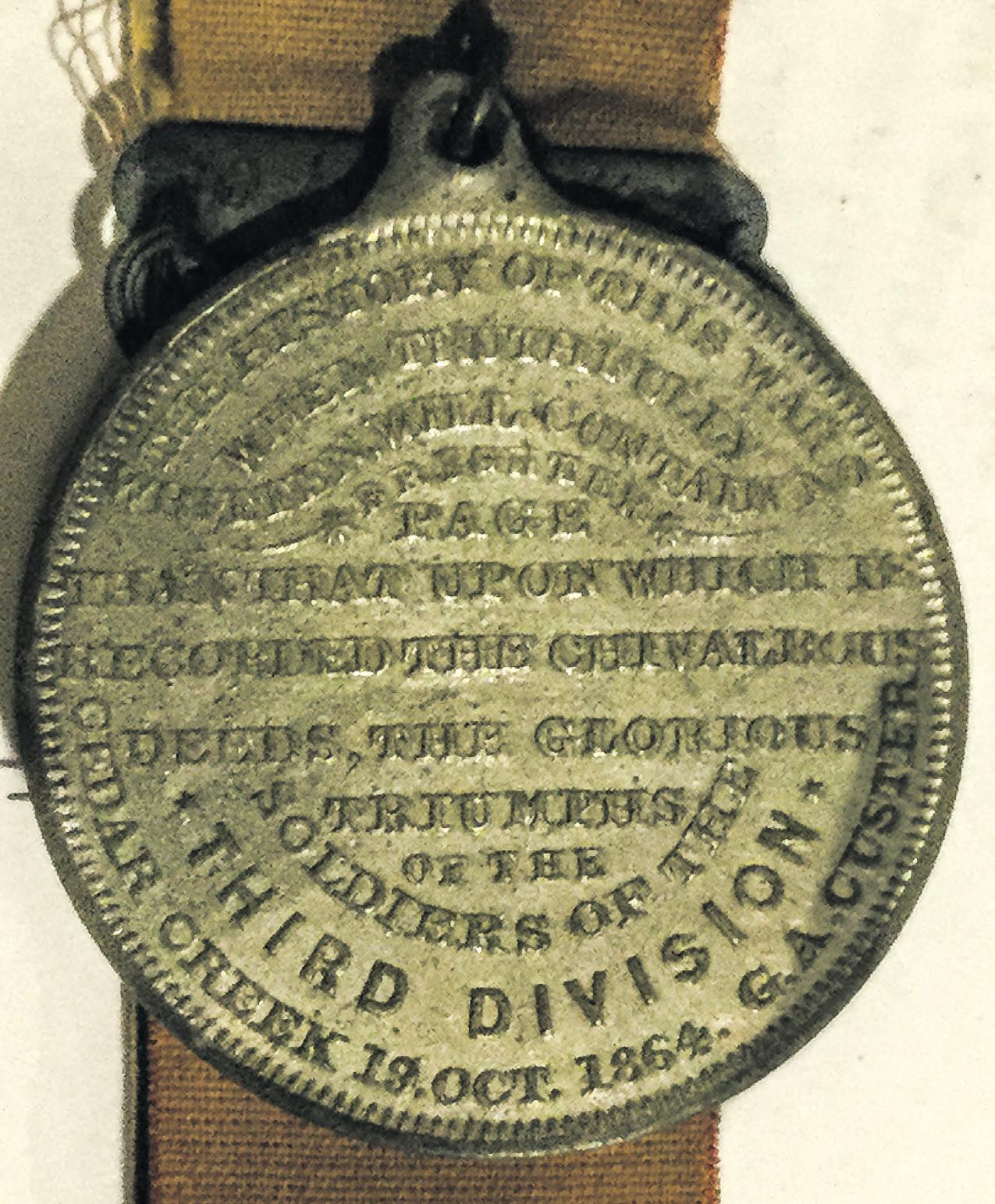
22 Civil War News May 2020
(John
The Artilleryman Magazine is a quarterly magazine for enthusiasts who collect and shoot
from Rev War to World War II. $34.95/ year.

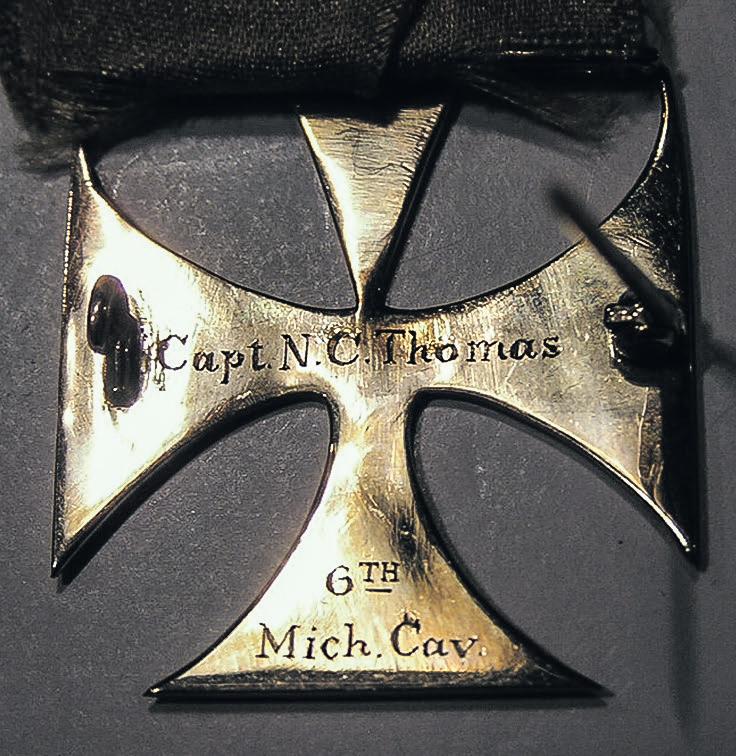
Historical Publications LLC, 520 Folly Rd. Suite 25 PMB 379 Charleston, SC 29412 800-777-1862
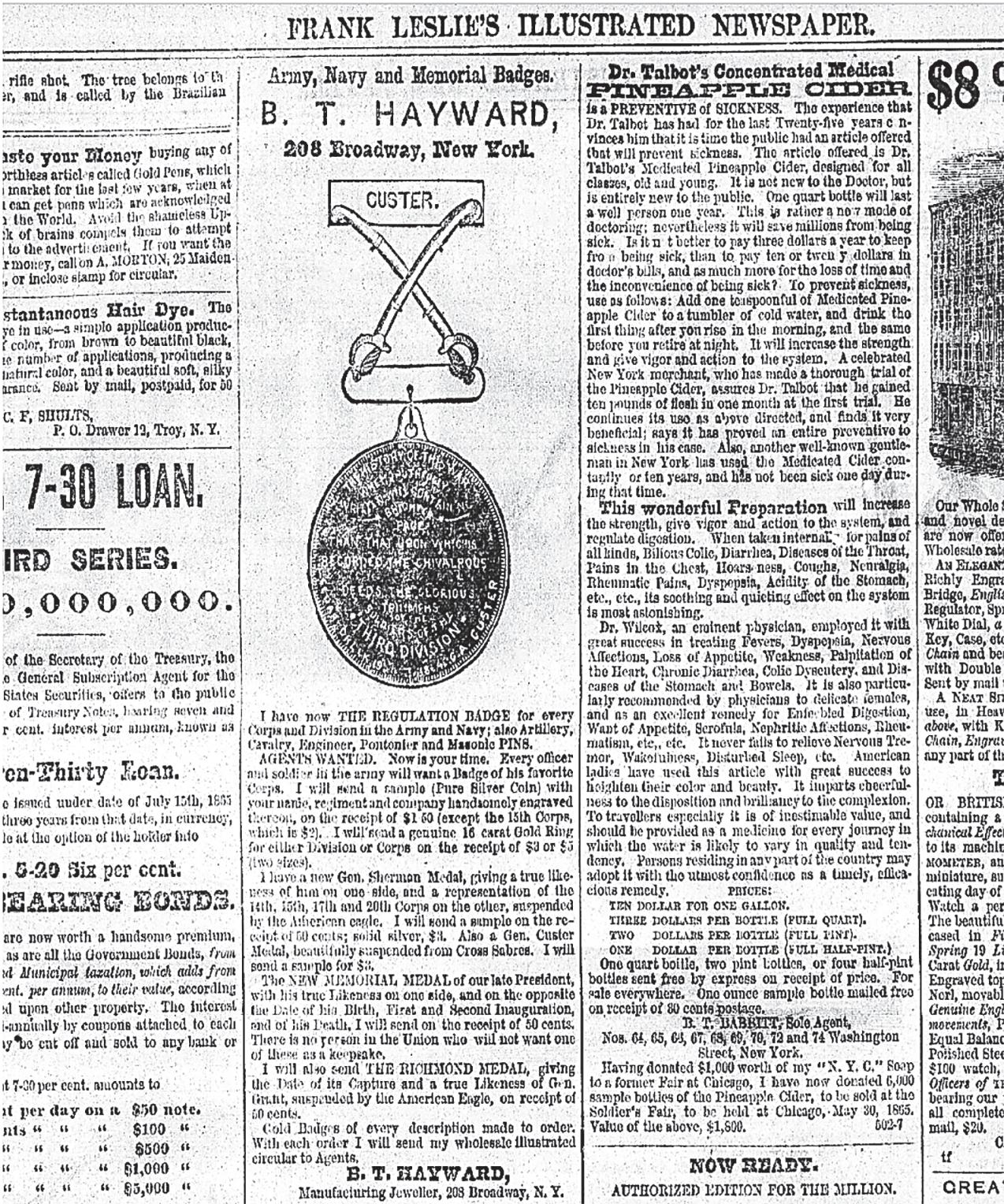

www.ArtillerymanMagazine.com

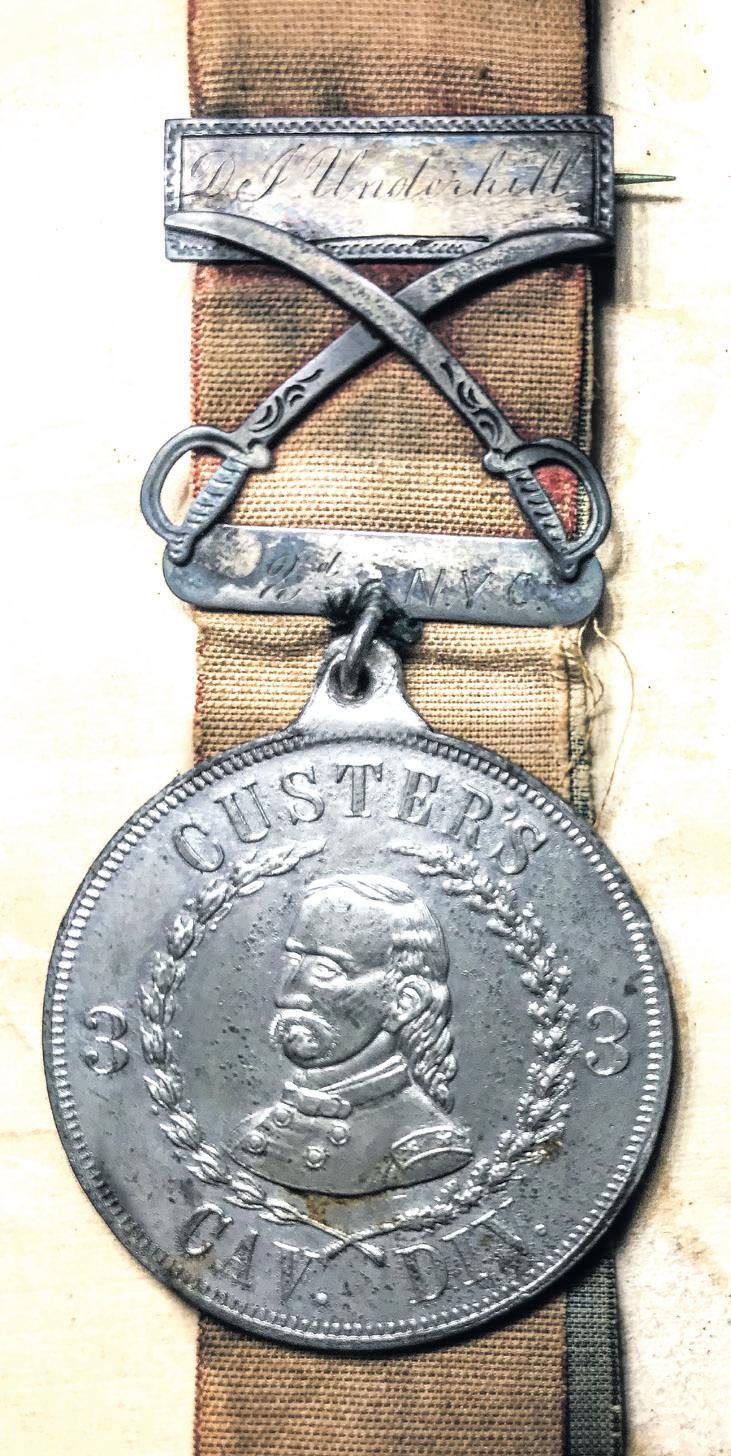
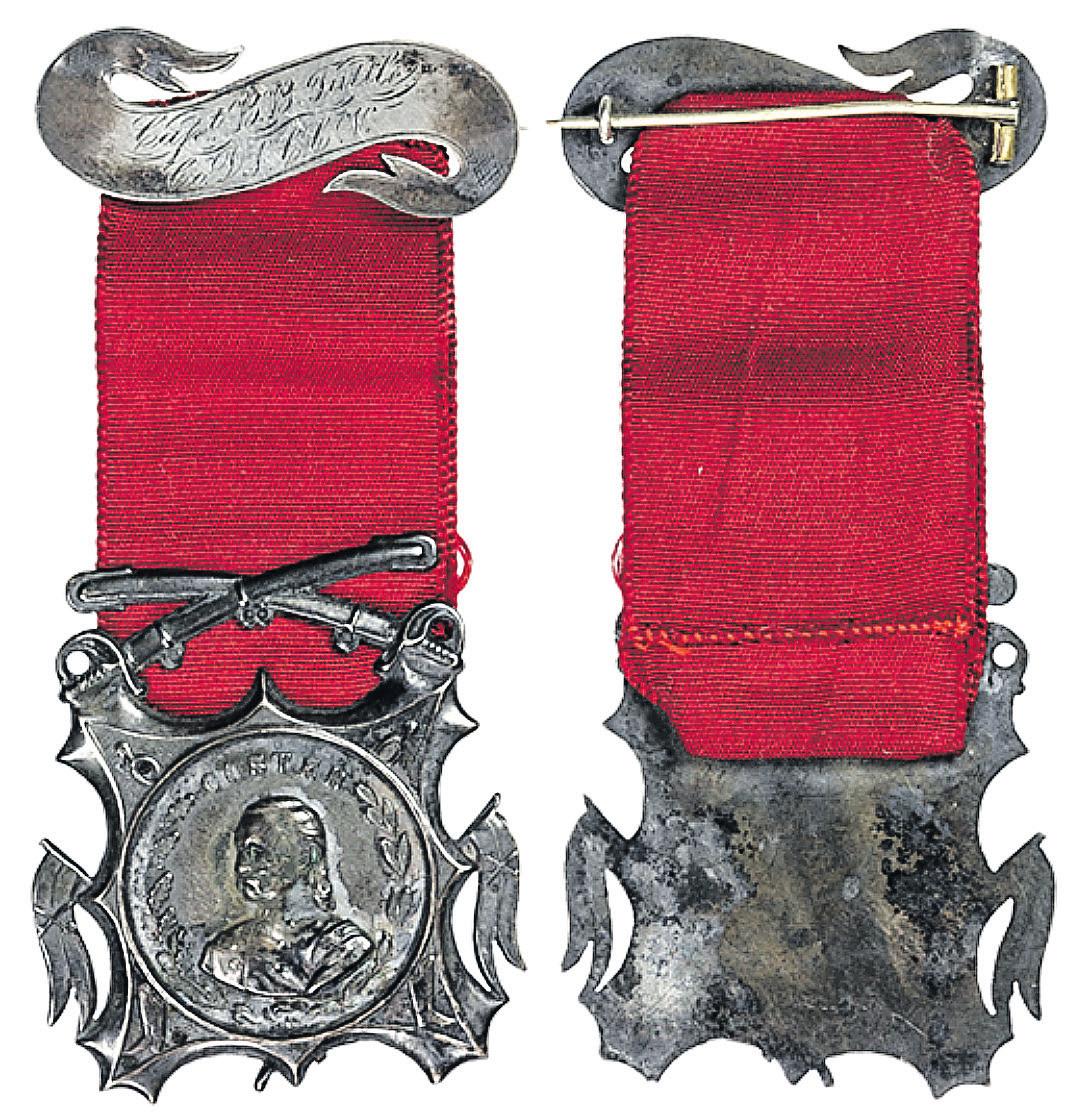

23 May 2020 Civil War News
Custer designed this valor medal. Few are known. A similar example solder for just over $100,000 at Cowan’s Auction, Cincinnati, June 2016.
Beckendorf Collection)
Sold at Spink-Smythe Auctions, New York, lot 1074, Libbie Custer sale 2012, $10,350. This same badge sold in 2015 at James Julia Auctions with lessened interest in Custer for $7,110.
“Gen. Custer Medal, beautifully suspended from Cross Sabres. I will send a sample for $3.” (Frank Leslie’s Illustrated Newspaper, June 19, 1865)
cannons
Close-up of obverse of 35 mm medallion of ID pin with Custer bust and 3rd Division markings. Top bars inscribed: “ D. J. Underhill / 2d N.Y. C.”
Stirring Up Dry Bones
“The fact is the Government is getting to regard the Monitor in pretty much the same light as an over careful housewife regards her ancient china set – too valuable to use … yet anxious that all shall know what she owns & that she can use it when the occasion demands.”
 – William F. Keeler, Assistant Paymaster, USS Monitor
– William F. Keeler, Assistant Paymaster, USS Monitor


On May 4, 1862, Gen. Joseph Johnston pulled his troops out of Yorktown, Va., to avoid the massive bombardment of his position by Gen. George McClellan. President Abraham
Lincoln considered the weeks McClellan spent hauling in siege guns a waste of time. On May 6, Lincoln, Sec. of War Edwin M. Stanton, Sec. of Treasury Salmon P. Chase, and Brig. Gen. Egbert Viele arrived at Fort Monroe, Va., to move the war forward in Virginia.
Fort Monroe, the “Gibraltar of Chesapeake Bay,” was located on the end of a peninsula formed by the York and James Rivers. Fort Monroe protected the Federalheld port of Hampton Roads and prevented Confederate access to Richmond, Va., via the James River. The fort remained in Federal control after Virginia’s secession due to the quick and decisive efforts of Gen. John
Ellis Wool, Cmdr. of the Army Department of Virginia. Wool, age 78, was the oldest officer in the field. He had served in both the War of 1812 and the Mexican American War. Wool’s hands trembled and he would repeat things he had said earlier, but he could still mount a horse and his bravery remained firm.
As McClellan was far too busy chasing the enemy to see them, Lincoln turned his attention to the local sights. The Confederate batteries at Sewell’s Point caught his notice. After prodding from Lincoln, U.S. Adm. Louis Goldsborough agreed to organize a “go up & feel” while Lincoln visited the fleet.
On the Monitor, Assistant
Paymaster William Keeler recounted, “Most of our visitors come on board filled with enthusiasm & patriotism ready, like a bottle of soda water, to effervesce the instant the cork is withdrawn, but with Mr. Lincoln it was different. His few remarks as he accompanied us around the vessel was sound, simple, & practical, the points of admiration & exclamation he left to his suite.”
After the March 8-9, 1862, Battle of Hampton Roads, Va., a.k.a. the “Battle of the Ironclads”, the Monitor and CSS Virginia (former USS Merrimac) settled into a game of cat and mouse. The crews of both ironclads believed they won the battle, wanted a rematch, and were prevented from doing so by their governments. The Virginia patrolled the Elizabeth River, protecting Sewell’s Point and the Gosport Navy Yard at Norfolk, Va. The Monitor was part of the fleet that blocked her movement past Hampton Roads. Her crew was frustrated because, “day after day the emblem of rebellion flaunts in our very faces, & day after day we remain torpid & inactive.”

That afternoon Lincoln watched the Sewell’s Point attack. The Monitor’s Lt. Samuel Greene loaded a ten second Birney shell then fired. The Monitor moved in closer, 300 yards from her target. Keeler wrote, “… bang, bang go the guns again – as yet no response from the fort. Their rag still flies but nothing living is to be seen.” Due to heated guns, the Monitor withdrew, “as four of our gun boats drawn up a half circle were sending an almost uninterrupted storm of iron over our heads & into the rebel defenses.” The buildings burned as the Confederates managed to raise their fallen flag.
From the distance the telltale signs of the approaching Virginia a.k.a. “the Big Thing” could be seen. She is “concealed in a huge murky cloud of her own emission, black, and repulsive as the perjured hearts of her traitorous crew. The water hisses and boils with indignation as like some huge shiny reptile.” The Federal fleet, following Lincoln’s original orders, “not to risk the Monitor,” obeyed the signal to “resume moorings.”
On a roll, Lincoln turned to reclaiming the Gosport Navy Yard. After much discussion, Lincoln took matters into his own hands by consulting the charts. With a local pilot and two cabinet ministers, the President scouted a troop landing site from a tug.
Early the next morning over 5,000 troops set out for Norfolk. Wool had begged Stanton to lead the assault and he had agreed. Both Chase and Viele also accompanied the landing troops which led to confusion regarding chain of command. Chase ordered Viele, “in the name of the President,” to take command. Outside Norfolk, about 5 p.m. they were met by the Mayor William Lamb and the city council. Lamb had prepared a ceremony to turn over the keys to the city that lasted until dark.
Johnston had warned that he was abandoning the peninsula to protect the capital at Richmond. C.S. Gen. Benjamin Huger ordered the evacuation of Norfolk and to salvage what they could. The attack at Sewell’s Point came as the Confederates were dismantling their guns. While Wool and Chase listened to the mayor, the Confederates were destroying the Navy Yard and the last of Huger’s men boarded the final train out.
The Federals were thrilled by the bloodless capture of Norfolk. Stanton “fairly hugged General Wool.” Chase considered the expedition, “a brilliant week’s campaign of the President.” Lincoln received confirmation that an energetic spirit can be more
24 Civil War News May 2020
Officers of the USS Monitor grouped by the turret, Keeler seated second row, second from left, James River, Va., Colorization © 2020 civilwarincolor.com, courtesy civilwarincolor.com/cwn. (Library of Congress)
valuable than expertise. Keeler would credit Lincoln for “stirring up dry bones … It is extremely fortunate that the President came down when he did- he seems to have infused new life into everything, even the superannuated old fogies [Goldsborough and Wool] began to show some signs of life.”
With the evacuation, the Virginia now lacked a base. Her captain, Flag Officer Josiah Tattnall, had a decision to make. The ironclad could attack the Federal fleet and go down in a blaze of glory or be taken up the James River to serve as a floating battery to defend Richmond, but only if her draft could be reduced from 23 to 18 feet. The crew threw everything overboard except her guns and ammunition. Then the prevailing wind changed, making the river shallower. Furthermore, she was no longer an ironclad. Thus, the Virginia was set ablaze to avoid capture. Her enemies watched the inferno with glee. After “a tremendous explosion

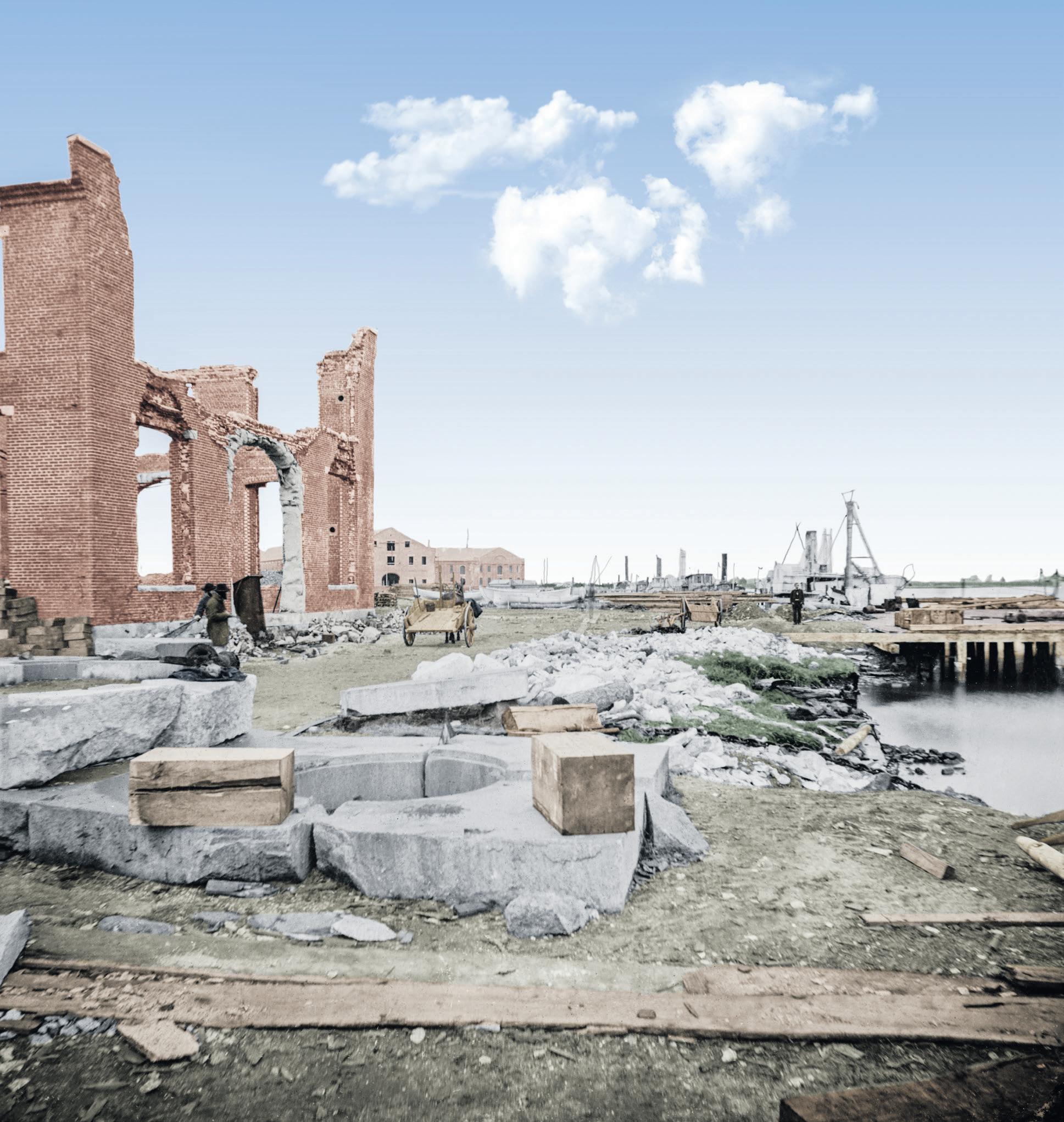
the Merrimac went into the air and was seen no more.”
Sources:
• Daly, Robert W., ed. Aboard the USS Monitor: 1862: The Letters of Acting Paymaster William Frederick Keeler, US Navy, to his wife Anna, Annapolis, MD: United States Naval Institute Press, 1964.
• Symonds, Craig L., Lincoln And His Admirals, Oxford University Press, 2008
• Quarstein, John V. The Monitor Boys: The Crew of the Union’s First Ironclad (Civil War Series), Arcadia Publishing Inc, 2013
• Sears, Stephen W. To the Gates of Richmond: The Peninsula Campaign, Houghton Mifflin Harcourt, 1992
• Foote, Shelby. The Civil War: A Narrative: Volume 1: Fort Sumter to Perryville (Vintage Civil War Library), Knopf Doubleday Publishing Group, 1986
Stephanie Hagiwara is the editor for Civil War in Color.com and Civil War in 3D.com. She also writes a column for History in Full Color. com that covers stories of photographs of historical interest from the 1850’s to the present. Her articles can be found on Facebook, Tumblr and Pinterest.
REINFORCEMENTS
MAKE ALL THE DIFFERENCE!!!

Nobody even comes close to building a Civil War tent with as much attention to reinforcing the stress areas as Panther. Our extra heavy duty reinforcing is just one of the added features that makes Panther tentage the best you can buy!

Catalog - $2 Web: www.pantherprimitives.com
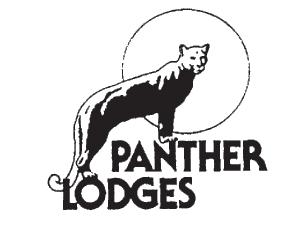
25
May 2020 Civil War News
Ruined buildings at Navy Yard, Norfolk, Va. Colorization © 2020 civilwarincolor.com, courtesy civilwarincolor.com/cwn. (Library of Congress)
The Monitor and Merrimac. Artist: J. O. Davidson. Published by L. Prang & Co. Boston, 1886. CSS Virginia on the left and the USS Monitor on the right firing a shot at the Virginia. The USS Cumberland and USS Congress are in the background. (Library of Congress)
160
era
Civil
Includes
60
our famous tents and a 4-color
Your $2 cost is refundable with your first order. SEND for copy TODAY The Best Tents in History P.O. Box 32N Normantown WV 25267 (304) 462-7718
PANTHER
pages of the best selection of historical reenactment items from Medieval
to
War era.
over
pages on
section.
Our Generals in the Field
The Graphic War highlights prints and printmakers from the Civil War discussing their meaning and most importantly, the print maker or artist’s goals.
Our subject this month is almost amusing. It is an attempt, by relatively obscure New York lithographers Frank Crow, Henry Thomas, and Henry C. Eno to convey Union strength and unity in the face of the Rebellion. Although it was not meant as a caricature or a satirical look at Union leadership in the early days of the war, to modern eyes, its obvious impact is comical and highly inaccurate. But to an anxious public midway through a bloody and tragic war, seeing their anointed generals on vigorous steeds was reassuring if nothing else.
The three lithographers did not become partners until 1863, so it is curious that half way through the war, these particular generals would be featured. Like many lithographic partnerships in the mid-19th century, the three quickly moved on to establish new relationships or found their own companies. Crow and Thomas went on to specialize in theater posters. Henry Clay Eno and Thomas worked together from 1862 to 1868. Eno also ran his own firm from 1865 to 1868.
This print, published by W. Lyons of 37 Park Row, New York, depicts sixteen Union generals on horseback from left to right: Butler, Wool, Rosecrans, Anderson, McDowell, Dix, McClellan, Scott, Sprague, Blenker, Mansfield, Burnside, Banks, Halleck, and Heintzelman.
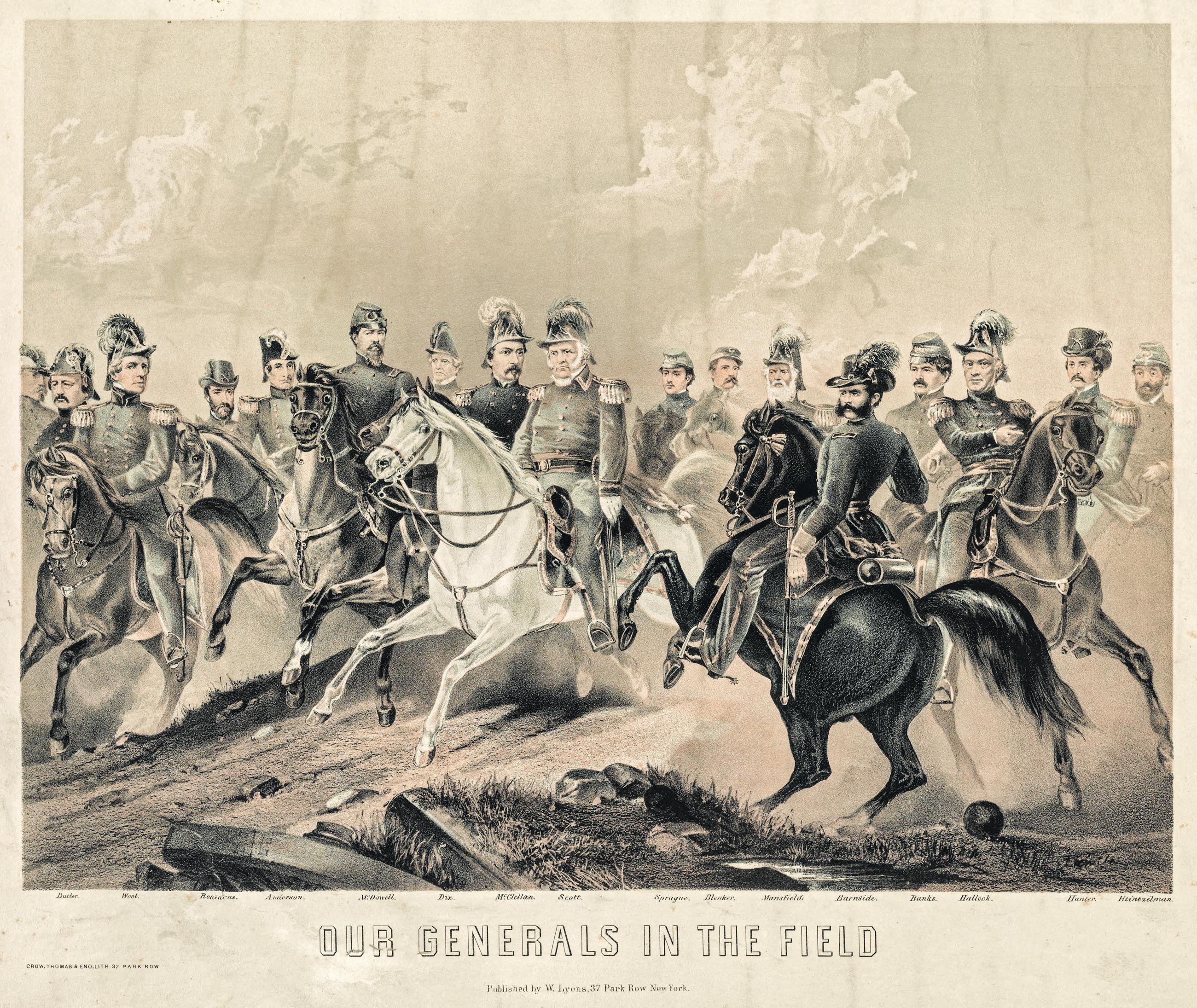
It is obviously the first team, fielded at the war’s inception. Center stage is General Winfield Scott on a magnificent white charger, sitting as though he is lashed to the saddle to remain upright.
Immediately to the right [Scott’s left] is Ambrose Burnside on a rearing black steed; the general depicted is nothing close to real life. Farther right is another “desk jockey” Henry Halleck. Just to the left [Scott’s right] of Scott is McClellan. Fewer than half “the first team” made names for themselves, many sinking into
obscurity.
Conspicuous by their absence are Grant, Sherman, Thomas, and Sheridan who were just coming into their own as leaders in suppressing the rebellion. Only on rare occasions were naval heroes such as Foote and Farragut represented.
Butler, Rosecrans, Burnside, Anderson, McDowell, and Sprague managed to survive the war and the responsibility of command to various degrees. Wool, like Halleck, Dix, and Scott proved willing but too old
for command responsibilities. Banks, Blenker, and Heintzelman, all proved incapable and not up to the task of successful leadership. Mansfield died from his wounds at Antietam.1
For his part, Henry Eno produced other timely lithographs including real time views of Atlanta during Sherman’s occupation. Unfortunately, the Atlanta views are rare. The Atlanta History Center has a few; it appears that the Library of Congress does not. He produced city views, scenic views, and sheet music covers.2 Henry Eno came from a wealthy New York family headed by Amos Richards Eno, realtor and philanthropist. When Eno senior passed away in 1898, his estate was estimated between $20 and $40 million. When Amos Francis Eno, Henry’s brother, died in 1915, he donated his vast collection of books and city views of Manhattan to the New York Public Library. A local print dealer called Eno’s collection “one of the few really great collections.”3 Ironically, Henry, the print producer, died the year before (1914) at age 73 and was not the beneficiary of his brother’s (the print collector’s) largesse.
Endnotes:
1. See Ezra J. Warner, Generals is Blue: Lives of the Union Commanders. Baton Rouge: LSU Press, 1964.
2. Jay T. Last. The Color Explosion: Nineteenth-Century American Lithography. Santa Ana: Hillcrest Press, 2005, 178, 183, 233.
3. The New York Times, October 29 and 30, 1915.
After 43 years in the museum field, Salvatore Cilella now spends his time collecting American prints and maps and writing. His last professional position was President and CEO of the Atlanta History Center. His most recent books are Upton’s Regulars: A History of the 121st New York Volunteers in the Civil War (U. Press Kansas, 2009). His two-volume Correspondence of Major General Emory Upton, (U. of Tennessee Press, 2017), is the recipient of the 2017-2018 American Civil War Museum’s Founders Award for outstanding editing of primary source materials. His latest book is an edit of Upton’s letters to his wife 186870, recently published by the Oklahoma University Press.

26 Civil War News May 2020
“Our Generals in the Field” by Crow, Thomas, and Eno, ca. late 1862 or early 1863. (Library of Congress)
Want To Advertise In Civil War News? Email: ads@civilwarnews.com Or Call 800-777-1862. For a rate sheet visit: www.civilwarnews.com
Given the unprecedented impact of the Coronavirus, the American Battlefield Trust made the decision to postpone and reschedule its public events through the end of May 15, 2020.
“The American Battlefield Trust, along with countless other cultural institutions, is disappointed we won’t have the opportunity to proceed with our public events in the near term,” said Trust President Jim Lighthizer. “However, we recognize that public health considerations are paramount at this time, and are committed to protecting the health and well-being of our members, staff and friends.

“We look forward to interacting with our members on the battlefield as soon as it is advisable to do so. And we urge those who live in proximity to battlefields and other similar sources of outdoor recreation to enjoy them individually—and safely—in the interim.”
This postponement impacts the Trust-hosted “Generations” events at Yorktown and Gettysburg, as well as Pop-Up tours for eligible members, which will be moved into the summer and autumn at dates to be determined. Also included was the 24th Annual Park Day clean up event. The nearly 130 sites that had signed up to participate are encouraged to reschedule at their own discretion.
Decisions regarding future Trust events, notably the Annual Conference and National Teacher Institute, will be made in accordance with guidelines from the Centers for Disease Control and the advice of public health officials. Those who have already registered for these events will receive updates directly to keep them abreast of any changes to their status. Information about these and other forthcoming gatherings will be posted at www.battlefields.org/events.
Despite the situation, the Trust continues to operate, working remotely to lay the groundwork for future preservation success and generate outstanding history content.
“In lieu of the public events we have had to postpone, we encourage history lovers to join our vibrant social media community and take advantage of
our numerous digital offerings,” Lighthizer said. “In particular, our catalog of educational videos covering a huge range of topics in American history may be of interest to those unable to travel this spring or those who are looking to supplement distance learning environments.”
Among the digital assets currently available through the Trust website are:
Lesson Plans and Curricula: Our downloadable Civil War Curriculum covering that conflict and the antebellum period is available in multiple grade levels. A new, inquiry-based curriculum will launch in the coming weeks, and we are preparing similar offerings for the Revolutionary War and Early Republic/War of 1812. Our website boasts thousands of articles on historic events and figures, hundreds of acclaimed maps and even quizzes to test your knowledge.


Battle App™ guides and Virtual Tours: While GPSenabled to help lead you around in person, our free Battle App™ guides for iOS and Android devices can be accessed from anywhere in the world to bring you “onto the field” with leading historians. Our 20 Virtual Tours utilize stunning 360-degree photography to place you at the heart of key battlefields and highlight key landmarks, from Antietam to Yorktown.
Social Media Channels: The history conversation continues on the Trust’s vibrant digital communities including Facebook, Instagram, Twitter, Pinterest, and YouTube. Together, these platforms embrace more than 500,000 followers with daily content updates.
But he most versatile tool in the Trust’s education arsenal is our suite of high-quality video series.
These include:
Animated Maps: Whether you want to cover the entire American Revolution or Civil War in a single sitting, or dive into campaign-level learning (like The Overland Campaign), these mini-documentaries are ideal viewing.
Battlefield U: Have a burning question about American history and need a succinct—but authoritative—answer? This rapidly growing series tackles commonly
Virtual Reality: Experience
Civil War combat, as never before, with an immersive storytelling approach that will transport put you back in time as you navigate how it may have looked, felt and sounded to be soldier.


last summer and know that many other successes will soon follow.
asked questions with lightning-strike responses suitable for all audiences.
In4 Minutes: Short and compelling treatments of subjects ranging from famous battles and personalities to equipment, weapons and tactics, these serve as introductions and whet the appetite for more learning.
Your State in the Civil War: Want to make a local connection to national history? Soldiers came from across the nation, and many communities far from the front lines were sites for hospitals, prisons or cemeteries.
As you take advantage of these learning resources, the Trust staff will continue its efforts to save critical hallowed ground. We are thrilled to declare “victory” on the 128-acre parcel at Perryville that we announced our work on
At present, we have more than two dozen acquisitions in the pipeline at various stages of completion—from ongoing negotiations to awaiting final dispersal of government grant funds. Among them are our recently announced fundraising efforts at two key Western Theater battlefields—a 51-acre Perryville parcel that puts us even closer to fully “completing” that battlefield, and a six-acre tract at Stones River adjacent to land we worked to save last year.
You can learn about these and other projects that still need your support at www.battlefields.org/ save-battlefields.

27 May 2020 Civil War News
Less than 10 deluxe editions left.
Martial Colt Navy Revolvers
In 1850, Samuel Colt introduced what would become his most successful large frame percussion revolver, a revolver that would be second only to his incredibly successful Model 1849 Pocket Model in sales of all Colt percussion handguns. The Colt “Belt Model of Navy Caliber”, better known to collectors as the Colt Model 1851 Navy Revolver went into production in 1850 and remained a mainstay of the Colt product line until 1873, when it was finally dropped due to its obsolescence and low sales numbers when compared to self-contained cartridge revolvers. During that time Colt produced 215,348 of the M1851 navy pistols at Hartford and another 42,000+ at his
short-lived London manufactory.
Colt was always trying to obtain military contracts for his firearms, as they not only represented sales, but also publicity and notoriety. Colt felt there was no better marketing message than to tell perspective customers that they could buy the same firearms used by the U.S. military from him. The U.S. Navy had been using Colt’s Patent revolvers on a very limited basis since they first bought some No. 5 Patterson Belt Model revolvers in 1841. The U.S. Army had acquired the Model 1847 “Walker” revolvers in 1847 for use by the Texas Rangers who were subsequently absorbed into the U.S. Mounted Rifles when the Mexican American War started in 1846.
It was not, however, until 1848 with the first contract for Colt’s .44 Dragoon revolvers that the

U.S. Army started to acquire Colt revolvers in any significant numbers. This is somewhat amazing in view of the fact that the Ordnance Department was notoriously conservative. Ordering these percussion revolvers only a decade after adopting the U.S. Model 1836 single shot flintlock pistol suggests that at least some officers were more forward thinking than we usually give them credit for. Over the next five years, nearly 7,000 .44 caliber Colt “Holster” pistols would be delivered to the Ordnance Department, most of which were Colt “Dragoon” models.
With the introduction of his new “Belt Model”, Sam Colt immediately tried to get additional Ordnance Department contracts. In the fall of 1850, the Board of Ordnance convened to test the new Colt “Navy” model pistol. The handgun was significantly smaller than the Dragoon model and almost half the weight, at only 2 pounds, 10 ounces, versus 4 pounds 2 ounces for the Dragoon. This explained Colt’s name for his new handgun, the “Belt Model.” The smaller, lighter revolver could easily be carried in a belt worn holster, rather than the large pommel holsters necessary to support the much heavier Dragoon revolver. The gun was also a reduced caliber, at .36 instead of .44, giving it slightly less equivalent stopping power than the modern .38 Special cartridge. This single factor convinced the Board of Ordnance to continue purchasing the larger and more powerful .44 caliber Dragoon pistols, at least for the time being. The Navy was the first U.S. service branch to purchase the M1851 “Navy Caliber” revolver, as being able to carry a handgun on your belt was an important feature for sailors, who had little use for guns so massive that they required pommel holsters.
The revolvers had 7.5-inch octagonal barrels, 6-shot cylinders, brass triggerguards and backstraps, and one-piece walnut grips. The standard finish was blue on the barrel and cylinder with color casehardened frames and hammers. Revolvers
intended for the civilian market usually had silver plating on the brass backstrap and triggerguard and the walnut grip was varnished. U.S. military contract arms dispensed with the silver plating and the grips were oil finished, rather than varnished. The famous Colt “naval engagement” roll engraved cylinder scene that would also appear on other Colt pattern revolvers was introduced with the M1851 Navy. It depicted the May 16, 1843, naval battle of Campeche, a fight between the Republic of Texas and Republic of the Yucatan’s navies and the Mexican Navy. The rear face of the cylinder also included small safety pins between the chambers, to allow the hammer to be lowered onto one of the pins for “safe” carry with all of the chambers loaded.
The first 100 Colt “NavyNavy” revolvers were delivered on July 10, 1852, and after a 4-year hiatus, purchases and deliveries of the revolvers continued with some regularity through September 1859, when purchases of 1851 Navy revolvers ceased. During that time 2,750 M1851 Colt Navy revolvers were obtained by the sea service. The Navy’s acceptance of the smaller “Navy” caliber revolver may have influenced the Army, as on Jan. 1, 1855, an order was placed for the .36 belt revolvers. The first contract deliveries were made on May 2 that year, with 500 revolvers being delivered. Over the next three years, Colt would deliver some 16,778 M1851 Navy revolvers to the U.S. Army under at least fourteen separate contracts. This number includes a few revolvers ordered by the Ordnance Department for Maine (6) and Ohio (60).
With the outbreak of the Civil War, the Ordnance Department contracted for additional revolvers from Colt, but these were the primarily for the new Model 1860 “Army” .44 caliber revolver and a small number of New Model Navy M1861 revolvers. The Army did, however, procure some additional 8,117 M1851 Navy revolvers on the open market from retailers like Schuyler, Hartley & Graham of New York and B. Kittredge & Company of Cincinnati. These open market purchases are typically devoid of inspection or U.S. ownership marks, however, the pre-Civil War Colt contract deliveries were stringently inspected and marked, and those guns not up to snuff were rejected.
The martially marked “NavyArmy” revolvers that were part of the pre-Civil War Ordnance Department contracts were stamped U.S. on the lower left

side of the frame, under the standard COLT’S / PATENT marking, and single sub-inspection letters were stamped on most major components. After passing the inspection process, the one-piece oil finished walnut grip received two cartouches, the one on the left side being that of the arsenal sub-inspector who passed the gun; the one on the right side was the Ordnance Department officer who accepted the gun for the U.S. government, and the bill associated with that gun.

The majority of the martially marked, pre-Civil War contract M1851 Navy revolvers are found in the serial number range from about 42,000 to about 80,000 placing their production between early 1855 (that year’s production started at about #40,000) and late 1857 (that year’s production ended around #85,000). The majority of the martially marked U.S. Army “Navies” are 3rd Model revolvers with small brass triggerguards, a wide capping cut out in the recoil shield, and a narrow lever catch.
While the U.S. Navy specifically requested iron backstraps and triggerguards for their M1851 revolvers, the Army accepted the standard brass backstraps and triggerguards on their guns. Many early M1851 Navies delivered to the Army were issued to the newly formed 1st and 2nd Cavalry regiments, who used them to good effect, fighting hostile natives on the western plains. Some 7,800 Colt Navy revolvers had been issued for use by troops in the field by the end of fiscal year 1859 (June 30, 1859). Additionally, some 2,000 were issued to various states under the Militia Act of 1808, with the three largest batches going to Indiana (250 in September 1857), New Hampshire (300 in October 1857) and Texas (368 in August 1858).

Of course, the M1851 ArmyNavies remained in use during the Civil War, with at least fifty-six U.S. and volunteer regiments being at least partially armed with the .36 Colt revolvers. These included the 1st, 3rd, 4th & 6th U.S. Cavalry, the 1st Arkansas Volunteer Cavalry, 9 regiments of Illinois Volunteer Cavalry (1st-3rd, 6th, 8th-11th & 13th), 1st-3rd & 10th Ohio Volunteer Cavalry, 6 regiments of Kansas Volunteer Cavalry (5th-7th, 9th, 11th & 15th), 6 regiments of Michigan Cavalry (1st4th, 7th & 9th) and five regiments of New York Volunteer Cavalry (1st, 5th, 6th, 10th & 11th), just to name a few.
Since many pre-war purchased guns saw frontier duty before the Civil War, and most saw




28 Civil War News May 2020 www.CollegeHillArsenal.com Tim Prince College Hill Arsenal PO Box 178204 Nashville, TN 37217 615-972-2418
significant action during the war, it is difficult to find high condition, or even crisp and complete, examples of U.S. martially marked “Navy-Army” revolvers today. With the conclusion of the War, the M1851 Navy revolver was considered obsolete and removed from service. The larger .44 M1860 Army was available in more than sufficient supplies to arm the much smaller, peace time army.
Many Colt Navy revolvers were purchased and taken home after the war by the men who carried them, with their cost being deducted from the trooper’s pay. Additional revolvers were sold at auctions held at various U.S. government arsenals. The guns that cost the government between $18 and $25 each prior to the war, and as much as double that on the open market during the war were sold off for paltry sums. In May 1870 113 Colt Navies were sold at Fort Leavenworth, Kan., for $346.00 (about $3.06 each), another 112 were sold from the St. Louis Arsenal in June 1871 for $3.05 each. The last sale that I could find records of was for 77 Colt Navies that sold for $3.15 each from the St. Louis Arsenal on Oct. 25, 1876.




Tim Prince is a full-time dealer in fine & collectible military arms from the Colonial Period through WWII. He operates College Hill Arsenal, a web-based antique arms retail site. A long time collector & researcher, Tim has been a contributing author to two major book projects about Civil War era arms including The English Connection and a new book on southern retailer marked and Confederate used shotguns. Tim is also a featured Arms & Militaria appraiser on the PBS Series Antiques Roadshow.
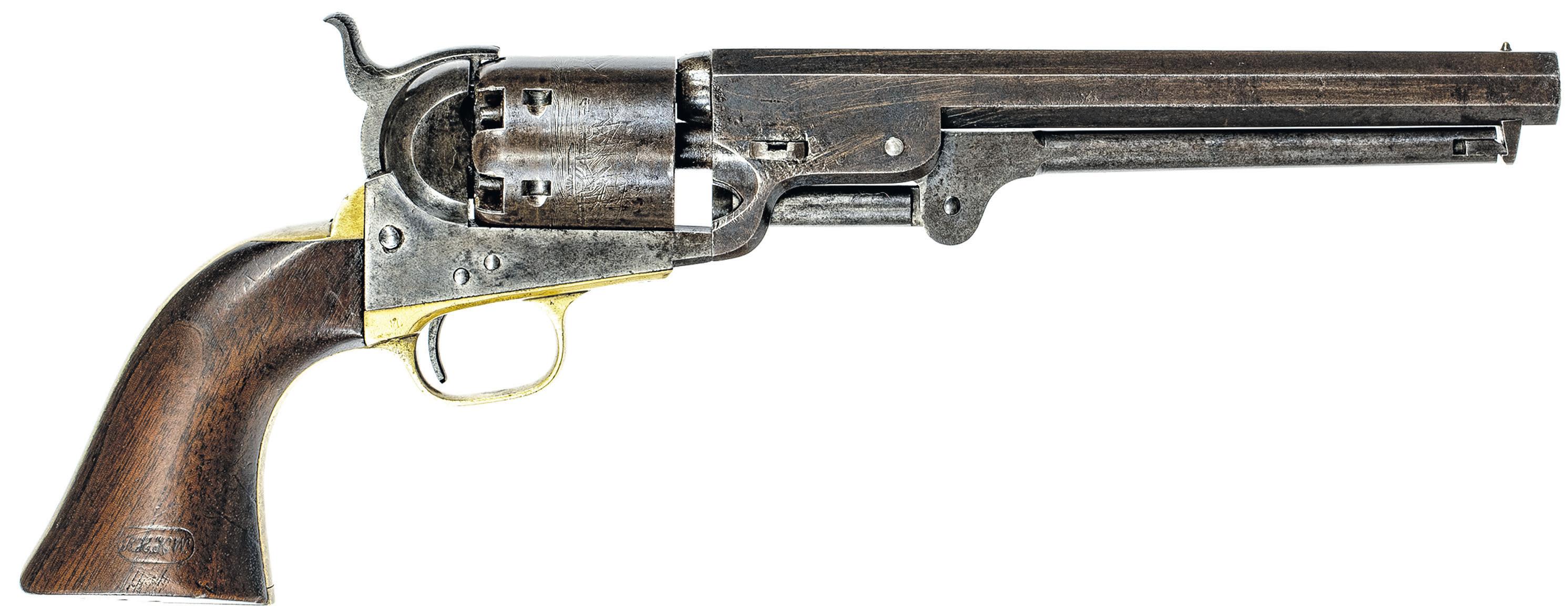
29 May 2020 Civil War News Subscribe online at CivilWarNews.com Digital Archives from 2012 to Current
Close up of the barrel address, also showing part of the Campeche naval battle scene. Reverse view of a
U.S.
military contract Colt Navy revolver.
Obverse detail view of a U.S. military contract Colt Navy, showing the cylinder scene and the script RHKW final inspection cartouche of U.S. Ordnance receiving officer Robert HK Whitely.
Reverse details of the same revolver, showing the various sub-inspection markings, as well as the “US” mark under the Colts Patent mark and the script ADK sub-inspection cartouche of U.S. Ordnance Department inspector Andrew D. King
Obverse view of a U.S. military contract Colt Navy revolver. (All photos by Tim Prince)
Civil War Era Abolitionist, Orator, and Recruiter Resurrected


 by Bob Ruegsegger
by Bob Ruegsegger
Frederick Douglass “dropped dead in the hallway of his residence” on Anacostia Heights in Washington, D.C., on the evening of February 20, 1895. Douglass’ death was completely unexpected. His sudden demise, even at the age of 78, seemed untimely. Thousands gathered to mourn the passing of, arguably, America’s foremost abolitionist.
America’s most celebrated black abolitionist was born into slavery as Frederick Augustus Washington Bailey in Talbot County, Md. He escaped his bonds and fled to freedom via New York. From the Empire State, Frederick Douglass and his bride boarded the John W. Richmond, a steamship that stopped in Newport, R.I., before sailing on to New Bedford, Mass.
For the last six years, Nathan M. Richardson, has been resurrecting the revolutionary abolitionist for the edification of his audiences through living history programs. “I was born and raised in Suffolk, Va.,” said Richardson. “I live one block from Washington Street now, but I was born in a little town called Buckhorn.” Richardson’s friend Shelia Arnold, a “fantastic storyteller,” came to him and suggested that he should consider portraying Frederick Douglass. “I think you could do a really good job,” Arnold told him. “There’s not a lot of African American
men doing living history.”
Richardson was reluctant at first, but after about a year of prodding he began looking at various figures to portray, Booker T. Washington and W.E. B. Du Bois were among his candidates.
“When I saw Douglass, the first thing I noticed, of course, was that his appearance was similar to mine,” said Richardson. “When I started reading his words, I fell in love with the literary style of his words and oratory. That was the beginning of it.”
Most recently Richardson, as Frederick Douglass, had the opportunity to rub elbows with George Buss, as Abraham Lincoln, in the Huntington Room at the Mariners’ Museum in Newport News during a program called “Self-Made Men.” The program explored the backgrounds of both men and their relationship; especially regarding the issue of slavery and the prosecution of the Civil War.
“I started finding out over the last six years just how many things I actually have in common with Frederick Douglass,” said Richardson. “Including the fact that I’m basically a selfmade man, a self-made poet, and now, a self-made historian. I have a lot in common with Frederick Douglass.”
At one time, before Abraham Lincoln became President, Frederick Douglass may have actually been more famous than

Lincoln, especially among the African American population.
“It depends on what particular realm you’re talking about. Of course, in the African American community, Douglass was the leader of the nation, of the people,” said Richardson. “It’s possible from a historical perspective that Douglass was more popular in the 19th century,” he said. “Now that you have the hindsight of 20/20, looking back, what Lincoln accomplished after his death made him the most famous.”
While Lincoln and Douglass were never hostile opponents, they did view the Civil War as it related to slavery from different perspectives. Although Lincoln was opposed to slavery, preserving the Union was his primary objective in waging the Civil War. Douglass passionately maintained that the central purpose of the war ought to be the total and everlasting abolishment of slavery.
They certainly started out, not as adversaries, but certainly with a side-eye at one another,” said Richardson. “They were critical of one another, especially Douglass of Lincoln,” he noted. “After they had an opportunity to meet and feel the character of each person, one for another, they definitely had a great amount of respect for each other.”
For Lincoln, the war was a practical matter. He had to win the war. On the other hand, Douglass had an institution, slavery, that had to be abolished on moral grounds. Ultimately, the Civil War became the necessary vehicle for preserving the Union and eliminating slavery.
Prior to the Civil War, Frederick Douglass was among the most dominant abolitionists in the nation. During the Civil War, Douglass was initially a recruiter and later an advocate for black soldiers.

“Once they got permission from Lincoln’s cabinet to add black soldiers to the fight, he started recruiting,” said Richardson. “Right off the bat, his two oldest sons, Charles and Lewis, joined the 54th Massachusetts Infantry Regiment,” he noted. “Many people don’t know that his youngest son, Frederick Jr., was also in the military. They sent him out to the Mississippi River Valley. He recruited black soldiers out there.”
From the beginning, Douglass campaigned for the recruitment of black soldiers in the Union army. He firmly believed that African Americans would eventually become full citizens,
only after they had participated in the fight for their own liberation. In Douglass’ mind, the Emancipation Proclamation was only a step toward liberty and citizenship. He believed that black Americans would have to earn their freedom and their right to citizenship through violence, violence that came on the battlefield.
“Once let the black man get upon his person the brass letters, U.S., let him get an eagle upon his button and a musket on his shoulder...and there’s no power on earth which can deny that he has earned the right to citizenship in the United States,” observed Douglass.
While Frederick Douglass whole-heartedly stirred black men to enlist in the Union army to fight for their own freedom and the total abolishment of slavery, Douglas, although perhaps tempted, never was willing to answer personally his own call to arms.
Douglass saw black units commanded by white officers. He discovered that black recruits and soldiers were not receiving the same pay as their white counterparts. Douglass learned to his horror that black soldiers who surrendered or were captured were not accorded the status of prisoners-of-war.
30 Civil War News May 2020
Douglass Tribute – This monument stands before the courthouse in Easton, Maryland.
Frederick Douglass had a great recruiting speech for the 54th Massachusetts Infantry. (All photos by Bob Ruegsegger)
While Douglass, the recruiter, had assured prospective soldiers that they, as soldiers, would be treated as equals by their white comrades, the reality was that black soldiers did not receive equal pay. They were paid as laborers rather than soldiers.
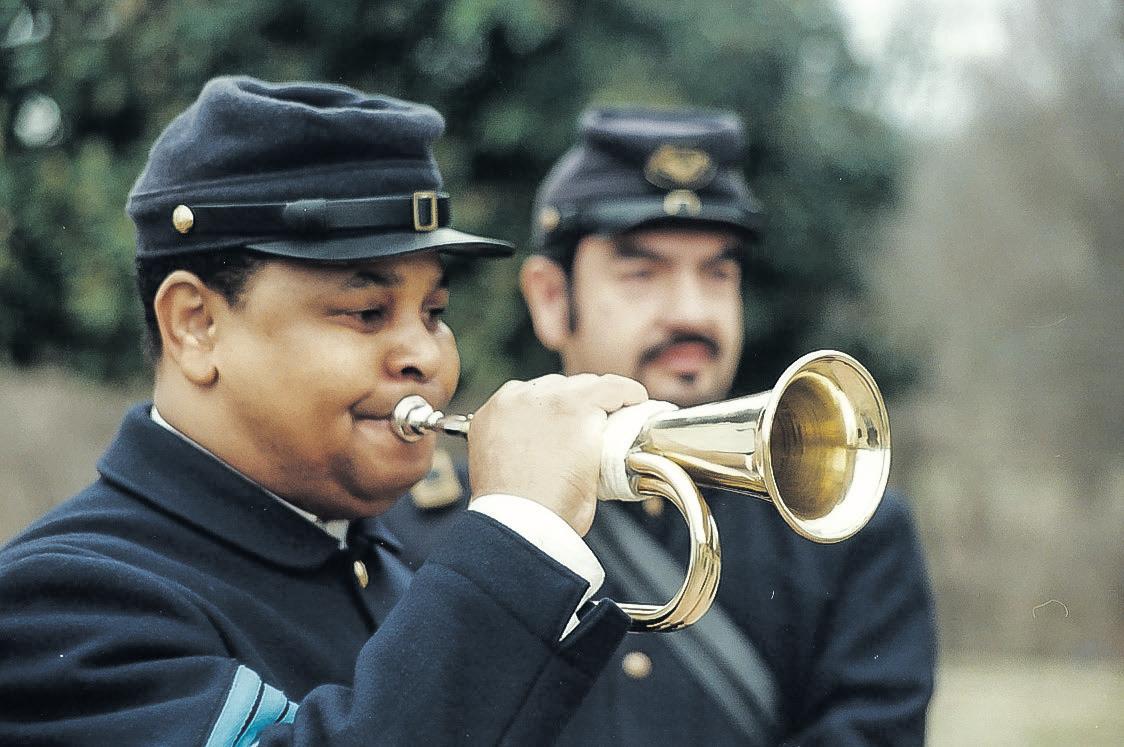
Racism in the army and on the battlefield was a reality. Douglass felt he had betrayed the men he recruited by assuring them that they would be treated equally. He had serious reservations about whether he could with a clear conscience continue recruiting men for the Union army.
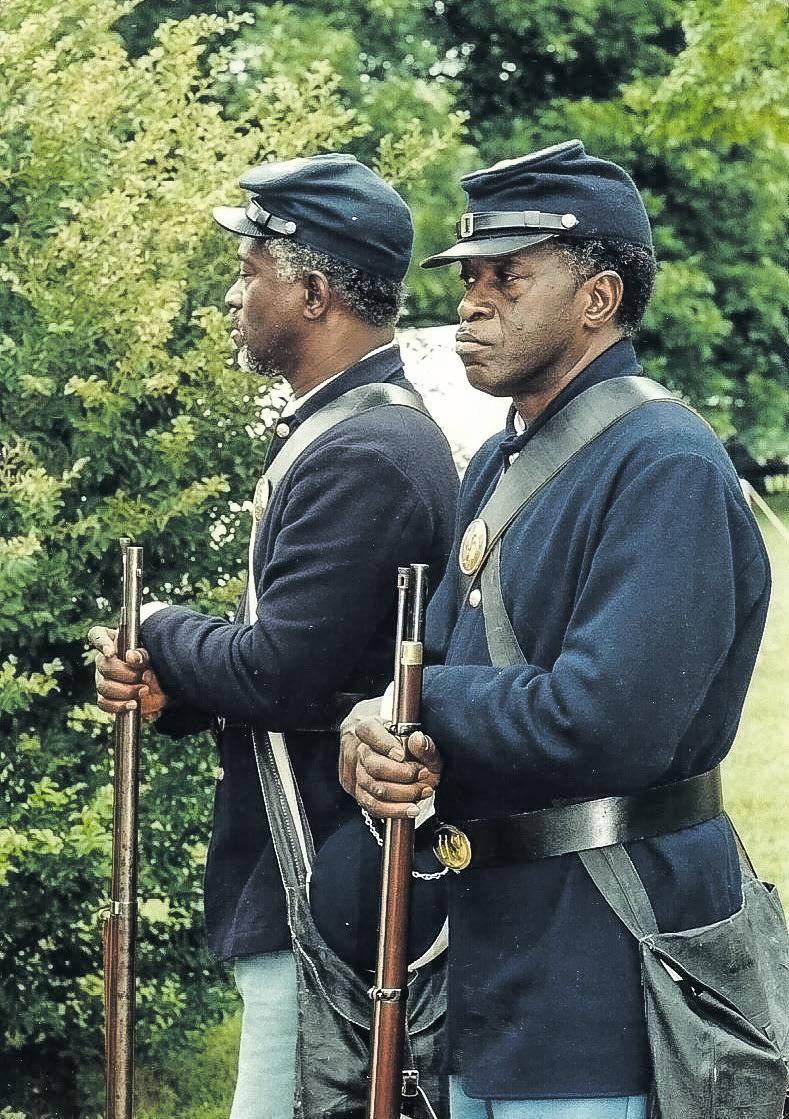
“Douglass had an issue with Lincoln about black soldiers’ pay. That was the catalyst for his first meeting with Lincoln,” said
Richardson. “There were three grievances; one was equal pay, no black officers, and no such thing as a black prisoner-of-war,” he explained. “Most colored men who were captured were executed or sold to the South. So those were the three grievances he brought to President Lincoln for resolution.”

Although President Lincoln couldn’t do a lot about Douglass’ grievances immediately, Lincoln demonstrated that he was a person who would listen to both sides of the argument. He listened intently to Douglass and the answers he gave Douglass were reasonable. “It was not as if President Lincoln were trying to dodge the issues. That first

meeting was what solidified their relationship. It was kind of the honing of their relationship,” said Richardson. “They absolutely respected each other.”
During his presentations, Nathan Richardson carries a cane to represent the gift Mary Todd Lincoln sent Frederick Douglass following President Lincoln’s assassination. The walking stick arrived with a letter from Mrs. Lincoln explaining that the President would’ve wanted him to have the cane out of respect for Douglass as a man and as the leader of his race.

Richardson hopes that his portrayal of Frederick Douglass will provide inspiration for others to follow Douglass’ example in
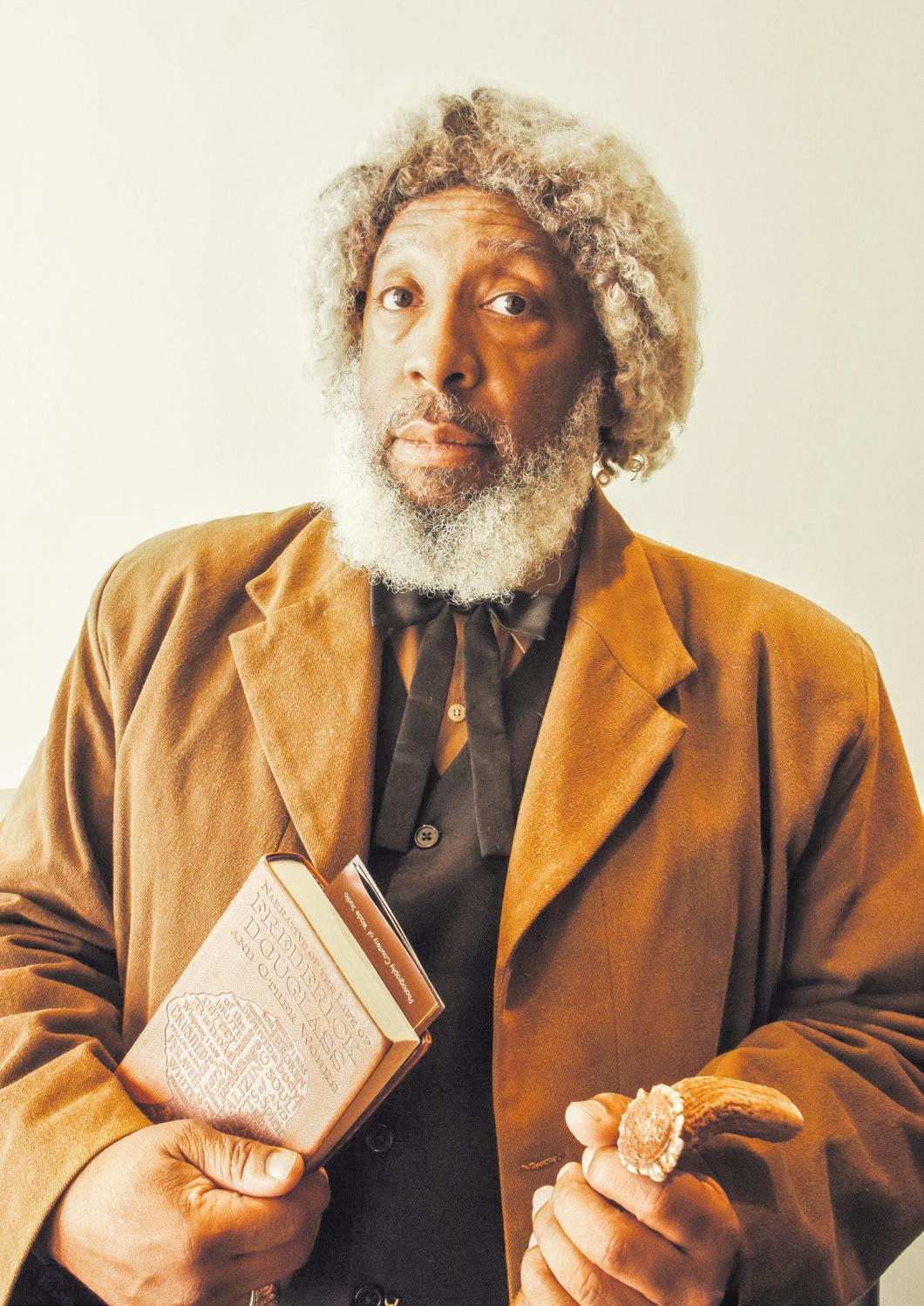
the pursuit of their own “greatness.” “The things that inspired Douglass to be great were the things he was denied. He was denied his freedom. He was denied an education. He was denied citizenship and the right to vote,” noted Richardson. “If you’re looking for inspiration or motivation in the modern era, look for those things that you are being denied,” he said. “Don’t just sit down and take it. Use the First Amendment. Get out there and agitate.”
Bob Ruegsegger is an American by birth and a Virginian. His assignments frequently take him to historic sites throughout Virginia, the Mid-Atlantic, and the Southeast.
His favorite haunts include sites within Virginia’s Historic Triangle—Jamestown, Yorktown, and Williamsburg. Bob served briefly in the U.S. Navy. He is a retired educator and has been an active newspaper journalist for the last twenty years.
31 May 2020 Civil War News
Nathan Richardson
Self-Made Men During the “Self-Made Men” program at the Mariners’ Museum in Newport News, Va.
African American recruits.
USCT Bugler.
USCT Troops.
“Eagle Upon His Button.”
A Revolutionary War
“As the war was prolonged, it inevitably accomplished a revolutionary change in the status and outlook of the colored folk who comprised about an eighth of the population. When John Brown was hanged in 1859 slavery had seemed as strongly entrenched as ever. Had fighting ended in the spring of 1862 it might have survived for years. But it suffered
shock after shock…. By the spring of 1863, with a systematic enlistment of colored troops, the future of the Negro was assured.” – Allan Nevins, in The War for the Union: War Becomes Revolution 1862–1863.
Had the first Battle of Manassas turned out as a Federal victory (as it almost did), or had McClellan
prevailed in the Peninsular Campaign (as he could have), the war’s repercussions would have been quite different than the ones actually experienced. In all likelihood a quick Federal victory would have resulted in restoration of the Union without immediate abolition of slavery, without the enfranchisement of black men, without the

disfranchisement of hundreds of thousands of white men, without profound and immediate social and political upheaval.
The 1863 Emancipation Proclamation and the recruitment of black soldiers spelt revolution. In this column we will examine newspapers and hear some voices of the time commenting on these and related issues. As we have done in previous columns, we turn to the Valley of the Shadow archive for witnesses.
On Oct. 7, 1862, the outraged editors of the Staunton Spectator quoted Paradise Lost and equated the president of the United States with Lucifer.
“The Arch-Fiend in the regions of woe, ‘grins horribly a ghastly smile,’ for he and his emissaries upon earth – the extreme abolitionists – have succeeded in prevailing upon ‘Old Abe’ to issue a proclamation of emancipation which will send a thrill of horror through all civilized nations. He invites the servile population of the South to enact the bloody scene of St. Domingo throughout the limits of the Southern Confederacy.”
“‘Murderer’ is a term of honor compared to Lincoln’s crime,” the Spectator continued. “To this is added the cowardice of employing an agent. To this belongs the additional fact that the agent, when unleashed, is a savage.”
One hundred sixty miles to the north in Chambersburg, even before the September 22 Proclamation, the Democratic newsmen at the Valley Spirit were no less incensed at the prospect of emancipation. The Pennsylvanians on July 30 advocated restoration of “the Union as it was” and opposed “the atrocious and bloody revolutionary programme of emancipating the four millions of slaves at the point of the bayonet….”
The unconstitutional act would hamper the war effort, argued the Spirit, as it would “succeed in arraying the Southern people in a solid phalanx against what they term ‘Abolition Lincolns.’” For them, the Spirit reminded its readers, “it is a matter of life and death.”
In early September the Spirit railed against the radicals, the “miserable charlatans, abstractionists, and theorists” who were forcing their policies on Lincoln. “They had a party programme to carry out. Slavery had to be abolished in the District of Columbia and in the Territories. Confiscation and emancipation bills were introduced and urged with persevering energy and fanatical zeal, regardless of Constitutional objections or injurious effect to the Union cause in
the Slave States….”
Later that month the Spirit reported the miserable charlatans’ success, when Lincoln “issued a proclamation proclaiming unconditional freedom to all the slaves in the seceding States after the first day of January next.” The editors again raised the constitutional issue: “Where the President pretends to find his authority for issuing such a proclamation, he does not deign to tell us.”

Waynesboro’s Village Record expressed a starkly different view on Jan. 9, 1863, after the Proclamation took effect, stressing both the moral and practical aspects of Lincoln’s action. The order “takes away the burden of national death from the hereafter, and makes the country of our children the country of freedom. This is the general thought that pervades the Proclamation; but that which is practical and immediate, is the conversion of this silent, oppressed, and anxious race into active allies of the Union. It adds a reserve force to the army of the Union, and makes three million of slaves three million of able-bodied recruits, who have only to see the Union banner to follow it with their lives. It takes away the labor that sustains the power of the South, and adds to the military power of the North. It is a war measure, and will add strength to our armies and glory to the object of the war.”
The recruitment of black soldiers, like the Emancipation Proclamation, was the subject of vehement debate in the press. In August 1862 the Spirit ran a piece about an Indiana official who emphatically denied a report that his state would provide two black regiments for the army. “I can positively state that negro enlistments would be repugnant in the highest degree to the authorities and people of that State,” the Hoosier official stated, adding that a “measure so distasteful… could not be tolerated by our citizens.”
The following February the Spirit published excerpts from a Congressional debate on this sensitive issue. The “negro soldier bill” proposed by Thaddeus Stevens was, according to a Kentucky member, intended to “entrench [black soldiers] on the soil of the cotton states, and maintain them there, to exterminate or drive off the whites of that section.” A Pennsylvania congressman argued that the enlistment of blacks “would produce demoralization, and the soldiers of the army had said to him that if black men were sent to them they… would leave the service….”
The Staunton Spectator that same month expressed similar
32 Civil War News May 2020
Abraham Lincoln and his Emancipation Proclamation. (Library of Congress)
Let Soldiers in War, Be Citizens in Peace. 24th Regt. U.S. Colored Troops. (Library of Congress) flourishes about the black troops, and comparisons disparaging to our white veterans,” said an article in a July issue.

views and predicted that “as soon as [Northern blacks] come within reach of the Southern army they will be captured and restored to the condition for which Providence designed them.”
On May 11, 1864, the Spirit printed a report of an unprovoked assault on a group of workers in Quincy, Ill., “by a whole company of negro soldiers, with brickbats and other missiles….” There were no deaths, went the report, but “some of the party [were] considerably bruised and injured.”
In addition to reporting allegations of riotous misbehavior, the Spirit expressed incredulity about accounts in other papers of black troops who fought bravely and effectively in battle. “It is scarcely possible to take up a newspaper in the interest of Lincoln and Johnson which does not contain grandiloquent spread eagle

It is interesting to note that most newspaper commentary on the enlistment of blacks is found in papers opposing the policy. As we have seen, the opposition is expressed in incendiary terms and the language is no less incendiary in Pennsylvania than it is Virginia.
On the other hand, the Franklin Repository, the Republican paper, had little to say on this subject. However, in December 1863, the paper ran a long article entitled “Rebel Atrocities.” Chief among the atrocities was “the treatment of our negro troops,” compared to which “all the other atrocities of the war will pale….” Another issue of the Repository included a quote from the Richmond Enquirer: “Should [black troops]
GEORGIA’S CONFEDERATE MONUMENTS

In Honor of a Fallen Nation
Gould B. Hagler, Jr.
This unique work contains a complete photographic record of Georgia’s memorials to the Confederacy, a full transcription of the words engraved upon them, and carefully-researched information about the monuments and the organizations which built them. These works of art and their eloquent inscriptions express a nation’s profound grief, praise the soldiers’ bravery and patriotism, and pay homage to the cause for which they fought.
be sent into the field…none will be taken prisoner – our troops will know what to do.” This, the Pennsylvania editors said, was “frankly admitting that they have been murdered.”
Did the Republican editors calculate that their readers had doubts about the enlistment of blacks? Did they figure that the less said the better, and choose to limit their commentary to what almost any reader would find proper, i.e., that soldiers of the United States, regardless of their race, should not be murdered? In contrast, the Democratic editors pulled no punches in their frequent attacks on Lincoln’s policies and in stark terms laid out the racial issues as they saw them.
The opinions expressed in the Valley Spirit, and the language in which these opinions are articulated, are telling of 19th century racial attitudes. That which would be beyond the pale today was mainstream 150 years ago. It is clear that a great number of citizens saw the issues as the editors of the Spirit saw them, as evidenced by the resolutions adopted at the Pennsylvania Democratic state convention on July 4, 1862.
One resolution is especially noteworthy: “That this is a government of white men, and was
established exclusively for the white race; that the negro race are not entitled to and ought not to be admitted to political or social equality with the white race, but that it is our duty to treat them with kindness and consideration, as an inferior and dependent race; that the right of the several States to determine the position and duties of the race is a sovereign right….”
Another resolution stated “That the party fanaticism…that seeks to turn the slaves of the Southern States loose to overrun the North…is insulting to our race, and merits our most emphatic and unqualified condemnation.”
These resolutions were adopted when the war was in its 15th month. Those who favored restoration of “the Union as it was” continued their advocacy. As late as September 1864, the Spirit wrote that the “only true road to peace and Union” lay in the revival of the Crittenden Compromise, in other words, the return of the seceded states with the institution of slavery left intact. The Republican party, however, “has diverted the war to other purposes, and now declares that the unconditional submission of the rebels can alone end it.” The Spirit argued that if the
people of the Confederate states “were assured that the government of the country would be administered in accordance with the Constitution as our fathers made it, so that it were rendered impossible to interfere with the reserved rights of the States…they would…soon throw their leaders overboard, and gladly to return to the shelter of the Union.”
How realistic was this hope, when the war was in its 29th month, and had become revolution?
Sources:
All the newspapers cited can be found in the Valley of the Shadow archive: http://valley.lib. virginia.edu.
Gould Hagler is a retired lobbyist living in Dunwoody, Ga. He is a past president of the Atlanta Civil War Round Table and the author Georgia’s Confederate Monuments: In Honor of a Fallen Nation, published by Mercer University Press in 2014. Hagler speaks frequently on this topic and others related to different aspects of the Civil War and has been a regular contributor to CWN since 2016. He can be reached at gould.hagler@gmail.com.
www.mupress.org
866-895-1472 toll-free
33 May 2020 Civil War News
48 E. Patrick St., Frederick, MD. 301-695-1864 / civilwarmed.org Divided by Conflict. United by Compassion.
Chris Mackowski
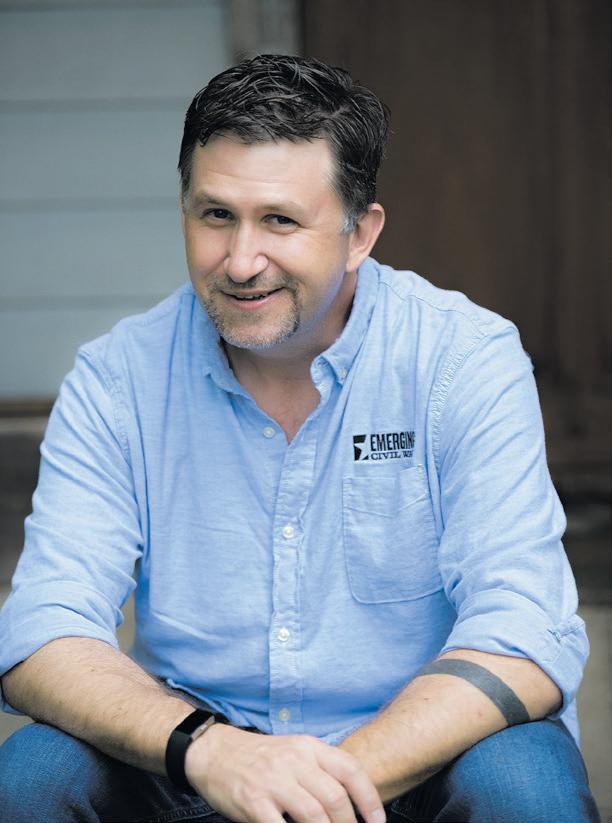
From the Editor
As I sat down to write this month’s column, my daughter called me. She’d just finished up with a doctor’s appointment, and she wanted to give me an update. She’s in the home stretch of pregnancy, and the doctor decided to induce her a couple days early. The COVID-19 pandemic has been putting pressure on hospitals, so the doctor wanted to get the baby delivered and safely home before the pressure on medical services gets any heavier, which is expected.
By the time you read this, Sophie Marie Brand—my first grandchild—will be safely with us. But from where I’m sitting at the moment on a Friday afternoon, Monday’s scheduled induction seems like forever away. Of course, we’ve all waited for nearly nine full months, and we thought we’d have to wait at least another week and a half—her expected due date was March 30, Steph’s one-year anniversary— so the baby is coming sooner than expected. But now that there’s a fixed date, a set deadline, the

ticking of the countdown clock has become exponentially louder.
I am beside myself with excitement about being a grandfather. Because of COVID-related concerns, I’m not going to be allowed to be at the hospital when Sophie is born, as I had planned to be. I probably won’t even get to see her for a few weeks because the doctor wants Steph to limit visitors during the current health crisis. Even if that’s disappointing, I understand. Thank heaven for Skype, I guess!
In last March’s newsletter (https://conta.cc/2FDJvWB), I reflected on Steph’s then-upcoming nuptials in the context of Women’s History Month. “In just a few short days, Steph embarks on a new chapter of her own personal history,” I wrote. Now, a year later, she’s about to embark on the next new chapter. Sophie will be a bit of history all to herself, and I hope she grows up to be a strong woman just like her mother has. (In fact, I joke with Steph that all my plans for revenge are about to come to fruition: she’s about to have a daughter and I hope Sophie’s just like Steph!)
So, here’s to the great women in our lives, young and old. May they continue to make history of their own.
— Chris Mackowski, Ph.D. Editor-in-Chief, Emerging Civil War. Grandfather, Sophie Marie Brand.
Seventh Annual Emerging Civil War Symposium at Stevenson Ridge

With the spread of coronavirus and the declaration of a pandemic, Emerging Civil War wants to updates its readers about the status of the 2020 Symposium. The event is nearly five months away, so we are still all systems go for August 7-9, 2020. Emerging Civil War will continue to monitor and assess the situation and update its readers accordingly. As of right now, though, we are current on schedule for a great event.
ECW News & Notes
Sarah Kay Bierle has been putting in some time and miles for her artillery research. At the beginning of March, she headed for Antietam National Battlefield
to take a look at some artillery positions before the trees leaf out. Speaking of Antietam, Kevin Pawlak has been spending time at the Antietam National Battlefield library and archives doing research on his and Dan Welch’s forthcoming work on Ohioans at the battle. He says he found some neat things, including requisition forms for more ammunition on September 18, 1862!
Meg Groeling is joining the hoarders in rushing to amazonsmile to purchase small bags of Cracker Jacks in bulk. No, she is not afraid of Covid-19 but she is planning for planned presentations on one of her favorite topics--Civil War Base Ball and John Wildey, Colonel Elmer Ellsworth’s aide-de-camp and later the first in a long line of baseball commissioners. Ragin’Jack was a character to be remembered.
Meg also continues to wrestle with the complex and challenging job of sourcing images for First Fallen: The Life of Colonel Elmer Ellsworth, the North’s First Civil War Hero. Meg hates to think about indexing--the horror, the horror!
Dwight Hughes says: “Spring is springing! It’s warming up. Daffodils appear. Flower beds need cleaning up, shrubs trimmed, new plants planted, and grass tended, and our editor is bugging me about deadlines. Uh-oh. What’s a writer/gardener to do?”
The Spirits of Bad Men Made Perfect: The Life and Diary of Confederate Artillerist William Ellis Jones by Constance Hall Jones, part of ECW’s Engaging the Civil War Series, received a nice review in the Midwest Book Review: http://www.midwestbookreview.com/lbw/mar_20.htm#CivilWar. The reviewer called it “An inherently fascinating and impressively informative Civil War biography.”
Chris Mackowski was interviewed for the War Scholar
podcast about Entertaining History: The Civil War in Literature, Film, and Song, which is part of ECW’s Engaging the Civil War Series. You can listen to the podcast here: http:// warscholar.org/?p=1191.
10 Questions...with JoAnna McDonald
JoAnna McDonald is the latest historian to join the stable of Emerging Civil War writers and historians. You can read her full bio here: https://emergingcivilwar.com/2020/03/10/ecw-welcomes-joanna-m-mcdonald.
Your work for ECW thus far has focused on some of the challenges and unique aspects of leadership. What got you interested in that area?
Leadership has always been one of my interests. When I was a young lass, I read I Rode With Stonewall, Lee’s Lieutenants, Grant’s and Sherman’s Memoirs, and many more books in the same genre.

In the last fifteen years, there were two events that specifically triggered my interest in leadership. I had a supervisor who was a toxic leader—think Captain Bligh. Up until then, I did not understand how significant a leader was to an organization. How the leader’s mood influenced the team. Yes, it stank to be on the receiving end of this individual, but after many years of discussing the situation, I understand her lack of leadership had nothing to do with her being a woman. It had to do with her not being trained, probably having one or more not so nice mentors, and then her being a miserable persona. The second incident that influenced my interest in leadership occurred when I was deciding the subject for my Ph.D. dissertation. I thought I would research Human Intelligence and Technology, but I had no contacts with the U.S. Army’s intelligence community. I had already been researching Lee, so I went to Dr. Richard Sommers to discuss my idea of writing a dissertation on his grand strategy and strategic leadership. The rest is history (pun intended).
You have described yourself as a “hybrid historian.” What do you mean by that?
My blogs are written using a pedagogical (analytical) voice
and a narrative voice. Usually, historians write either/or. I also combine history with the study of military theory and leadership. This allows me to place military theory concepts and leadership mechanics into historical context. It’s a unique approach, and some academics out there downright wouldn’t like it. In fact, I read a book on the Iraq War by a military theorist/strategist and he said in his introduction “I am not a historian.” I laughed. I wanted to ask this author: how do you know your theories work without historical context. I didn’t do it. Unlike this author, I’m not writing for the academics. My audience is the general public. When you see specific military theory or leadership concepts in a historical arena, you get a better sense at how winning a war or leadership works or doesn’t work.
So, analytical historian is the canary in a coal mine in me; explaining military theorist/leadership principles for the general public is the instructor in me, and a narrative historian is the bard in me: Hybrid Historian
Two of your mentors were Jay Luvaas and Richard Sommers—two great military historians. What’s one lesson each of them passed on to you?
Foremost, Luvaas taught me humility. He taught me that this (the writing, instructing, and speaking) is not about the individual historian; it is about helping to light the path ahead for the present and future generations. I also learned the importance of mentoring the younger generations.
Sommers taught me the importance of work ethic, although I don’t try to compete with his at all. I think the only one who would come close to having the same work ethic as him is Robert E. Lee.
Sommers also taught me patience, understanding, and forgiveness. My 130-pound German Shepherd, “Sherman”—named for the major general—almost attacked one of Dick’s little Boston Terriers. It was horrifying. I love animals. Fortunately, I had learned to do rodeo tackles with my Sherman and got him under control. Phew!
Military history tends to be a male-dominated field. Is there anything particularly challenging about being a woman in that field?
34 Civil War News May 2020 www.emergingcivilwar.com
Digital Issues of CWN are available by subscription alone or with print plus CWN archives at CivilWarNews.com
JoAnna McDonald
At press time: Chris’s granddaughter, Sophie, arrived safely on March 24.
At 5’ nothing, I can’t see over the podiums.
No, I don’t really think about challenges or that I’m a woman in a male-dominated field. Luvaas and Sommers always, from day one, treated me as a “fellow student” of military history/Civil War/military studies. When Dr. Luvaas signed his Staff Ride to Gettysburg book, co-authored with Hal Nelson (Brig. Gen. USA Ret), Luvaas wrote, “to a fellow student of the Civil War.” I just happened to be a woman.
You’ve got a great sense of humor (which we get to see a bit more behind the scenes than readers might otherwise get to see). How does that inform your work as a historian?
The study of human conflict is downright depressing, especially if you think about it too much. Combat is gross. Warfare, though, has to be studied. It’s like cancer. You have to understand it. My humor allows my brain to go into a horrible dimension and come out without going insane.
I will probably reveal more of my sense of humor in the special blogs you ask for from time to time. Like the one I am finishing up on “a woman who’s had an important impact on you and your development as a Civil War historian.”
Lightning Round (short answers with a one-sentence explanation)


Favorite primary source?

O.R.s
Favorite Civil War-related monument? Irish Brigade 63rd, 69th and 88th New York Infantry 14th New York Independent Battery, Sickles Ave, Gettysburg, PA 17325. It is a Celtic cross with an Irish wolf hound mourning the brigade’s dead.
Favorite unsung hero of the Civil War era? Henry Hunt for Union and Fitzhugh Lee for the Confederates.
What’s a bucket-list Civil War site you’ve not yet visited? Chattanooga (technically any western battlefield; grew up in the east. just have not taken the time to stop and visit them).

Favorite ECWS book?
A Season of Slaughter by Mackowski and White (and Mackowski didn’t pay me to put his book down). It was informative, without being overwhelming, well written, easy to read and quick paced.
on the streets of Boston in what became known as the Boston Massacre. The 250th anniversary just passed, and ERW historian Mark Maloy was present. Check out ERW’s Facebook page for the videos: https://www.facebook.com/856481164469545/ videos/213635499825056.
Five years later, on March 23rd, Virginia delegate Patrick Henry rose at the Second Virginia Convention and uttered the words that would become a rallying cry, “Give me liberty, or give me death.”

For more great Revolution-era history, stop by our blog, www.emergingrevolutionarywar.org.



Speakers Bureau Spotlight
Kristen works with the Missouri Civil War Museum at historic Jefferson Barracks in St. Louis. She splits her time between Missouri and Northern Virginia. You can read her full ECW bio here: https://emerging civilwar.com/author-biographies/ authors/kristen-m-pawlak.

CHARLESTON IN THE WAR
CHARLESTON IN THE WAR
100 Signi cant Civil War Photographs: Charleston in the War features newly restored images of scenes in the famed city, taken 1860–1865. e cameramen include the better-known, such as George N. Barnard and George S. Cook, as well as some lesser-known ones: Samuel Cooley, Charles Quinby, the partners Haas & Peale, Osborn & Durbec.


100 Signi cant Civil War Photographs: Charleston in the War features newly restored images of scenes in the famed city, taken 1860–1865. The cameramen include the better-known, such as George N. Barnard and George S. Cook, as well as some lesser-known ones: Samuel Cooley, Charles Quinby, the partners Haas & Peale, Osborn & Durbec.
Kristen Pawlak
This Means War: The Battle of Wilson’s Creek Lincoln’s Forgotten Emancipator: Senator John Brooks Henderson of Missouri.


Text by Stephen Davis and Jack Melton accompanies each featured photograph, describing the pictured scenes and the history surrounding them. e selected images depict a variety of settings: that portion of Charleston known as e Battery, the “Burnt District” (the area of the city destroyed by the Great Fire of December 1861), the Charleston Arsenal, and the many churches that allow Charlestonians to call theirs “the Holy City.” Special sections of this book are devoted to the huge Blakely guns imported from England by the Confederates and close-ups of Barnard’s views.
Text by Stephen Davis and Jack Melton accompanies each featured photograph, describing the pictured scenes and the history surrounding them. The selected images depict a variety of settings: that portion of Charleston known as The Battery, the “Burnt District” (the area of the city destroyed by the Great Fire of December 1861), the Charleston Arsenal, and the many churches that allow Charlestonians to call theirs “the Holy City.” Special sections of this book are devoted to the huge Blakely guns imported from England by the Confederates and close-ups of Barnard’s views.
e history of Civil War Charleston goes back to e Defense of Charleston Harbor (1890) by John Johnson, Confederate major of engineers, and to Reminiscences of Forts Sumter and Moultrie in 1860-’61 (1876) by Capt. Abner Doubleday, Federal second-in-command. Since then Charlestonians have contributed to the history of their city, notably Robert N. Rosen and Richard W. Hatcher III. e historical text surrounding 100 Signi cant Photographs draws on these and other works.
The Henderson talk coincides with a book I am writing to raise proceeds for the historic renova tion of his home in Louisiana, Mo., by the Missouri Civil War Museum.
A unique feature is its reliance upon the writings of actual participants, such as Augustine T. Smythe (1842–1914) and Emma Edwards Holmes (1838–1910).
As a contribution to this literature, 100 Signi cant Civil War Photographs: Charleston in the War o ers rewards for all readers, from the casual novice to the serious student.
The history of Civil War Charleston goes back to The Defense of Charleston Harbor (1890) by John Johnson, Confederate major of engineers, and to Reminiscences of Forts Sumter and Moultrie in 1860-’61 (1876) by Capt. Abner Doubleday, Federal second-in-command. Since then Charlestonians have contributed to the history of their city, notably Robert N. Rosen and Richard W. Hatcher III. The historical text surrounding 100 Signi cant Photographs draws on these and other works. A unique feature is its reliance upon the writings of actual participants, such as Augustine T. Smythe (1842–1914) and Emma Edwards Holmes (1838–1910).
As a contribution to this literature, 100 Signi cant Civil War Photographs: Charleston in the War o ers rewards for all readers, from the casual novice to the serious student.
March is a symbolic month in American Revolutionary Era history. On the 5th of this month in 1770, blood was shed
IN

160 pages, Over 100 Photos, Maps, Index, Bibliography, Softcover. ISBN: 978-1-61850-167-7
$19.95 + 3.50 S&H Order online at www.HistoricalPubs.com or call 800-777-1862
35 May 2020 Civil War News Deadline for submissions is the 20th of each month. Email: ads@civilwarnews.com Want to Advertise in Civil War News? Email us at ads@civilwarnews.com Or Call 800-777-1862 Subscribe at CivilWarNews.com
DAVIS & MELTON 100 SIGNIFICANT CIVIL WAR PHOTOGRAPHS CHARLESTON
THE WAR
Stephen Davis JACK W. MELTON JR.
by John A. Punola
Legend has it that sometime in the latter part of June 1863, a pair of Union supply wagons departed Wheeling, W.Va., entered the state of Pennsylvania loaded with 50 bars of Union gold, destined for Harrisburg, Penn. From that juncture the gold bars were to be shipped to the Philadelphia Mint for conversion into gold coins for Union Army which had not been paid in several months. I do not believe that was the motive; the Union Army did not pay soldiers with gold coins.
The summer of 1863 was a time of discontent in the North and the state of Pennsylvania had grown tired of a war that was producing horrendous casualties.

Introduction of a military draft was facing strong opposition in


Lost Yankee Gold in Pennsylvania 1863



a Civil War program, I counted four Confederate flags mixed among the American flags, one a very large one.
planned diversionary tactic to draw attention to a highly visible target while the actual shipment followed another, shorter route?
central Pennsylvania with added concerns of Confederate raiders, the forerunners of Robert E Lee’s army, approaching southern Pennsylvania. This was the supposed reason for the gold shipment taking the long northern route to reach Harrisburg, Penn.
I was born and raised in southwestern Pennsylvania and had an interest in learning more about this incident. I knew from the days of the 1792 Whiskey Rebellion in Washington County, a rebel attitude towards the American government had developed which persisted into 1863 and there were die hard Confederates in the area. As a youth living in Washington County, it was not uncommon to see a sprinkling of Rebel flags on holidays. In fact on Oct. 16, 2018, going to present


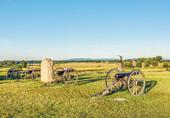


As I continued my investigation, I studied numerous stories, versions, and accounts of the legendary gold shipment; there were a lot of questions and few answers. For instance, where did the gold bars in Wheeling, W.Va., come from? The region is rich in steel and coal, but not gold; there was no reason for the presence of a mint or coinage? Where did the Union military transport originate? A shipment of enormous value would require adequate security; the gold bars would have been too heavy for a single wagon. The gold probably was loaded twenty-five bars per two horse team, 1,375 pounds each wagon.
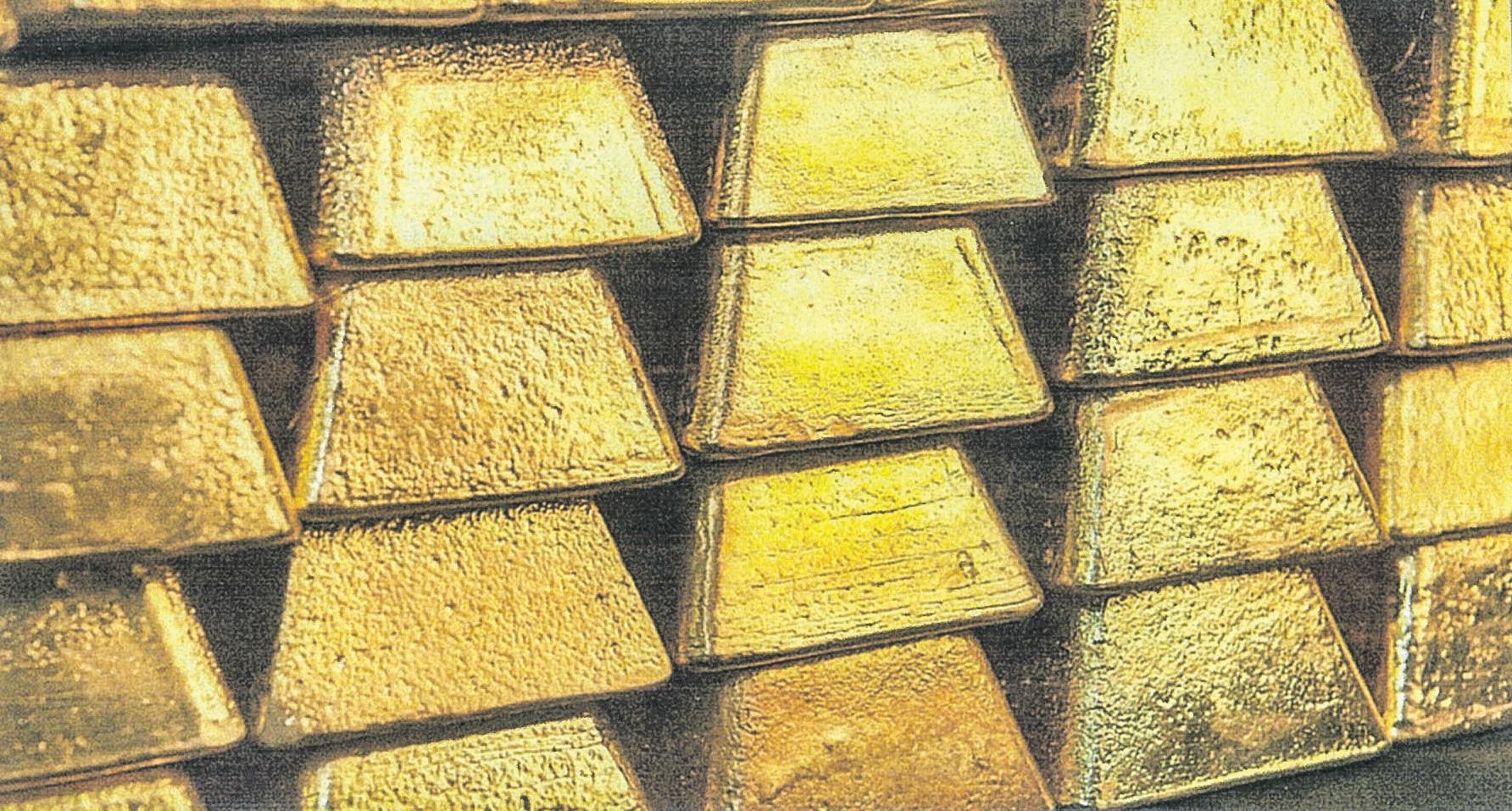
The two-horse wagons were projected to travel 2.5 miles per hour, based on an eight hour day, depending upon road conditions and whether any obstacles were encountered. Remember, in 1863, roads required for the northern route were scarce as the region mostly undeveloped. A good scout was a must; a person named Connors was the civilian trail guide. His name appeared as the gold moves eastward but he was not identified as being with the wagons when they departed from Wheeling, W.Va.
The logistics confronting the wagons, the guide, and ten soldiers was a serious concern. The Union Army’s logistics manual called for daily rations to equal 4.5 pounds of edible foods plus an adequate water supply per man; for horses, daily rations for two horses were 25-30 pounds of feed per horse, plus water. June and July are hot months in Pennsylvania and a quality water supply was critical to the health of the horses. This journey required a highly managed logistics team which I doubt was the case.
The two wagons would have been an easy target should they encounter a Confederate scouting party, or well-armed outlaws. Standard colors for Union freight wagons were a colorful Union blue, large red wheels, covered with white canvas. The small group would have been visible the entire journey and an ambush by Confederates or outlaws could have been quick and deadly. Was this two wagon convoy a cleverly
The first leg of the trip from Wheeling, through Washington County, to Pittsburgh, Penn., was uneventful; after a brief stop the wagons resumed their mission. Their first stop was the thriving community of Butler, Penn., where the troops were surprised by the lukewarm reception. Antiwar residents contained some folks with Copperhead connections; the wagons quickly departed for Clarion, Penn. At this point, the commanding officer, Lt. Castleton, developed a severe fever and rode in one wagon.
The trip to Clarion was uneventful, and the group was warmly greeted by the town’s people. Lt. Castleton was still suffering from fever when the wagons continued to the next destination; here he revealed their cargo and further travel plans to his men. When the group reached St. Marys, Penn., Lt. Castleton was unable to continue, and the civilian Connors was given control. His destination was Driftwood, Penn., located on the Sinnemahoning River. Rafts would be constructed so they could drift down the Susquehanna River, then float on to Harrisburg where they would make the final delivery to the mint.
The wagons continued onward to Dents Run, Penn., where according to Connors, the group was ambushed and quickly killed, except Connors who hid and then managed to escape. He made his way back to St. Marys, where he reported the fate of the men and the contents of the wagons. In



my research, I was not unable to find any military record of a Lt. Castleton, or Connors, his civilian guide, nor could I locate any Treasury Department officials who signed the order to move the gold that is still missing.
Questions that remain are whether the alleged gold bars were in the missing military supply wagons, or was it a diversion? Did the ambush occur? Where is the report of the ambush? Eventually the bodies of the soldiers were found and buried but there is no record of this nor are their graves known. The Army had serious doubts about Connors’s statement, and Pinkerton detectives sent to interview him and find the missing gold were also unsuccessful.
The legend of the lost gold remained quiet although there were occasional reports that treasure hunters were still looking for positive clues regarding the actual location of the gold bars. Then a father and son team from the town of Clearfield, Penn., Dennis Parada and son Kem, operating under the legal name of Finders Keepers founded in 2004, revived interest in the legendary lost gold. The Paradas told me they came into possession of a hand drawn map that was supposed to reveal the treasure’s location. Extensive searches were conducted that produced some Civil War era items, but the search failed to locate any gold bars or valuables. The lack of success working from the map did not curb the gold hunter’s dreams; they continued to search the area. When I interviewed Dennis and Kem, they still believed the map showed where the lost gold was located and secured
36 Civil War News May 2020
The gold bars that journeyed through Pennsylvania in June 1863, are still missing. They might have looked similar to these gold bars. If you find them, you are required to return them to U.S. Treasury Dept.
Historical Publications, LLC Civil War News • 800-777-1862 520 Folly Road, Suite 25 PMB 379 Charleston, SC 29412 www.CIVILWARNEWS.com UP-TO-DATE COVERAGE • PRESERVATION NEWS • BOOK REVIEWS SHOWS, LIVING HISTORY AND REENACTMENTS • HISTORICAL ARTICLES MONTHLY COLUMNS • CALENDAR OF EVENTS STAY INFORMED! Only $38.50/One Year • $66.00/ Two Years THE MONTHLY CURRENT EVENTS NEWSPAPER -FORCIVIL WAR ENTHUSIASTS SINCE 1974 12 ISSUES PER YEAR PRINT & DIGITAL EDITIONS AVAILABLE CALL OR SUBSCRIBE ONLINE TODAY! 2018 CW N 44, $3.50 America’s Monthly Newspaper For War Enthusiasts our have acres states! County, Friends Mountain Civil War Trust’s Path to Preservation CW N 44, No. Pages, Civil War News America’s Newspaper War Enthusiasts Holzer Dancing Inside this Smoke people visit and town industrypeople spirits. mightthen departedplace eating 1863. 1797, McClellan’s ghosts nursed woundedballroom. GettysburgRemembrancePenn., Mo., beenRemembrance the featuresmeant slight meantime, please ball. Dancing the Night Away at the Gettysburg Hotel Poretsky he Lincoln Scholar Harold Holzer’s Oration at the 154th Anniversary of the Gettysburg Address Gettysburg spot—in Abraham one;one clutchingliftingAmerican becauseDouglass history,” hadduring men read great today, been politically some, kneeling believeDespiteroiling country.remember Gettysburg mightgallery,values, elevated let’s secessionconsideredequal—remained reckoning have Today,speech own, other statues Ball held INSIDE EVERY ISSUE
The proposed route of the Union gold shipment. The wilderness trail via north central Pennsylvania perhaps was a diversion to fool the Confederates or bandits from stealing the Union gold.
improved tools they would use in the resumption of the gold search.
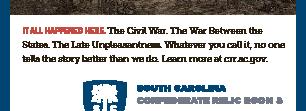

The map included an area situated near Dents Run, located within Elk State Forest. Dennis and Kem were unaware that Dents Run was inside Elk State Forest until after their hunt. Knowing this, Dennis and Kem traveled to the Park Office to report their illegal search and recovery. They delivered all the recovered, presumed Civil War, artifacts to Elk State Forest District #13 so they could examine and classify the artifacts found and removed by Dennis and Kem.
The final conclusion was that nothing of value was found, and the finds were returned to the Parada team. The worst news from the Elk Park District #13 was that NO DETECTING/SEARCHING will be PERMITTED in the state park. Dennis & Kem Parada could no longer pursue their dream of searching an area that their intuition told them was the location of the long missing gold bars. It was all very depressing but the Finders Keepers LLC had steadily grown, and other targets of opportunity now held their attention.
In March 2018, the local Dents Run population witnessed a large group of personnel who





established a base camp and various kinds of salvage equipment arrived. Preparations were made, and the workers began a physical search of the area. The group was identified as FBI employees who were conducting a “court authorized law enforcement activity”; the search area was off limits to all local residents and outsiders. Strict security regulations were enforced by the FBI, and no persons were permitted to enter the area while workers and heavy equipment was involved. Once the FBI was satisfied their activity was completed, they packed and quietly slipped away.
With little hope of any change in the restrictions within Elk State Forest Park, Finders Keepers LLC moved toward building a list of target areas within Pennsylvania that will be actively searched the summer of 2020. They have an interesting variety of projects such as a Paleo-Indian site, a Knights of the Golden Circle site, an 1812 Spanish silver site, plus 1,500 gold coins from an 1812 fur trading site. These targets are undergoing research and will be activated as weather conditions permit.


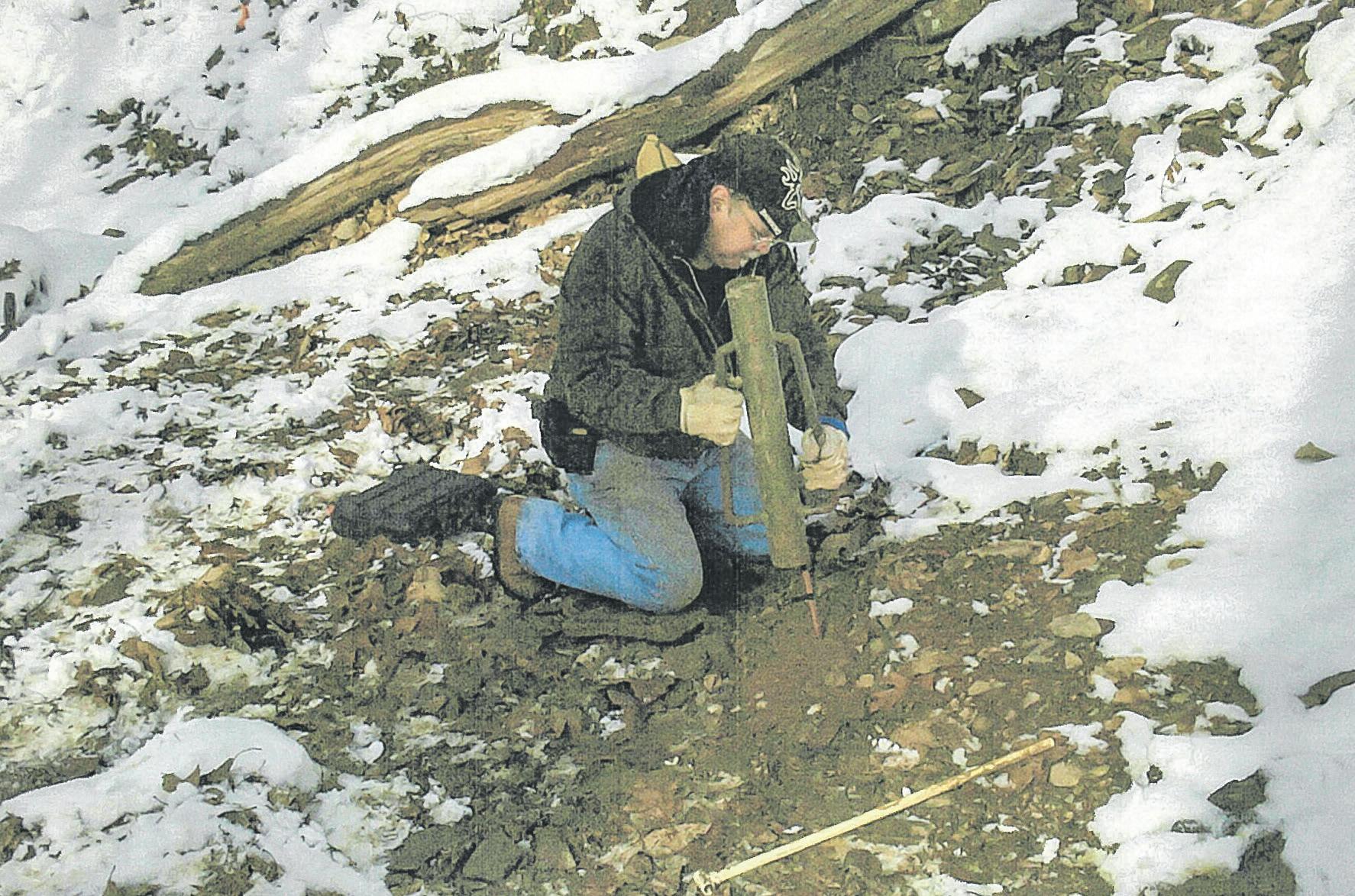
Dennis Parada said “it’s not always about what we find that keeps us going; it’s the hunt itself
and the adventure of having a lot of fun; that folks, is the real treasure.” Not being content with Pennsylvania, Finders Keepers have established excellent relations with interested Canadians who have offered the opportunity of looking for and finding historic targets in Canada. The future looks very bright for Dennis Parada and his son, Kem. They will be on the road of adventure this summer.

Getting back to the matter of “Yankee gold” in Pennsylvania, it’s been a long time since 1863, and still no official documentation of the alleged missing gold bars on their journey through Pennsylvania. It is my feeling that if there were a wagon load, or loads of gold, it probably had a safe boring journey via another route through Pennsylvania. I did search in some Confederate sources hoping to find some Confederate references to capturing this prize, but like the gold seekers in central Pennsylvania, I found nothing; still, it was enjoyable looking for the answers.

The beautiful photo of what the 1863 Union Army supply wagon would have looked like was submitted by the National Park Service, Fort Davis, Texas. Thank you Bill Manhart.

37 May 2020 Civil War News Deadlines for Advertising or Editorial Submissions is the 20th of each month. Email to ads@civilwarnews.com
Kem Parada, of Finders Keepers LLC, locates a metal target and is pinpointing his probe to identify location and depth of the target. Kem and his father Dennis are year round treasure hunters. This is a recent photo of Pennsylvania covered in snow.
This is what an 1863 Union army supply wagon looked like, brightly painted red, white, and blue. It was pulled by either two horse, or two mules, as it supposedly did hauling Union gold through Pennsylvania. (NPS Fort Davis, Texas)
CIVIL WAR BOOK,___ B mv 11:
Civil War News book reviews provide our readers with timely analysis of the latest and most significant Civil War research and scholarship. Contact email: BookReviews@CivilWarNews.com.


Diary of a Confederate Artillerist
The Spirits of Bad Men Made Perfect: The Life and Diary of Confederate Artillerist William Ellis Jones. By Constance Hall Jones. Maps, Photos, Appendix, Additional Online Appendixes, Notes, Bibliography, Index. Pp. 252. 2020, soft cover. Southern Illinois University Press, www. siupress.com. Softbound. $26.50

Reviewed by John Michael Priest
MYTH: Black Confederates?
Searching for Black Confederates: The Civil War’s Most Persistent Myth.
 By Kevin M. Levin. Photos, notes, bibliography and index, 240 pp. University of North Carolina Press, 2019. Hardbound. $30.00.
By Kevin M. Levin. Photos, notes, bibliography and index, 240 pp. University of North Carolina Press, 2019. Hardbound. $30.00.
Reviewed by Charles
 H. Bogart
H. Bogart
The diary comprises about 1/3 of the entire book and has some very good information on Crenshaw’s Battery from March 14, 1862, through December 31, 1862. It is well written and has a lot of material about the officers, whom Ellis had a propensity to criticize, the young women in the vicinity of Richmond, the food, of course, some good observations about Gaines’ Mill, and the aftermath of Second Manassas. He mentions in passing the battery wearing blue uniforms. He paid attention to small details: General “Stonewall” Jackson, walking with his face glued to the ground and looking more like a farmer than a general; a young artillerist weeping violently as his friends buried his brother; ghastly corpses grotesquely lying along the roadside.
The Spirits of Bad Men Made
Perfect has so much more in it than Jones’s diary. Ms. Jones, in fleshing out her relative’s life, has compiled a thoroughly researched documentary of the Welsh immigrant experience in antebellum Richmond and how this particular family became part of the city’s merchant elite. She describes the role of slavery in the area’s economy, and does not excuse or defend William E. Jones’s attitude toward African Americans. Nor does she hesitate to describe how Jones’s immediate family and his employer stockpiled war commodities beyond the reach of the Confederate government in an attempt to avoid the destruction of their family and business assets during the war.
Jones started in book binding and editing before the war, then continued the trade afterward. While allegedly reconstructed, he actively supported and published
The Southern Historical Society Papers which, while they contain some very good accounts by veterans, also, with The Southern Bivouac and Confederate Veteran actively touted the “Lost Cause” mythology of the “Old South.”
The book surprised me. Objective, thoroughly detailed, and rich in social and political history, I found it illuminating and thought provoking.
Mike Priest is author of Antietam: The Soldiers’ Battle (1989) and Before Antietam: The Battle of South Mountain (1992).
Deadline for submissions is the 20th of each month. Email: ads@civilwarnews.com
services to the Confederate Army while at other times they were impressed. The slaves’ pay often did not go to them but to their owners. Blacks were also employed by the Confederate Army as regimental cooks and musicians. However, except for some Black company-sized infantry units formed at Richmond, Va., during the last months of the Confederacy, the author was unable to identify any Black Confederate infantry, cavalry, or artillery units that saw active service. He does give credence to Blacks helping to service artillery pieces during the war’s early months, but once the Emancipation Proclamation was issued, the war goals for the Blacks within the Confederacy changed; no longer were their main concerns to show loyalty in hopes of a postwar improvement in their lot. To report that during the war Blacks “carried muskets alongside their masters into battle” does not indicate that these Blacks were soldiers.
confirm their place with the regiment, while those Blacks seen with the Confederate Army carrying weapons on the march were carrying regimental equipment not personal arms. The author notes that Blacks who served as camp servants were not carried on the rolls of the Confederate Army as they were considered personal property; thus their care and discipline were their owner’s responsibility.
For the past sixteen years since my retirement, I have been a tour guide at our local Civil War battle site, Fort Boone. A trend I have noted over the years is that after I mention that USCT soldiers were stationed in Frankfort, I will be told about the Blacks who freely served in the Confederate Army. The number of these Blacks serving in the Confederate Army has escalated over the years from tens of thousands to a half of million or more. From what I have learned from some recent visitors concerning the number of Blacks in the Confederate Army, I have come to understand that whites were actually a minority in the Confederate Army.
In this book, Kevin Levin delves into the question “Did Blacks serve in the Confederate Army, if so in what capacity, and did they serve freely?” The answer he provides is either a “yes” or a “no,” depending on how one defines service in the Confederate Army. The author finds that the story about Black Confederate infantry companies and regiments that stood shoulder to shoulder with their white masters in the battle line began to formulate in the 1970s as part of a White Supremacy pushback to the Civil Rights movement.
The author’s research confirmed that 100,000s of free and enslaved Blacks performed engineer, quartermaster, ordnance, medical, and transportation duties in support of the Confederate Army, but not as combatants on the battlefield. At times, these Blacks freely offered their
In 1861, when the Creoles of New Orleans formed the 1st Louisiana Native Guard, their service was refused by the Confederate government. Then, when the Mobile Creole community offered to form a militia unit to defend Mobile in 1863, their offer was refused. Confederate Secretary of War James Seddon wrote back that “our position with the North and before the world will not allow the employment of armed soldiers of negros.” In 1863, Arthur Fremantle wrote the following about the idea of the Confederacy recruiting Black soldiers: “I do not imagine that such an experiment will be tried, except as a last resort.” During 1864, as the enlistment of Blacks was discussed in the Confederate Congress, one congressman stated, “If we offer slaves freedom [if they join the Confederate Army] we confess that we are insincere and hypocritical in saying slavery was the best state for the negros.”
The author contends that those Blacks seen with the Confederate Army, dressed in Confederate uniforms, were so dressed to
The book is well-worth reading as it is an interesting examination of the question of whether Blacks served in the Confederate Army. The answer is NO if one’s answer is based on whether they served as enlisted soldiers in the infantry, artillery, or cavalry. The answer is a very qualified YES if one considers the Confederate Army’s employment of Blacks in military support roles. A VERY qualified YES, for while these Blacks did provide direct support to Confederate field armies, they were not subject to army discipline and their pay went to their owners. To put the question of whether Blacks served in the Confederate Army in modern context, it depends upon how you answer the following question:
“Are American private contract workers, who support the U.S. Army in Iraq, members of the United States Army since they dress like American soldiers, drive vehicles that look like U.S. Army vehicles and, at times, engage in gun battles with the locals?”
Charles H. Bogart has a BA from Thomas More University and an MCP from Ohio State University. He is employed as a tour guide at the Fort Boone Civil War Battle Site in Frankfort, Kentucky, serves as President of the Frankfort Civil War Roundtable, and is a board member of the Kentucky Civil War Roundtable. He has written a number of books and articles on military and naval history.
38 Civil War News May 2020 Subscribe online at CivilWarNews.com
Apostle of Aboli-
Owen Lovejoy and the Coalition For Equality. By Jane Ann Moore and William F. Moore. Notes, bibliography, index, University of Illinois Press, www.press.uillinois.edu, 2020, 254 pp., $28.00 softcover.

Reviewed by Wayne L. Wolf
Liberty Party, preached against the Fugitive Slave and Black Exclusion Acts, and began solidifying his own future political career. By 1857 his religious vision and political goals merged. Having been elected to Congress, he quickly established himself as a radical anti-slavery Republican whose keen wit and practical wisdom would be marshaled to pursue abolition and equality, the dream he held since the murder of his brother Elijah.
After serving a brief stint as a colonel in the Civil War, he returned to Congress and by his death in 1864 saw slavery abolished in the District of Columbia, public school funds used to educate black children, the Second Confiscation Act signed, recognition of Haiti and Liberia, and passage of the Homestead Act. While he did not live to see the passage of the 13th, 14th, and 15th Amendments, he was hailed as the inspiration behind all three.
New Unit History Looks Into Important Role of Scouts, Couriers, and Guides
Lee’s Body Guards: The 39th Battalion Virginia Cavalry. By Michael C. Hardy. Photos, notes, index, appendix (roster), 168 pp., paperback, 2019. The History Press, arcadiapublishing.com. $21.99.

Reviewed by Tim Talbot
overlooked and previously under examined aspect of the Army of Northern Virginia.
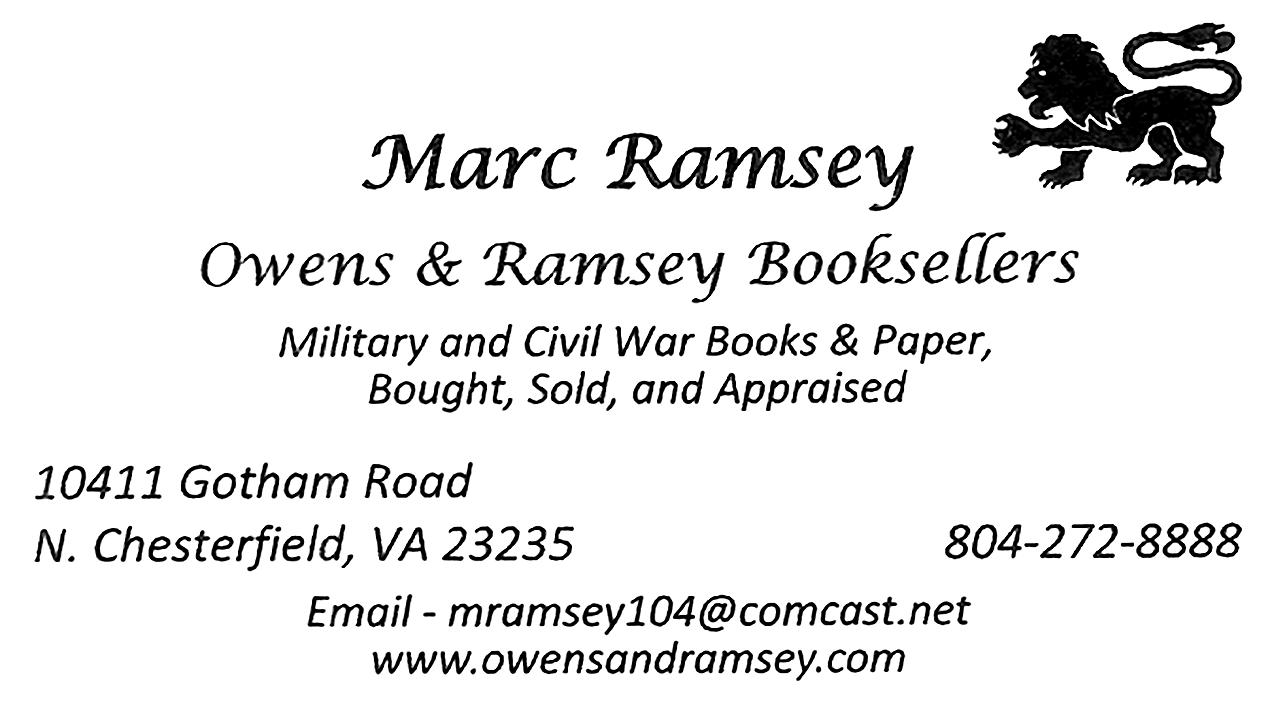
Expanding on the previous studies by Edward Magdol (Owen Lovejoy: Abolitionist in Congress) and Jay Monaghan (The Man Who Elected Lincoln), Jane and William Moore extensively detail the life of Owen Lovejoy and how he crusaded to combine the clergy, African Americans, and women into a coalition to abolish slavery and grant equal rights to Black Americans.
Early in his career he united this lifelong quest for equality around three motivational forces: religion, the Underground Railroad, and daily confrontations to refute the prevailing mindset that slaves were inferior and mere property. These strategies were complimented by Owen Lovejoy’s gregarious nature, persuasive speaking ability, and good sense of humor to bring opponents to an acceptance of his profound convictions on the humanity and equality of all men.
By 1846, Lovejoy was emerging as a leader in the anti-slavery movement. He championed the policy of slavery’s containment to the South, helped to found the
Despite one small historical error that has Stephen Douglas rather than Frederick Douglass leaving for Montreal during the John Brown execution, this book is exceptionally well researched, presented to highlight Lovejoy’s crucial political impact in antetbellum America, and devoid of any sympathy for the Southern way of life. The end notes and bibliography provide a fruitful arena for further research. For any historian interested in abolition as a moral, religious, and political movement in America, this book would be a welcome addition.
Wayne L. Wolf is Professor Emeritus at South Suburban College and past president of the Lincoln-Davis Civil War Roundtable. He is the author of 23 books on the Civil War.
One of the oldest formats for Civil War histories is the individual unit study. Often authored by its soldier members, the first unit histories, those covering battalions, regiments, and brigades, surfaced in the immediate postwar years. Many early works delivered a celebratory narrative of the unit, remembering the good, too often ignoring the difficult, and forgetting the bad. With few exceptions, this model set a standard that continued far into the twentieth century.
However, over the last three decades or so historians have been exploring Civil War units with a more critical eye. By digging deeper into their primary source research, focusing on more than just a unit’s battlefield and camp experiences, and even choosing to examine some distinctive units, historians, now more often than not, provide readers with a much truer picture of Civil War units. Books like Susannah J. Ural’s Hood’s Texas Brigade: The Soldiers and Families of the Confederacy’s Most Celebrated Unit; Lesley J. Gordon’s A Broken Regiment: The 16th Connecticut’s Civil War; and Earl J. Hess’ Lee’s Tar Heels: The Pettigrew-KirklandMcRae Brigade, among others, offer excellent examples of alternatives to the conventional unit history. With Lee’s Body Guards: The 39th Battalion Virginia Cavalry, historian Michael C. Hardy adds to this growing list by shedding light on a significant yet

Created and recruited largely out of the necessity for increased efficiency, the 39th Battalion Virginia Cavalry filled an important role at a time when the Army of Northern Virginia (ANV) was quickly becoming the Confederacy’s premier command under Gen. Robert E. Lee’s leadership. Before formation of the 39th, various cavalrymen in regular regiments received assignments to ANV headquarters. These men served in a number of different roles. However, being on detached detail, of course, reduced the number of men available to cavalry units and thus limited their effectiveness as one of the three operating branches of service. The four (possibly five) companies of the 39th took over many duties formerly assigned to detached regular cavalrymen. Their responsibilities included copying and delivering orders, carrying headquarters telegraphic correspondence to and from stations, escorting prisoners, wrangling stragglers, and scouting enemy positions.
Using an array of primary sources including letters, official records, and newspapers, Hardy chronicles the exploits of the 39th throughout the various ANV campaigns. In chapters designated for each year from 1862 through 1865, readers get a good look at the diverse, yet important, work completed by the 39th. Although they became known as “Lee’s Body Guards,” and often identified themselves as such, the 39th served other officers in the ANV, too. At times they worked with corps and divisional commanders like James Longstreet, Richard S. Ewell, Thomas Jonathan Jackson, Jubal Early, George E. Pickett, and A.P.
Hill, among others. In completing their duties, men of the 39th witnessed some of the ANV’s most famous victories, delivering timely orders that helped achieve the successes that buoyed the infant Confederacy. They also were on hand for some of the army’s most tragic episodes like A.P. Hill’s death, the evacuation of Petersburg and Richmond, and surrender at Appomattox.
In addition to the book’s four chapters, and an “In Retrospect” epilogue, the book contains an alphabetical roster of the 39th, giving company assignment, brief service information, and, when known, the birth and death dates and burial place for its men.
Lee’s Body Guards makes a fine contribution to the evolving body of Civil War unit histories. Its primary strength rests in helping inform students and enthusiasts about the significant role that men assigned to headquarters roles such as couriers, scouts, and guides played within the army structure, and thus gives us a greater appreciation of their duties.
Tim Talbott is the Director of Education, Interpretation, Visitor Services, and Collections at Pamplin Historical Park and the National Museum of the Civil War Soldier in Petersburg, VA. He is currently researching soldiers captured during the Petersburg Campaign.
39 May 2020 Civil War News Digital Issues of CWN are available by subscription alone or with print plus CWN archives at CivilWarNews.com
Subscribe online at CivilWarNews.com

























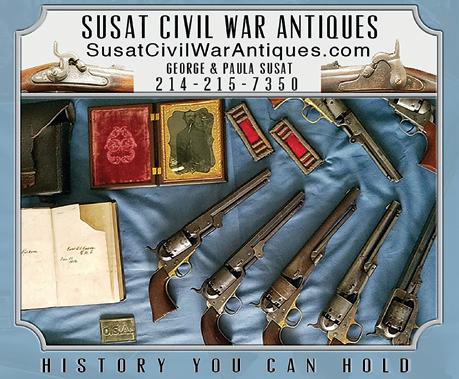
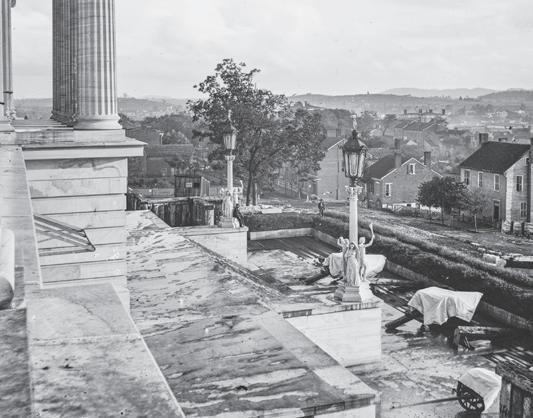

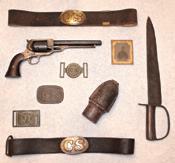
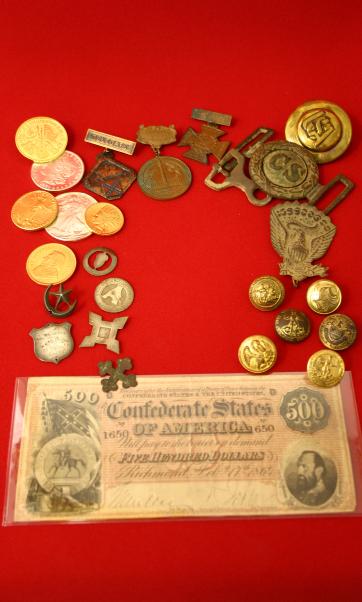

































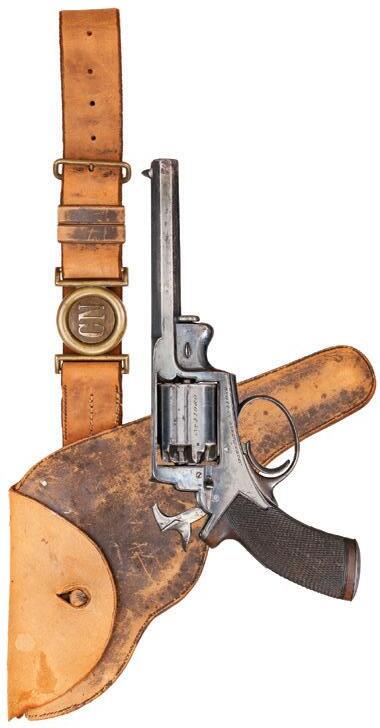



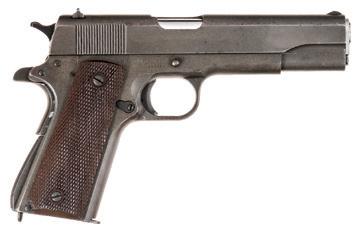









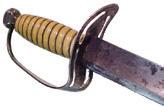









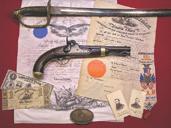







































40 Civil War News May 2020 CivilWarShop.com Offering the Finest Investment Grade Military Memorabilia since 1981 Buy – Sell – Trade Certified Appraisal Services Life Member Company of Military Historians Lynn and Will Gorges, Proprietors 3910 US Hwy. 70 East New Bern, NC 28560 (252) 636-3039 • civilwarshop@gmail.com www.CivilWarShop.com Long Bay Salvage LLC specializes in the recovery and restoration of authentic Civil War Cannon with an emphasis on 10-Inch Columbiads, what has become a rare piece of Civil War history. Long Bay Salvage also works with historical entities (government and private) to recover and conserve large historical artifacts with a specialty in large field and naval artillery pieces. Glenn Dutton 770-351-7565 Rufus Perdue Perdue 843-315-9818 PLEASE CONTACT US FOR MORE INFORMATION www.LongBaySalvage.com Promoters of Quality Shows for Shooters, Collectors, Civil War and Militaria Enthusiasts Military Collectible & Gun & Knife Shows Presents The Finest Mike Kent and Associates, LLC • PO Box 685 • Monroe, GA 30655 (770) 630-7296 • Mike@MKShows.com • www.MKShows.com Northwest Georgia Trade Center 2211 Dug Gap Battle Road Dalton, GA 30720 February 1 & 2, 2020 Chickamauga (Dalton) Civil War Show Williamson County Ag Expo Park 4215 Long Lane Franklin, TN 37064 December 5 & 6, 2020 Middle TN (Franklin) Civil War Show l Shiloh Buying & Selling Authentic Civil War Artifacts 2405 Oak Grove Road Savannah, TN 38372 731-438-3541 ShilohRelics.com History@shilohrelics.com owner Rafael Eledge .com Dealing in the Finest Authentic Militaria Since 1995 with an Emphasis on the American Civil War Pistols, Muskets, Carbines, Rifles, Bayonets, Swords, Uniforms, Headgear, Belt Buckles, Cannon, Buttons, Bullets, Artillery Implements Etc. MidWestCivilWarRelics.com Bowie Knifes, Civil War Swords, Confederate D-guards, Antique Firearms, Dug Relics, Buckles & Belts, Identified Relics, Letters, Documents, Images, Currency, Uniforms, Head Gear & Flags. 3500 Shacklett Rd • Murfreesboro, TN 37129 tom@stonesrivertrading.com • (615) 336-2188 StonesRiverTrading.com Tom Hays Proprietor We carry all types of relics, dug & non-dug, Confederate & Federal. 100% Guaranteed. A strong emphasis on dug relics, but also a full line of non-dug relics of all types. Over 30 years experience with a full time, online store since 1997. We also have a shop located five miles from Stones River National Battlefield that is open by appointment. www.CollegeHillArsenal.com Tim Prince College Hill Arsenal PO Box 178204 Nashville, TN 37217 615-972-2418 Mid West Civil War Relics MidWestCivilWarRelics.com Allen Wandling Phone: 618-789-5751 Email: awandling1@gmail.com Museum Quality Civil War Union & Confederate Artifacts! We handle the Best Antique Bowie Knifes, Civil War Swords, Confederate D-guards, Antique Firearms, Dug Relics, Buckles & Belts, Identified Relics, Letters, Documents, Images, Currency, Uniforms, Head Gear & Flags. Preston Bain Nashville, TN (615) 397-5186 www.NashvilleRelics.com Nashville Civil War Relics “Old times there are not forgotten” Coles Civil War Shop.com Come by and see me at the shop or place an order online. email hmcole2@comcast.net Mac Cole 13119 River’s Bend Blvd. Chester, Va 23836 wk - 804-681-0945 cell-804-314-9940 Hours Mon - Fri 10-5 Sat - 10-3 P.O. Box 342 Thompsons Station, TN 37179 615-585-0115 Email: brubon2@bellsouth.net Franklin Relics www.AmericanRelics.net Allen Phillips 1014 Reservoir St., Suite B Harrisonburg, VA 22801 A P.O. Box 342 Thompsons Station, TN 37179 615-585-0115 Email: brubon2@bellsouth.net Franklin Relics Specializing in Accoutrements, Edged Weapons, Firearms and Uniforms FranklinRelics.com Bruce Hohler Proprietor Specializing in Buttons, Buckles, Currency, Hat Devices and other Military Artifacts. www.AmericanRelics.net Allen Phillips 1014 Reservoir St., Suite B Harrisonburg, VA 22801 American Relics Phone: 540-476-1969 Email: americanrelicsnet@gmail.com www.CivilWarBadges.com Everitt Bowles, Owner • 770.926.1132 1036 Washington Avenue Woodstock, Georgia 30188 The Largest Selection of GAR & UCV Hundreds of Memorabilia Items from Rev War through Vietnam Secure & Easy Guaranteed Authenticity of Every Item Vin Caponi Historic Antiques Vin Caponi, Jr. 18 Broadway Malverne, NY 11565 Store: 516-593-3516 Cell: 516-353-3250 rampantcolt@aol.com http://www.vincaponi.com We carry a very large inventory of Colt and Civil War firearms including muskets, carbines, rifles and accoutrements. Our inventory of historic antiques and firearms begin at the early collectors level and range all the way up to the advanced 8895 Town and Country Circle • Knoxville, TN 37923 Phone: 865-693-3007 info@armyoftennesseerelics.com Civil War Artifacts Nick Periut Proprietor ArmyofTennesseeRelics.com Buying and Selling High Quality Images, Belt Buckles and Plates, Artillery Shells, rare Bullets and Buttons! Richard Gersten (708) 786-8630 PO BOX 31113, CHICAGO, ILLINOIS 60631 www.YankeeCollector.com Specializing in Early Americana, Civil War American Indian, Old West, WW I & II Guns, Swords & Memorabilia www.uniondb.com 34 York St Gettysburg, PA 17325 Phone: 717-334-2350 • Email: bsynnamon@gmail.com Specializing in Authentic Civil War Artifacts The Union DrUmmer Boy A Museum Where You Can Shop! Contact Glenn Dutton at: glennjdutton@aol.com or 770-351-7565 BUYING & SELLING Field & Heavy Artillery Cannon, Shells, Fuses & Etc. Rare Accoutrements Michael Simens HistoricalArms.com Tel: 440-744-9088 mail@HistoricalArms.net The Only Complete Beaumont-Adams CS Naval Rig Michael Simens HistoricalArms.com Tel: 440-744-9088 • mail@HistoricalArms.net Magnificent Swords Georgia Presentation To William J. Hardee. Later Confederate Lieut. General. We Buy, Sell, Authentic And Appraise World-Class Historical Artifacts Fine Antiques & Militaria Military Items 1650-1945 Armor Swords Firearms Bayonets Equipment Accoutrements www.csarms.com PO Box 602 9150 John S. Mosby Hwy. Upperville, Virginia 20185 Shop Phone: 540-592-7273 Email: sophiacsarms@aol.com C.S. Arms, Inc. Specialize in U.S. & British Militaria www.OldSouthAntiques.com Old South Antiques, THE CONFEDERATE Old South Antiques, LLC Hickory Hill Mansion, 9222 Wickham Manor Way, Ashland, VA 23005 CARSON SQUEEGIE JENKINS 321.505.7524 WWW.SQUEEGIE.NET DESIGN SERVICES PRINT MEDIA ILLUSTRATIONS PACKAGE DESIGN CORPORATE BRANDING PRINT & MAGAZINE ADS LOGO DESIGN TEXTILE/ T-SHIRTS BROCHURES EVENT POSTERS BUSINESS CARDS 3D RENDERINGS MARKETING NEW BUSINESS START-UP PACKAGES AVAILABLE The Historical Shop Margaret & Cary Delery Box 73244 Metairie, LA 70033 Phone: 504-467-2532 c.j.delery@att.net www.historicalshop.com Since 1978 selling rare Americana Historical Shop The e Early American items through the Civil War artifacts, autographs, photography, currency, bonds, historical displays, military items, and more…… P.O. Box 160 • Kingston, TN 37763 Phone: 803-431-1798 Email: vann@veteransattic.com www.VeteransAttic.com Vann Martin United Confederate Veterans, Grand Army of the Republic, Civil War Photographs and other Civil War items. David K. Parks Military Antiques PO Box 180674 Utica, MI 48318-0674 Phone: 586-871-6462 Email: dkpma@comcast.net Offering a large selection of Civil War and Historical Memorabilia ranging from the Revolutionary War to World War (emphasis on the American Civil War). On line catalog regularly offers over 700 items from nearly every category of collecting. www.RelicsOfHistory.com Civil War Military Longarms a Specialty ConfederateArmsCompany.com 1209 Victor II Blvd., Morgan City, La. 70380 Cell: 985-518-1802 • Email: leegray@LHprinting.com Lee Gray Confederate Arms Company PO Box 129 Dover, TN 37058 Buying & Selling: Images Artillery Firearms Dug Relics Edged Weapons Non-dug Artifacts John & Nikki Walsh Fort Donelson Relics FortDonelsonRelics.com Full Line Civil War Artifact Dealer Email: john@fortdonelsonrelics.com vann@veteransattic.com www.VeteransAttic.com United Confederate Veterans, Army of Republic, Civil War Photographs other Civil items. War and Historical Revolutionary War American Civil offers over 700 of collecting. www.RelicsOfHistory.com “Reproduction Antique Spectacles to suit all sights” Authentic reproduction Civil War era eyeglasses to fit your lifestyle. Historically accurate, ophthalmic quality eyeglass frames suitable for reading, distance, bifocals, progressive lenses, sunglasses & nonprescription tinted lenses. Made for full time wear. “Spectacles are most overlooked, most obvious way to spoil an otherwise fine impression.” Thomas Valenza, Optician When you are ready to complete your impression, visit us online for detailed information about our spectacles: www.HistoricEyeWearCompany.com Prices start at $139.95 862.812.4737 Unidentified Union soldier wearing oblong spectacles (Library of Congress) Above Right: Lieutenant Adam J. Slemmer, defender of Fort Pickens (U.S. Army Heritage & Education Center) The Best Civil War Era Spectacles Buying and Selling original Civil War Confederate & Union Buttons, Belt Buckles, and Accoutrements. NCCivilWarRelics.com PO Box 2122 Morehead City, NC 28557 Phone: 252-671-7770 Email: sales@nccivilwarrelics.com or AGaskins1@ec.rr.com Allen Gaskins North Carolina Civil War Relics Robert Jones • 119 Frances Ave. • Stanhope, NJ 07874 Phone: 973-810-2976 • Email: Bob33rd@optonline.net We sell original Civil War artifacts, both excavated and non-excavated. There is also a selection of mid-19th century antiques. Yankee Rebel Antiques www.YankeeRebelAntiques.com Proprietor, Robert Jones, is the author of seven books on Civil War subjects: The Civil War Canteen Civil War Artillery – A Pictorial Introduction Children at the Battle of Gettysburg –Their Unforgettable Summer The Civil War Canteen Second Edition, Battle of Gettysburg –The Relics, Artifacts & Souvenirs, The Civil War Soldier – His Personal Items, War Canteen – Third Edition He has also written articles for North/South Trader Civil War magazine. Order his books online at http://www.lulu.com/spotlight/civilwarbooks Promoters of Quality Shows for Shooters, Collectors, Civil War and Militaria Enthusiasts Military Collectible & Gun & Knife Shows Mike Kent and Associates, LLC • PO Box 685 Monroe, GA 30655 (770) 630-7296 • Mike@MKShows.com • www.MKShows.com February 1 & 2, 2020 Chickamauga (Dalton) Civil War Show November 14 & 15, 2020 Capital of the Confederacy Civil War Show December 5 & 6, 2020 Middle TN (Franklin) Civil War Show l l Firearms & Militaria Auctioneers or Better! On Expensive Items and Valuable %0 Seller’s Commission The Tradition Continues - New Facility, Same Family and Great Location We are pleased to announce the purchase of the former Auction Facility of World-Renowned Hall-of-Fame Auctioneer James Julia. climate controlled and secured space dedicated to the promotion, presentation and handling of fine firearms collections. Our Fall 2019 Firearm Auction generated nearly $5.5 Million in sales for our consignors - Our largest to date! Call our offices to be part of our next Premier Firearms Auction Consignments Now Being Accepted 199 Skowhegan Rd Fairfield, ME 04937 207-453-2114 civilwar@poulinauctions.com Website: poulinauctions.com Stephen Poulin, ME Lic 1115 Presentation Sword of Gettysburg Hero General Alpheus Williams (est. $20,000 30,000) Sold $41,125 Sold $41,125 Rigdon & Ansley Confederate Revolver Carried By Captain Luther M. Clements, Co. F, 41st Alabama (Est. $25,000-35,000) Unique 1864 Sold $7,635 Sold $41,710 Sold $36,425 Confederate Keen-Walker Brass Frame Breech Loading Percussion Carbine (Est. $20,000-30,000) Sold $23,500 Sold $23,500 Fine Cook & Brother Athens Georgia Confederate Percussion Carbine (Est. $20,000-25,000) ROCK ISLAND AUCTION COMPANY REAL ART REAL HISTORY REAL IRON Exceptional Springfield Armory Rare and Exceptional Double Cased Pair of Early Squareback Factory Engraved Colt 1860 Army Patriotic Lady Grip, Case and The 2020 Civil War Dealers Directory is out. To view or download a free copy visit: www.civilwardealers.com/dealers.htm The 2020 Civil War Dealers Directory is out. To view or download a free copy visit: www.civilwardealers.com/dealers.htm
Mary Lincoln in a New Light
Mary Lincoln For The Ages.
By Jason Emerson. Bibliography, illustrations, indexes. 213pp., 2019, Southern Illinois University Press, www.siupress. com, $29.50, paperback.
Reviewed by Joseph Truglio
Lincoln’s State Legislative Career Proved Formative
virtually everything ever written about Mary.
Presented in chronological order are histories, newspaper articles, essays, interviews, dramas, poetry, musicals, etc. Also included is an index and note sections. Each entry has a short analysis included to give the reader an understanding of the gist of that specific presentation. I found this particularly helpful in selecting appropriate research items.
The opening essay, “Common Canon of Mary Lincoln,” is the author’s opinions on how Mary has been treated over the years by historians. He is critical of some for repeating inaccuracies, like Jean Baker and William Herndon, and praises others like Frank Williams and Michael Burlingame. However, at no time did I feel Mr. Emerson was trying to influence my opinions, but rather guiding me to seek out additional information.
Lincoln in the State Legislature. By Ron J. Keller. Notes, index, 176 pp., 2020. Southern Illinois University Press, www.siupress.com. Hardcover. $24.95.

Reviewed by Brian Matthew Jordan
emerged” (127). It was during his service in the Illinois General Assembly, the author contends, that Lincoln found his political voice and “wrestled with his moral convictions” (127). Keller tracks these developments alongside the struggles Lincoln faced in his personal life, locating both in the larger narratives of state and national politics.
The author excels at contextualizing his story. Lincoln’s tenure as state legislator coincided with the heyday of a “transportation revolution” that gouged canals into the earth, macadamized a warren of roads, and belted the nation with iron rails. As a Whig, Lincoln championed these “internal improvements,” deeming them vital to the state’s future. Neither public opinion, which increasingly turned against the projects, nor the state’s spiraling debt could dissuade the so-called “DeWitt Clinton of Illinois.”
the respect of his peers, who selected him as Whig floor leader.
Perhaps the most significant act of his state legislative career was casting one of just five votes against a resolution decrying abolitionists and frowning on “any attempt by Congress to abolish slavery in the District of Columbia without the consent of the people in that district” (74). What was more, Lincoln penned a statement (together with Dan Stone, a colleague who voted against the measure) explaining his position. While expressing no sympathy for abolitionism, Lincoln and Stone identified slavery as “founded on both injustice and bad policy” (75).
Mary Lincoln is perhaps the most maligned and misunderstood first lady in history. This is the impression I took away from the opening essay of Jason Emerson’s valuable new book, which is a unique new research tool for all Lincoln scholars. Unless you have more than a curious interest in Mary Lincoln this may not be the book for you. In the relatively short space of 213 pages, the reader can find
As I have said before, this is a valuable tool for serious students. This book presents a road map to learning what Mary Lincoln was really about. It should be on everyone’s bookshelf. I highly recommend it.

Joseph Truglio, of Manchester, N.J., is a retired Motion Picture Technician who has a life long in-terest in the Civil War. He is cur-rently President of the Phil Kearny CWRT in Hasbrouck Heights, N.J.
100 Significant Civil War Photographs: Atlanta Campaign collection of George Barnard’s camera work. Most of the photographs are from Barnard’s time in Atlanta, mid-September to mid-November 1864, during the Federal occupation of the city. With this volume, Stephen Davis advances the scholarly literature of Barnardiana.
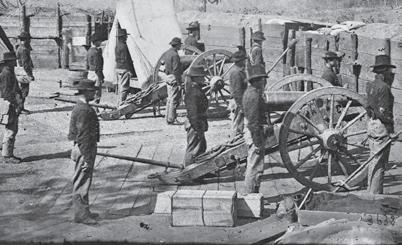
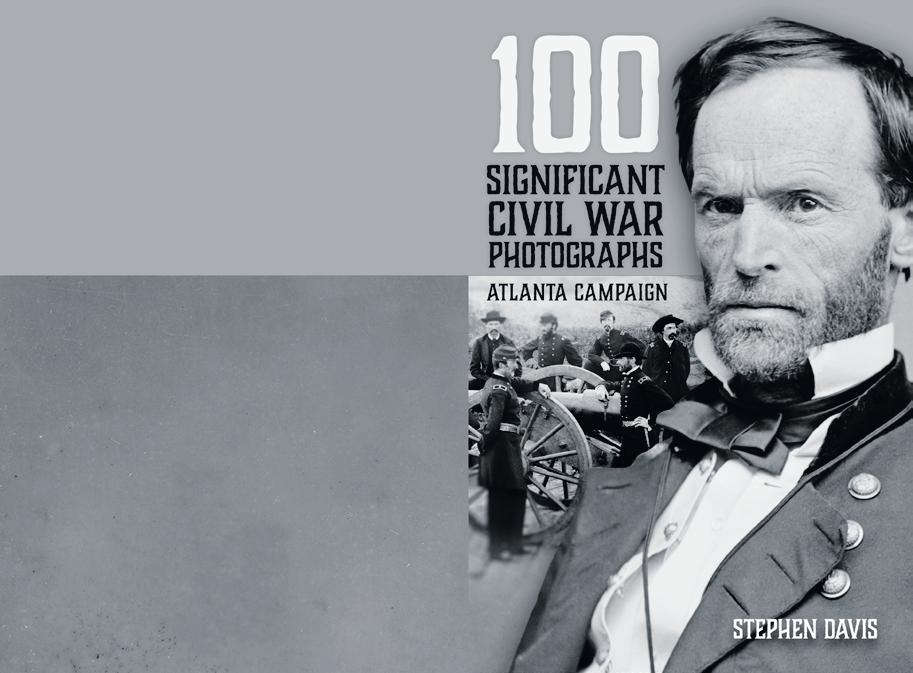
$19.95 + $3.50 shipping
128 pages, photographs, maps, bibliography. $19.95 + $3.50 shipping. Softbound. ISBN: 978-1-61850-151-6. www.HistoricalPubs.com. Order online at www.HistoricalPubs.com or call 800-777-1862
On December 5, 1840, Abraham Lincoln leapt from a window. In a convincing display of his physical and political agility, the lanky Whig representative from Sangamon County sought to deny the Illinois General Assembly a quorum. Lincoln successfully escaped the legislative body’s temporary chambers, though his daring effort ultimately failed to spare the state bank from its Democratic foes. The episode supplied plenty of copy for the contemporary press, but biographers and historians have paid it, and Lincoln’s four terms in the Illinois House of Representatives, relatively little notice.
Such inattention is not exactly difficult to explain. Much of the sixteenth president’s tenure as a state legislator was occupied by tedious debates about internal improvements, the Democrats’ ponderous Sub-Treasury scheme, locating the Illinois state capitol, apportionment of representatives, and the boundaries of Sangamon County.
On the other hand, as Lincoln College history and political science professor Ron J. Keller contends in this deftly argued and well written addition to Southern Illinois University Press’s Concise Lincoln Library, “through his service in the Illinois legislature,” Lincoln’s “true calling as a humble servant of the people has unmistakably
Lincoln’s time in Vandalia and Springfield likewise coincided with the congealing of a second party system and a new, more boisterous political style. In Keller’s rendering, Lincoln emerges as a clever and sometimes cutthroat politician. The Lincoln here is hardly the folksy, prairie statesman of popular memory. As a member of the “Long Nine,” the all-powerful Sangamon County delegation in Vandalia, Lincoln muscled through infrastructure bills, bargained for votes, and “learned to wield political tools to achieve larger political aims” (60). He perfected the art of the public letter and pseudonymous journalism; the latter almost occasioned a duel. Still, Lincoln commanded
If the campaign autobiography he prepared for John Scripps is any index, Lincoln considered his “protest” against the anti-abolition measure the highlight of his tenure as a state legislator. By the time he turned his attention to a burgeoning law practice, the internal improvements bill had been repealed and the state bank’s charter revoked. Yet he had tutored himself in the workings of politics and party loyalty. What was more, Lincoln’s first taste of political influence left him craving more. As his later law partner William Herndon aptly put it, Lincoln’s ambition was “a little engine that knew no rest.”
Not unlike the one Lincoln leapt from, Keller has provided an accessible window into the future president’s formative years.
41 May 2020 Civil War News
The American Civil War was the first war in which both sides widely used entrenchments, repeating rifles, ironclad warships, and telegraphed It was also the first American War to be extensively photographed. Mathew Brady, Alexander Gardner and Timothy O’Sullivan are famous for having made iconic photographs in the Civil War’s eastern theater. George N. Barnard deserves to be ranked in this top tier for his photographic work in the war’s western theater. A civilian photographer hired by Gen. William T. Sherman’s chief engineer to take pictures of fortifications around Atlanta, Barnard took several hundred of them in and around the city in the fall of 1864. His most famous is the site of Union Maj. Gen. James B. McPherson’s death in the battle of Atlanta, July 22, 1864. Thus far, no comprehensive, definitive listing has been made of the photographer’s The Library of Congress has 130 images; the U. S. Military Academy at West Point, New York, has at least 98 photographs, donated by Captain Poe’s widow. Other repositories, such as the Gilder Lehrman Institute of American History in New York City, have smaller collections. For this book we have chosen hundred images we deem “significant,” though other students may wonder at some of our selections. We hope that this work will stimulate further interest in Barnardiana, and that other scholarly volumes are yet to come. The Atlanta Campaign STEPHEN DAVIS 100 SIGNIFICANT CIVIL WAR PHOTOGRAPHS ATLANTA CAMPAIGN
Subscribe online at CivilWarNews.com
Brian Matthew Jordan is Assistant Professor of Civil War History at Sam Houston State University and author of Marching Home, which was a finalist for the Pulitzer Prize.
Publishers/Authors Updated Information Send your book(s) for review to: Civil War News 520 Folly Road, Suite 25 PMB 379 Charleston, SC 29412 bookreviews@civilwarnews.com
New Angles, New Voices in Civil War Women’s History
The Women’s Fight: The Civil War’s Battles for Home, Freedom, and Nation. By Thavolia Glymph. Photos, notes, index, 379 pp., 2020. UNC Press, www.uncpress.org. Hardcover. $34.95.

Reviewed by Brian Matthew Jordan
spheres, Glymph argues that a full accounting of women’s participation in the conflict remains elusive. In particular, poor, non-slaveholding white and African American women are neglected in the literature. Rooted in archival spadework and punctuated with keen historiographical insights that will have students of the war nodding and underlining, The Women’s Fight serves up a range of interpretive possibilities. Juxtaposing white and black, rich and poor, northern and southern women, Glymph reveals that the War was not just a contest between men, but “a fight among and between women” as well (15).
plagued the work” of the United States Sanitary Commission (150).
Such assumptions factor into the next chapter, which considers Northern women who hurried South during the war as missionaries, teachers, and relief workers. Once again, the war brought women together, in this case, black women and white northern abolitionists. Yet they occupied uneven ground. “Refusing a sisterhood of equality with black women,” Glymph concludes, white northern women “helped to refurbish the racial ideology that had defended slavery and would work to constrain black women’s lives for decades to come” (195).
In Their Letters, In Their Words: Illinois Civil War Soldiers Write Home. Edited by Mark Flotow. Maps, photos, endnotes, bibliography, appendices, index, 320 pp., 2019. Southern Illinois University Press, www. siupress.com. Paperback. $26.50

Reviewed by Gould Hagler
in camp and on the march. One chapter deals with stationery, pens, stamps, and the process of getting letters from the military camp to the home front, things to which we give little thought, but matters of importance to the men and their families.
In other chapters the soldiers opine about their generals and political leaders; give impressions of Southern people and society; and offer their perspectives on war aims, Copperheads, slavery, and the Emancipation Proclamation. The chapter on prison camps is the only one that relies mostly on postwar accounts rather than contemporary letters.
In this long awaited contribution to the University of North Carolina Press’s Littlefield History of the Civil War Era series, Thavolia Glymph, a professor of history and law at Duke University and a leading authority on slavery and emancipation, offers a stunning reassessment of how women experienced the nation’s defining conflict. Discarding old paradigms and amplifying new voices, Glymph weaves a more complete, more nuanced, and ultimately more human history of the war. Throughout, she is attentive to the diversity and multivocality of women’s experiences. The war brought women together in new combinations, exposing old tensions and hierarchies, but failed to forge a “sisterhood” that could transcend race, class, politics, or section.
While historians in recent decades have produced an impressive body of work illuminating the lives of women and building connections between the war’s military and non-military
The book is divided into three sections. The first considers southern women. “The Civil War,” the author writes, “set women across the South in flight” (20). War, occupation, and the collapse of slavery “forced reckonings in the meaning of home that white Southerners had not anticipated” (21). As slaveholding women took to the road and sought refuge from the invading Yankees, they came into close contact with poor women, competing for dwindling food, space, and resources in ways that raised troubling questions about the Confederate experiment. While the war congested the roads with refugees, it nonetheless “enlarged the space for the slaves’ war,” and “opened to wider view existing crevices in Southern slave society” (89-90). Black women “fought, prayed, sacrificed, and died” for the Union (88).
The second section turns to the experiences of northern women. Glymph reminds the reader that “the vast majority of white Northern women and men neither began nor ended the war as abolitionists, though their ranks grew and deepened over the course of the war” (158). The author tallies the benevolent and relief work of northern women, but without the usual dose of sentimentalism or celebration. Scholars, she argues, have not yet accounted for “the class antagonism and racism that
The final section explores how women experienced the “hard hand of war.” Excellent recent books by Stephanie McCurry and Amy Murrell Taylor have tilled some of this ground, but Glymph further dissolves the fictive boundary between the battlefield and home front. In particular, she reminds us that memories of the American Revolution informed southern women’s experiences of military occupation. A wrenching chapter on slave refugee camps recalls the unique path out of bondage for African American women, a path marked by withheld wages, sexualized violence, and attacks from Confederate guerrillas. The bone-grinding toil of black women on behalf of the Union war effort has remained invisible, but placed emancipation undeniably at the center of the war.
The best books raise more questions than they answer. By that measure, The Women’s Fight is a triumph. To its agenda for future research, however, I would add a fuller accounting of the lives of young women, soldiers’ mothers, veterans’ wives, and widows. The author has focused our attention on how antebellum experiences informed wartime actions, but we need much more work on how wartime events shaped postwar lives. Serious students of the war and general readers alike will profit from this major work that boldly reimagines Civil War women’s history as something more than sewing circles, bandage rolling, and relief work.
Brian Matthew Jordan teaches Civil War history at Sam Houston State University. His book Marching Home was a finalist for the 2016 Pulitzer Prize in History.
Independent researcher Mark Flotow writes in his preface that he once “sought a book like this one, but without success.” He therefore took on the work himself and did a most creditable job.
In Their Letters, In Their Words draws on letters written by 165 Illinois soldiers and sailors, all contained in the Abraham Lincoln Presidential Library. The editor presents relatively brief excerpts from the letters and connects them with ample editorial notes that provide background and context. He also preserves the letters’ original (mis)spelling and (exceedingly sparse) punctuation. The sentence quoted above, penned by Private John Laingor, tells us something about camp life and something about John as well.
Almost all letters are from soldiers who served in the Western Theater, but we do sail into Port Royal Sound with a midshipman and ride in Virginia with the 8th Illinois Cavalry. Officers and enlisted men alike share their thoughts with us.
The letters are arranged thematically, with each of the eleven chapters covering a different aspect of the war and army life. We learn how the men become soldiers in training camp; we go with them into combat and learn how they react when they “see the elephant”; we read their descriptions of harsh conditions
After the soldiers are mustered out in the final chapter, one appendix provides brief biographical sketches of the entire cast and another offers a chronology of the war. A reader wishing to review letters written by any given soldier will find the index very useful.
The readers will find different letters to be of particular interest. Four especially caught my attention. Col. Elmer Ellsworth wrote a moving letter to his fiancée on May 23, 1861, the day before he met his fate in an Alexandria hotel. A soldier camped near Fredericksburg wrote nine days after the Battle of Chancellorsville and told his correspondent that “we due not know what the actual result was.” There is a similar letter written from Williamsport four days after Antietam. This soldier too was in the dark, admitting to his brotherin-law that “You are better posted with regard to our movements than we are ourselves.”
The last of my four was written by an officer, a letter about another letter received by one of his men, a devastating missive which the editor says “recounted perhaps one of the worst ‘Dear John’ letters ever.”
Gould Hagler is a retired lobbyist living in Dunwoody, Ga. He is a past president of the Atlanta Civil War Round Table and the author of Georgia’s Confederate Monuments: In Honor of a Fallen Nation, published by Mercer University Press in 2014. Hagler speaks frequently on this topic and others related to different aspects of the Civil War and has been a regular contributor to CWN since 2016. He can be reached at gould.hagler@gmail.com.
42 Civil War News May 2020 Digital Issues of CWN are available by subscription alone or with print plus CWN archives at CivilWarNews.com
“the boys have to keep there gunes and selvs clean I hant saw but one body louse since I left I Weigh 175 pounds”
New Research on Charleston’s Civil War Period Photography
100 Significant Civil War Photographs – Charleston in the War.
By Stephen Davis & Jack W. Melton Jr. Maps, photos, illustrations, bibliography, index, 160 pp., 2020. Historical Publications LLC, www.historicalpubs.com Softbound. $19.95
Reviewed by Tom Elmore
The Great Post Civil War Gold Robbery and Treasure Hunt

“alternative” takes made just minutes or hours apart, or in some cases, days or years apart from the better known versions.
The Civil War still resonates with so many people because it was the first American war captured by cameras. Photographers, using bulky equipment and working in harsh, often dangerous conditions produced a remarkable visual record that has withstood the test of time. Not only did they document all aspects of the war, but they did it in remarkably vivid and dramatic photos that remain among the most famous and recognizable pictures in American history.
The latest in a series of books about Civil War photographs focuses on the place where the war started: Charleston, S.C. Editors Stephen Davis, former book review editor for this publication, and Jack W. Melton Jr., publisher of Civil War News, have assembled an impressive selection of photos taken during the four years the city was under siege. While many photographs are familiar, the selection includes
The book is thematically arranged. The first section is appropriately devoted to the men who took the photographs, most notably George N. Barnard, one of the war’s greatest photojournalists. While there is a section devoted to famous individuals, the bulk of the images are still lifes of buildings and various areas of Charleston. Many reminded this reviewer of the bombed cities of Europe at the end of World War II. There are once fine, stately homes, now pock marked with holes from artillery fire. Sections of the city are burned out. Magnificent ruins of mansions and churches stand next to unharmed shanties, and vice versa. Perhaps most compelling is an image of Fort Sumter the day after its initial shelling, riddled with holes, but still a three story structure with architectural aesthetics. Below that image is another taken two years later showing the fort reduced to a one story rubble pile.
The photographs have been digitally restored and look so clean and crisp you would have thought they were just recently taken. Even if it is a picture you have seen dozens of times before, the odds are good you will see something you never noticed before. Almost every individual picture is accompanied by an excellent commentary from the editors explaining when, where, and by whom it was taken and the picture’s significance.
For anyone interested in the history of Charleston and/ or photography in the Civil War, 100 Significant Civil War Photographs – Charleston in the War, is a must have.

Tom Elmore has decades experience in both photography and studying South Carolina in the Civil War.


Publishers:
Please send your book(s) for review to: Civil War News
520 Folly Road, Suite 25 PMB 379
Charleston, SC 29412
Email cover image to bookreviews@civilwarnews.com.

Graball Road: The True Story of the Civil War’s Greatest Mystery: The Lincoln County Gold Train Robbery of 1865. By Bob Young. Maps, bibliography, 195 pp., 2019, Eagle Veterans Services LLC, Augusta, GA, www.bobyoungbooks.com. Paperback. $14.95.

Reviewed by Joseph A. Derie
from Washington, the wagon train was robbed by persons unknown. No shots were fired, and no one was ever apprehended for it. The robbery was something of a makeshift affair with the robbers placing the gold in saddlebags, feed sacks, and, reportedly, trousers tied at the leg. Not all the treasure was taken; some $40,000 in gold coins was found on the ground after the wagon train left to return to Washington the next morning.
Most, if not all, the robbers were ex-Confederate soldiers, many from Tennessee or Kentucky, who had been paroled and were reluctant to return home due to the uncertainty of their welcome. It turned out that many thought the funds were Confederate and didn’t think of it as robbery. On that basis, some loot was returned, eventually amounting to $110,000 of an original $280,000. None of the remaining funds were ever recovered.
The final results were:
The author has done an exhaustive search for records pertaining to the treasure and its history, all of which are included in the volume. They range from Union Army passes, statements of the bank clerks, bank officials, Union officials, statements from locals, as well as 19th-century newspaper articles from papers in Boston, New York, California, and the Atlanta Constitution Graball Road is a readable look at a minor Civil War legend. It is also an interesting look at the South immediately following the war when there was no local government and lots of transient personnel. This volume is not for everyone but will reward those with a special interest in the subject or those who want something different in their Civil War studies. It is recommended with those caveats.
A train carrying the Confederate Treasury gold and silver reserves left Richmond on the night of April 2, 1865, just before the city fell. That train also carried the gold and silver reserves of several Richmond banks. Accompanying the cargo were clerks from both the Confederate Treasury and the banks who took great care that the cargoes remain separate.
As the Confederacy collapsed behind it, the valuable cargo wound itself further and further south, sometimes by train and sometimes by wagon. It finally reached Washington, Ga., by wagon on May 4, 1865, the third time that town was visited during the trip. The Confederate Treasury was dispersed to soldiers and other members of the Confederate government at Washington. The bank funds were left in local Bank of Georgia vaults; the bank clerks started their return trip to Richmond.
Following order being restored, on April 27, the Richmond banks decided it was safe to return their funds to Richmond. The clerks received travel passes from the Union Army and traveled to Georgia to bring the funds back. A few days after the clerks arrived in Washington, the 40 kegs of gold and silver coin were loaded onto five wagons and left with a light escort. They headed for Abbeville, S.C., to place the specie on railroad cars.
The first night out, not too far
1. The Union Army search for the robbers became something of a reign of terror, using torture to obtain information.
2. The Federal treasury placed a hold on the $110,000 in the vaults, their thinking being that it must have been Confederate States money and therefore now belonged to the Union. and
3. A trove of rumors and innuendos about lost Confederate gold buried somewhere in Lincoln County, Ga., that continue to this day. There are recent postings on the Internet regarding this story.
I have not mentioned a chest of jewelry that accompanied the treasure. Oh – and the $110,000 the government put a hold on?
On June 22, 1893, the US Court of Claims stated the banks were entitled to $16,987.88!
CAPT Joe Derie is a longtime Civil War buff with a special interest in Civil War naval history and the Civil War in the West. He is a retired USCG officer and a licensed officer of the Merchant Marine, currently self-employed as a marine surveyor and marine accident investigator in Portland, Oregon.
Civil War Artillery Book

43 May 2020 Civil War News
New 392 page, full-color book, Civil War Artillery Projectiles –The Half Shell Book. For more information and how to order visit the website www. ArtillerymanMagazine.com or call 800-777-1862. $89.95 + $8 media mail for the standard edition.
To Advertise In Civil War News? Email us at ads@civilwarnews.com Call 800-777-1862 CW N Civil War News Inside this issue: H Day Remembrance Day, 2019, Gettysburg about the first part, but very much– Abraham Lincoln, November 19, 1863. years ago. The Sons Union--ber showed up this year and kept-Remembrance Day 2019. Battlefield Trust)
Want
The Land Tells the Story
by Terry Rensel
It’s a quiet location, tucked back from the busy road. A place where—with a little imagination—it’s evening in May 1863 and two generals are meeting for their final council of war. That’s where my Civil War journey and love of Central Virginia battlefields began.

I’ve had a life-long interest in history and avidly collected volumes about Winston Churchill, and, of course, the American Civil War. My connection to Central Virginia’s battlefields really started in 2014 when I arrived in the area for a friend’s wedding. I lived in Alaska at the time and arrived in 90-degree Spotsylvania after a 20 hour journey. Over that weekend, between wedding festivities and celebrations, a friend took me battlefielding. We visited Salem Church, toured the Mule Shoe at Spotsylvania, drove through the Wilderness Battlefield, and spent time at Chancellorsville. That first time I visited the Lee-Jackson Bivouac my battlefield guide shared the
story in vivid detail, and I gained an appreciation for the leadership moment that occurred at this secluded spot.
Five years later (to the day!) I returned to Virginia to interview for the position of Executive Director at Central Virginia Battlefields Trust. In the years that I’d been away, I spent significant time digging deeper into Civil War history and gaining a greater appreciation of the leadership decisions and courage displayed on these battlefields. When I arrived here to start my new job, I stayed at my friend’s home and we talked about local, historic places to visit, I said, “There’s a place I have to go back to.”
So, we returned to where my journey started five years earlier. The place where Lee and Jackson had met to start their great, final partnership for victory. As I walked to the spot, I realized I had returned with greater historical knowledge, a skill set I’d been honing for over 25 years in the nonprofit world, and an understanding of all that battlefield hallowed ground represents.
Taking out my flask of bourbon, we shared a sip and poured a
little on the land as a memorial symbol. (I’m not sure if Lee or Jackson would have appreciated the drink, but I think they would have recognized the gesture.)
I settled into my role as executive director, working through stacks and files of paperwork about land, grants, and administrative projects. Sometimes, the days are long, but the need to preserve the land and the stories it holds motivates me to “press on.”
My weekends are often spent on the battlefields, walking, taking photographs, and pondering the meaning of what happened at these places. Often, I return to Chancellorsville—drawn, I think, by the interest that came from that place of leadership council.

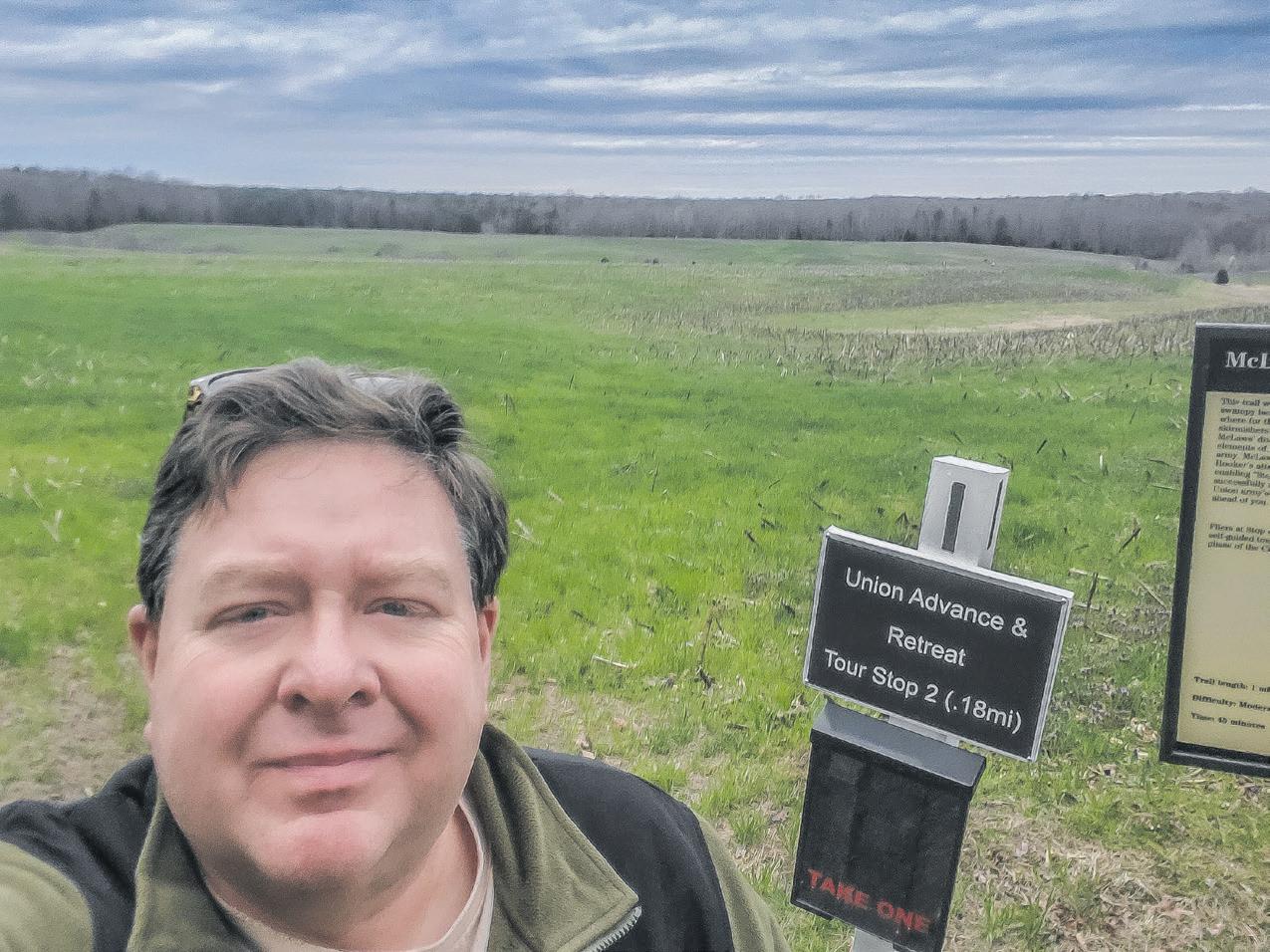
A couple months ago my weekend adventures brought me to the fields of First Day Chancellorsville. This pristine tract of land tells the story of the opening shots and fighting on May 1, 1863. Central Virginia Battlefields Trust worked with American Battlefield Trust in 2004 to save 134 acres of this area. When people zoom by this battlefield on Route 3, they might notice some changes in topography, but walking the ground gives an entirely different perspective, particularly if moving west from the parking area. There’s a hill that the Confederate charged, and every time I walk it, I still wonder why the Union isn’t still sitting at the top. It’s a solid defensive position! Looking at the topography gives the chance to reevaluate Civil War leadership (or lack thereof). On May 1, Union General Joseph Hooker made the decision to pull back his troops, but I can’t help wondering if the battle could’ve been very different if he had more fully explored the defensive high ground initially held by his men on that day. One army overcame while another gave up its advantage.
More recently, I explored McLaws’ Wedge—a 99-acre tract located south and east of the National Park Visitor Center at Chancellorsville. In 1998, CVBT saved this land as one of their earliest preservation projects, and the ground has since been turned over to the National Park Service for continued preservation and interpretation. Here, again, with my boots on the ground, I see how topography influenced and changed the battle. At first it seems like “just a big old field,” but then a deep valley slopes across the land, creating high ground that Federal troops could’ve held to their advantage.
Could’ve is a word packed with hindsight and judgement, I know. Looking closer at the battlefields and the history, I can take in the

big picture critically, but I don’t lose my understanding of what it must have been like for the men who fought here. These soldiers had to overcome the challenges of the land with daring and bravery. As I walk the land, I feel a greater connection to those men and what they did here. I think about the lessons that I learned during my days in the National Guard and have great admiration for what those soldiers, Blue and Gray, did so many years ago. Appreciation seems like too small a word. Admiration begins to sound like hero-worship. I’m a guy with a military background, library of books, and a lot of nonprofit executive experience, how do I find the right words? But maybe it’s not the words that matter so much. Maybe it’s the actions that count instead. Afterall, it wasn’t the words Lee and Jackson spoke at the bivouac site that are remembered; it was the bold actions that came from their meeting. Jackson’s march on May 2 and the crushing attack against the Union army right flank. The actions which came from that meeting cannot be underestimated.
By helping to preserving the hallowed ground of Central Virginia’s battlefields, we ensure the opportunity for each generation to come walk the topography, gain a greater understanding of the history, ponder leadership, courage, and resolve. I’m very happy to read history in a book, but to taking that knowledge and walking the land brings a whole new level of commitment to seeing the story of our pasts as a nation and as humanity.
Perhaps Winston Churchill said it best after he explored Central Virginia’s battlefields in 1929: “Destiny pivoting here has stamped the ground with a ruthless heel; the path of the world takes a different turn henceforward.” When I walk the battlefields, it strengthens my resolve to save the hallowed ground where history changed.
Central Virginia Battlefields Trust saves Civil War battleground to preserve the memory and meaning, sacrifices and stories of the men who fought at Fredericksburg, Chancellorsville, the Wilderness, and Spotsylvania. Learn more: www.cvbt.org

44 Civil War News May 2020 — MAKER — LEATHER WORKS Museum Quality “Raising The Standard” Made In The USA Visit us at www.DellsLeatherWorks.com • (845) 339-4916 Dedicated to the Common Soldiers Who Fought in The War Between The States AUTHENTIC QUALITY REPRODUCTIONS 31st Edition Since 1999 Accepting Discover, Visa, MasterCard and American Express
Terry Rensel, Executive Director of Central Virginia Battlefields Trust, enjoys a weekend hike at McLaws’ Wedge on Chancellorsville Battlefield.
The Lee-Jackson Bivouac Site is preserved within the National Park boundaries.
Boyle, Gamble & MacFee Belt and Plate
 by Shannon Pritchard
by Shannon Pritchard
There are no maker marked Confederate made belt buckles, but there are a rare few buckles whose makers are known. So how are the few whose maker is known, identified? It comes back to the sword. Whenever a sword was purchased, whether by government contract for cavalry swords, or an officer’s private purchase, the sword came with a belt. The belt was absolutely necessary, so collectors have identified various Leech and Rigdon buckles by their association with Leech and Rigdon swords. The College Hill two piece sword belt buckle, the Thomas, Griswold &

belt buckle, the Firman & Sons navy buckle, and the Haiman two piece buckle were all identified by the swords associated with them. Considering that the many various patterns of Confederate buckles exist, these few that are identified are a painfully small group. Due to a recent discovery one more can be added to this small list of maker identified
buckles and plates.
Virtually nothing was known of the rarity 10 plate identified as 118 in Steve Mullinax’s Confederate Belt Buckles and Plates, Expanded Edition. It was described simply as “CSA” mounted on a raised oval and all solid cast. It was noted that the illustrated example was dug in Chesterfield, Va.

In 2015, the sword and belt of Lieutenant Edward R. Cryer was purchased from a family in Texas. The sword was a Boyle, Gamble & Macfee foot officer’s pattern with the earliest style Boyle & Gamble mounts on the leather scabbard. This dates it to 1861 which fits right in with Cryer’s history. Edward R. Cryer entered service in what would become Company D, 2nd Tennessee Infantry, at Hartsville, Tenn., April 25, 1861, as a 2nd lieutenant. The Second was heading to Virginia, and May 14 found Lieutenant Cryer in Lynchburg, Va.
A newly minted lieutenant, Cryer was no doubt anxious to get a sword. Whether he acquired the Richmond-made sword in Lynchburg or in Richmond is unknown, but I would guess the latter. The regiment received its baptism of fire at Aquia Creek, Va., on June 1, 1861, and was present at the Battle of Manassas on July 21, 1861. On Feb. 9, 1862, Cryer’s regiment was transferred to the Western Theatre’s Army of Tennessee. Lieutenant Cryer was killed during the first day’s fighting at Shiloh.
There are precious few of these rare Boyle, Gamble & Macfee CSA plates known; this is the only one still retaining its numbered, matched, original keeper; both plate and keeper are numbered 27. It is the only known example still on its original patent leather over cotton webbing belt.

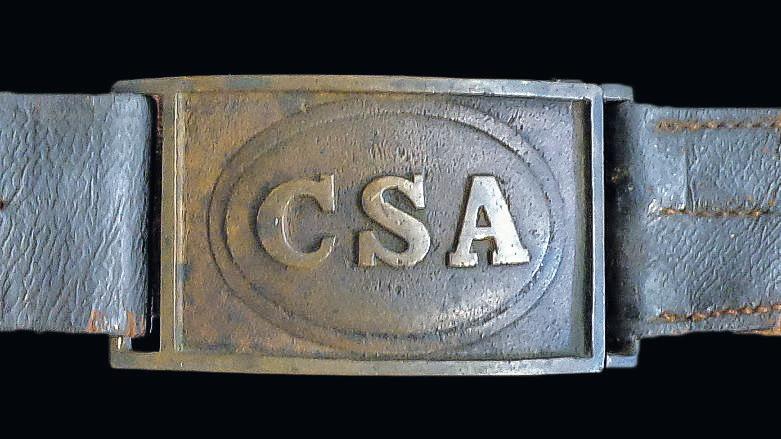
Shannon Pritchard has authored numerous articles relating to the authentication, care and conservation of Confederate antiques, including several cover articles and is the author of the definitive work on Confederate collectibles, the widely acclaimed Collecting the Confederacy, Artifacts and Antiques from the War Between the States, and is co-author of Confederate Faces in Color.
The Gettysburg Edition for 2020
in shops, restaurants, and other businesses in downtown Gettysburg. It will be available for free viewing online at CivilWarNews.com which has over 300,000 visitors per year. The online version will have clickable hyperlinks which will automatically redirect the reader to the advertiser’s website. The July issue will also be posted on the Civil War News Facebook page which has almost 75,000 likes.
We hope that you will accept our invitation to advertise in the 26th annual July Gettysburg section of the Civil War News. This year we are printing 12,000 copies of the Gettysburg Edition, in full color, which will be mailed to Civil War News subscribers but also delivered to shops, lodging, restaurants, historic homes, Civil War dealers, auction houses, libraries, battlefield parks, and museums for free distribution in downtown Gettysburg. It will also be handed out at the Gettysburg Battlefield Preservation Association’s 47th Annual Civil War Show June 27-28 and at the 157th Anniversary of the Battle of Gettysburg with Battle Reenactments, Artillery and Cavalry Demonstrations, Living History Programs, Tours of the Restored House & Barn, and more! We are working on getting it distributed to other big venues in Gettysburg as well. The reenactment will be staged on the hallowed ground of the GBPA’s 146 –acre Daniel Lady Farm located on Hanover Road with a large reenactment field bordering the Gettysburg National Military Park at Benner Hill.

In addition to the Gettysburg Edition being free to the public

Please contact us at 800777-1862 or email ads@civilwarnews.com for questions, a copy of our rate sheet which includes the pricing and ad size specs for this special issue, or to reserve your ad space. Deadline is May 20th for ad reservation and May 31st for materials deadline.
If you choose not to participate, but are located in Gettysburg, and would like copies of the Gettysburg section to distribute, please contact me and I will make certain that you receive a box. We look forward to hearing from you!

The 2020 Civil War Dealers Directory is out. To view or download a free copy visit: www.civilwardealers.com/ dealers.htm

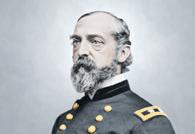
45 May 2020 Civil War News HORSE SOLDIERING IN GETTYSBURG CAPTAIN JASPER MUSE’S SWORD GETTYSBURG PHOTO ALBUM GARDNER AND BRADY PHOTOS CHANGED THE MODERN GETTYSBURG BATTLEFIELD BREAKING NEWS: BIG BATTLE IN PENNSYLVANIA PARDONED FOR MURDER Courtesy of Civil War News FREE www.CivilWarNews.com INSIDE THIS ISSUE: 2019
Company patterns, the Boyle and Gamble oval two piece sword
The fine patent leather was inlaid with a linen belt to give it strength and durability. (OldSouthAntiques.com)
The ultra rare Gamble & MacFee belt plate.
The solder filed down the keeper to give the buckle a little bit of room to swivel.
The sword by Boyle, Gamble & MacFee that was sold with the belt.
“The best little book on Barnard”
The American Civil War was the rst war in which both sides widely used entrenchments, repeating ri es, ironclad warships, and telegraphed communications. It was also the rst American War to be extensively photographed. Mathew Brady, Alexander Gardner and Timothy O’Sullivan are famous for having made iconic photographs in the Civil War’s eastern theater. George N. Barnard deserves to be ranked in this top tier for his photographic work in the war’s western theater. A civilian photographer hired by Gen. William T. Sherman’s chief engineer to take pictures of forti cations around Atlanta, Barnard took several hundred of them in and around the city in the fall of 1864. His most famous is the site of Union Maj. Gen. James B. McPherson’s death in the battle of Atlanta, July 22, 1864. Thus far, no comprehensive, de nitive listing has been made of the photographer’s work. For this book we have chosen a hundred images we deem “signi cant.”


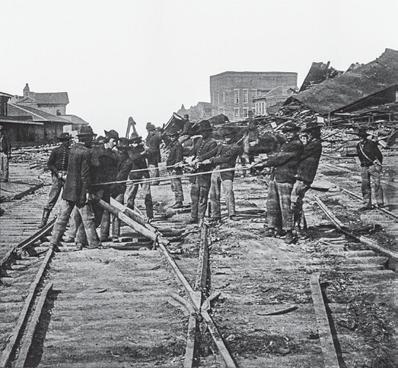


Ordering info: $19.95 plus $3.50 s&h South Carolina residents add 9% sales tax
Mail a check to: Historical Publications LLC 520 Folly Road, Suite 25 PMB 379 Charleston, SC 29412



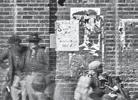






or Order online at www.historicalpubs.com

46 Civil War News May 2020 “The STORIES BEHIND THE PICTURES” 100 Significant Civil War Photographs CHARLESTON IN WAR
Stephen Davis & JACK W. MELTON JR Name Shipping Address City State Zip 160 pages • OVER 100 PHOTOS • MAPS • INDEX • BIBLIOGRAPHY • ISBN: 978-1-61850-167-7 Paperback: $19.95 (+$3.50 S & H) • Released Jan. 2020 3 ways to order YOUR COPY! CALL US 800-777-1862 ORDER ONLINE www.historicalpubs.com fill out this form BELOW & mail with a check for $23.45 to: Historical Publications LLC 520 Folly Road, Suite 25 PMB 379, Charleston, SC 29412 (S.C. residents include 9% sales tax of $1.80) newly Barnard and Charles photograph, selected as e Great Fire allow book are Confederates Harbor Reminiscences of Federal history historical works. such as (1838–1910). DAVIS & MELTON 100 SIGNIFICANT CIVIL WAR PHOTOGRAPHS CHARLESTON IN THE WAR
By
128 page Paperb ac k: $19.95 (+$3.50 S & H)
Wrecking Atlanta Northern Engineers Prying Up Track the right—leading one to deduce that this picture was taken on the afternoon November Battles and series the 1880s. When the men the 1st Missouri Engineers (oneofPoe’s twoengineerregimentsatAtlanta)sawtheTaberillustration,theyapparentlyrecognized made by them for the purpose.” for Monday, November 7. Freedpeople on the Boxcars Library of Congress. scrutinize the pictures and compare them to others. In identifying these kinds scenes, viewers look for telltale clues. One the most important inthesetofpicturestakenatBatteryKisthetreeinthecenter,whichConfederateshadleft Confederate Lt. Col. Bushrod W. Frobel, assistant chief engineer in Hood’s army, called this“thePeachtreestreetbattery.”InhisdiaryentryforAugust14,1864,heremarkedon Peachtree Battery–Another View Buying, Selling and Brokering Jack Melton 520 Folly Rd, Suite 25 PMB 379 Charleston, SC 29412 jack@jackmelton.com 843-696-6385 Let me help connect you with a buyer or seller. I specialize in cannon, projectiles, fuses and wrenches, implements, sights, gunner’s equipment, tools, and other artillery related equipment. From single items to collections. Finders Fees Paid. Purveyor of Original Artillery Items Order these books online at www.HistoricalPubs.com
Trivia Answers
Civil War News – 12 Issues Per Year
$38.50 - 1 year USA Print
$48.50 - 1 year USA Print & Digital $66 - 2 year USA Print
$86 - 2 year USA Print & Digital $29.95 - 1 year Digital only Payment Enclosed
Charge my: Discover MasterCard Visa
Terms and Conditions
The following terms and conditions shall be incorporated by reference into all placement and order for placement of any advertisements in Civil War News by Advertiser and any Agency acting on Advertiser’s behalf. By submitting an order for placement of an advertisement and/or by placing an advertisement, Advertiser and Agency, and each of them, agree to be bound by all of the following terms and conditions:
1. All advertisements are subject to acceptance by Publisher who has the right to refuse any ad submitted for any reason.
2. The advertiser and/or their agency warrant that they have permission and rights to anything contained within the advertisement as to copyrights, trademarks or registrations. Any infringement will be the responsibility of the advertiser or their agency and the advertiser will hold harmless the Publisher for any claims or damages from publishing their advertisement. This includes all attorney fees and judgments.
3. The Publisher will not be held responsible for incorrect placement of the advertisement and will not be responsible for any loss of income or potential profit lost.
4. All orders to place advertisements in the publication are subject to the rate card charges, space units and specifications then in effect, all of which are subject to change and shall be made a part of these terms and conditions.
5. Photographs or images sent for publication must be high resolution, unedited and full size. Phone photographs are discouraged.
6. At the discretion of Civil War News any and all articles will be edited for accuracy, clarity, grammar and punctuation per our style guide.
7. Articles can be emailed as a Word Doc attachment or emailed in the body of the message. Microsoft Word format is preferred. Email articles and photographs: mail@civilwarnews.com
47 May 2020 Civil War News Advertisers In This Issue: 100 Significant Civil War Photographs: Atlanta 41, 46 100 Significant Civil War Photographs: Charleston 35, 46 American Battlefield Trust 7 Ace Pyro LLC 21 Artilleryman Magazine 8 Brian & Maria Green 4 Civil War Guru 39 CS Arms 21 Civil War Artillery – The Half Shell Book 27 CWMedals.com, Civil War Recreations 4 Civil War Navy Magazine 11 Civil War News 36 Civil War Shop – Will Gorges 8 College Hill Arsenal – Tim Prince 28 Dell’s Leather Works 44 Dixie Gun Works Inc. 17 Fugawee.com 25 Georgia’s Confederate Monuments – Book 33 Gettysburg Foundation 8 Greg Ton Currency 21 Gunsight Antiques 11 Harpers Ferry Civil War Guns 11 The Horse Soldier 4 Jack Melton Artillery Broker 46 James Country Mercantile 17 Jeweler’s Daughter 5 Le Juneau Gallery 11 Mike Brackin 11 Military Images Magazine 30 National Museum of Civil War Medicine 33 North South Skirmish Association 37 Owens & Ramsey Book Sellers 39 Panther Lodges 25 The Regimental Quartermaster 11 Richard LaPosta Civil War Books 38 South Carolina Confederate Relic Room 37 Suppliers to the Confederacy – Book, Craig Barry 16 Ulysses S. Grant impersonator – Curt Fields 11 University of Tennessee Press 21 Events: American Digger Chattanooga Civil War Show 5 MKShows, Mike Kent 3, 35 Morphy’s Auctions 9 Poulin Auctions 48
c c c c c c
NAME ADDRESS ADDRESS CITY STATE ZIP CODE EMAIL
Check
Card # Exp. Date Security Code Name on
New Renewal c Make checks payable to Historical Publications LLC. c c c c
#
Card
for digital subscription) USA Subscriptions Only No Canada or International Mail to: Historical Publications LLC 520 Folly Road, Suite 25 PMB 379, Charleston, SC 29412 Deadlines for Advertising or Editorial Submissions is the 20th of each month. Email to ads@civilwarnews.com Subscribe online www.CivilWarNews.com Digital Issues of CWN are available by subscription alone or with print plus CWN archives at CivilWarNews.com PHONE Required 800-777-1862
(required
1. Corinth 2. Joshua L. Chamberlain
3. Patrick R. Cleburn
4. Champion Hill
5. Chambersburg
6. Columbiad
7. Casco Class
8. Alonzo Cushing (his brother was William)
9. John Chivington
10. USS Camanche





























































 by Joe Bilby
by Joe Bilby































 by Frank Tomasello
by Frank Tomasello










 by Professor Earnest Veritas Special Correspondent to the Civil War News -Western Theater-
by Professor Earnest Veritas Special Correspondent to the Civil War News -Western Theater-



















































 – William F. Keeler, Assistant Paymaster, USS Monitor
– William F. Keeler, Assistant Paymaster, USS Monitor































 by Bob Ruegsegger
by Bob Ruegsegger




























































 By Kevin M. Levin. Photos, notes, bibliography and index, 240 pp. University of North Carolina Press, 2019. Hardbound. $30.00.
By Kevin M. Levin. Photos, notes, bibliography and index, 240 pp. University of North Carolina Press, 2019. Hardbound. $30.00.
 H. Bogart
H. Bogart














































































































































 by Shannon Pritchard
by Shannon Pritchard






























